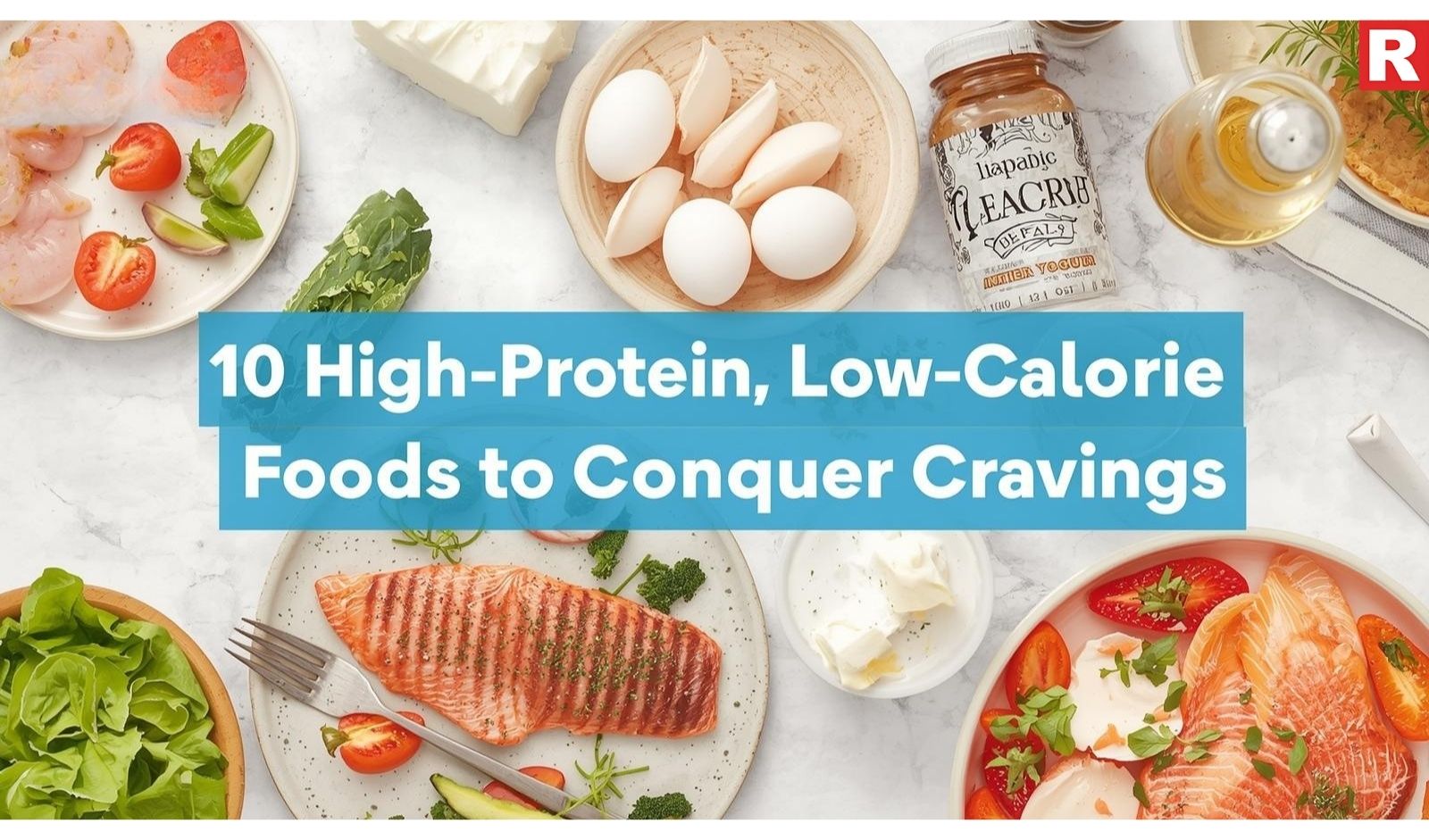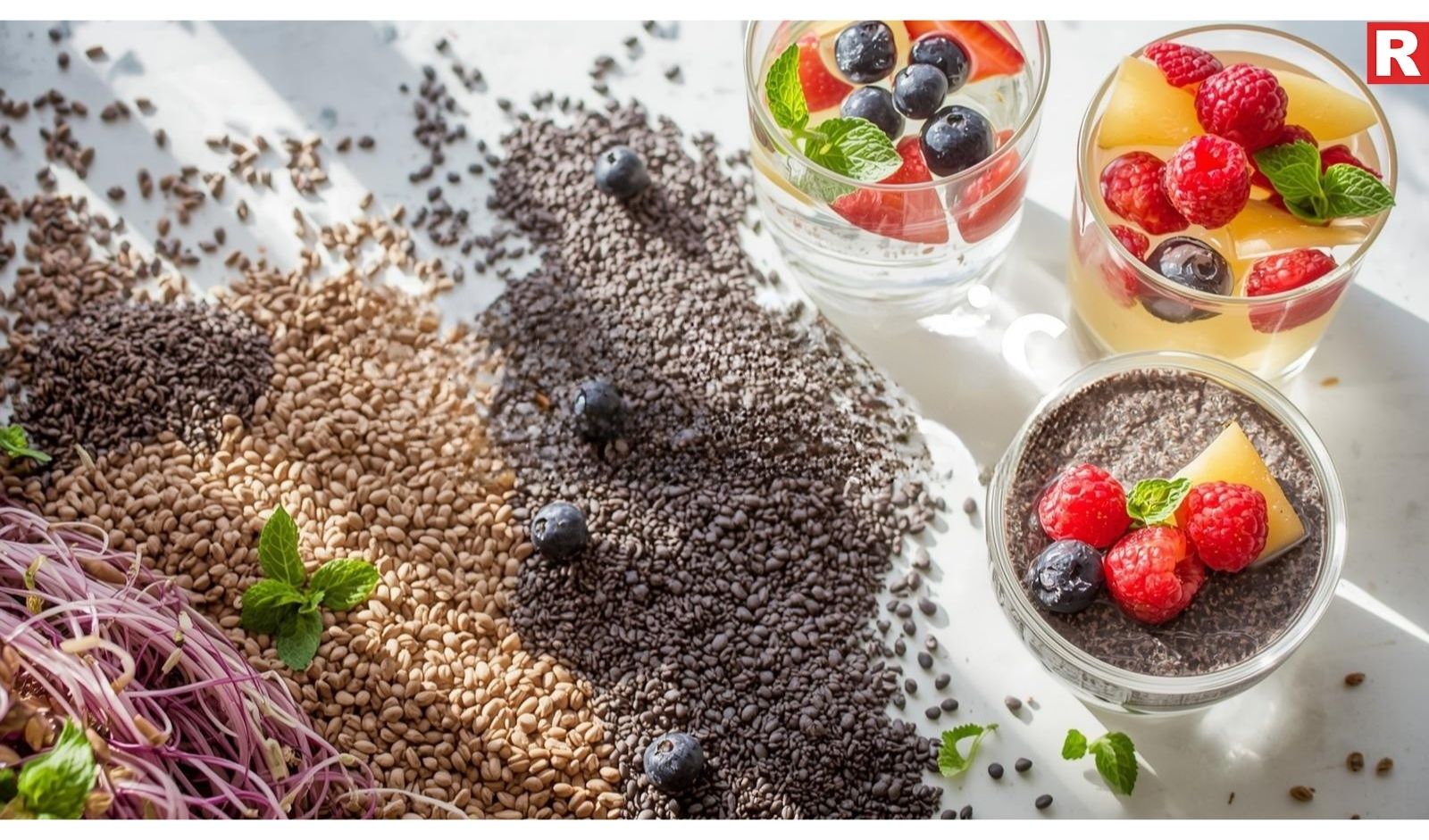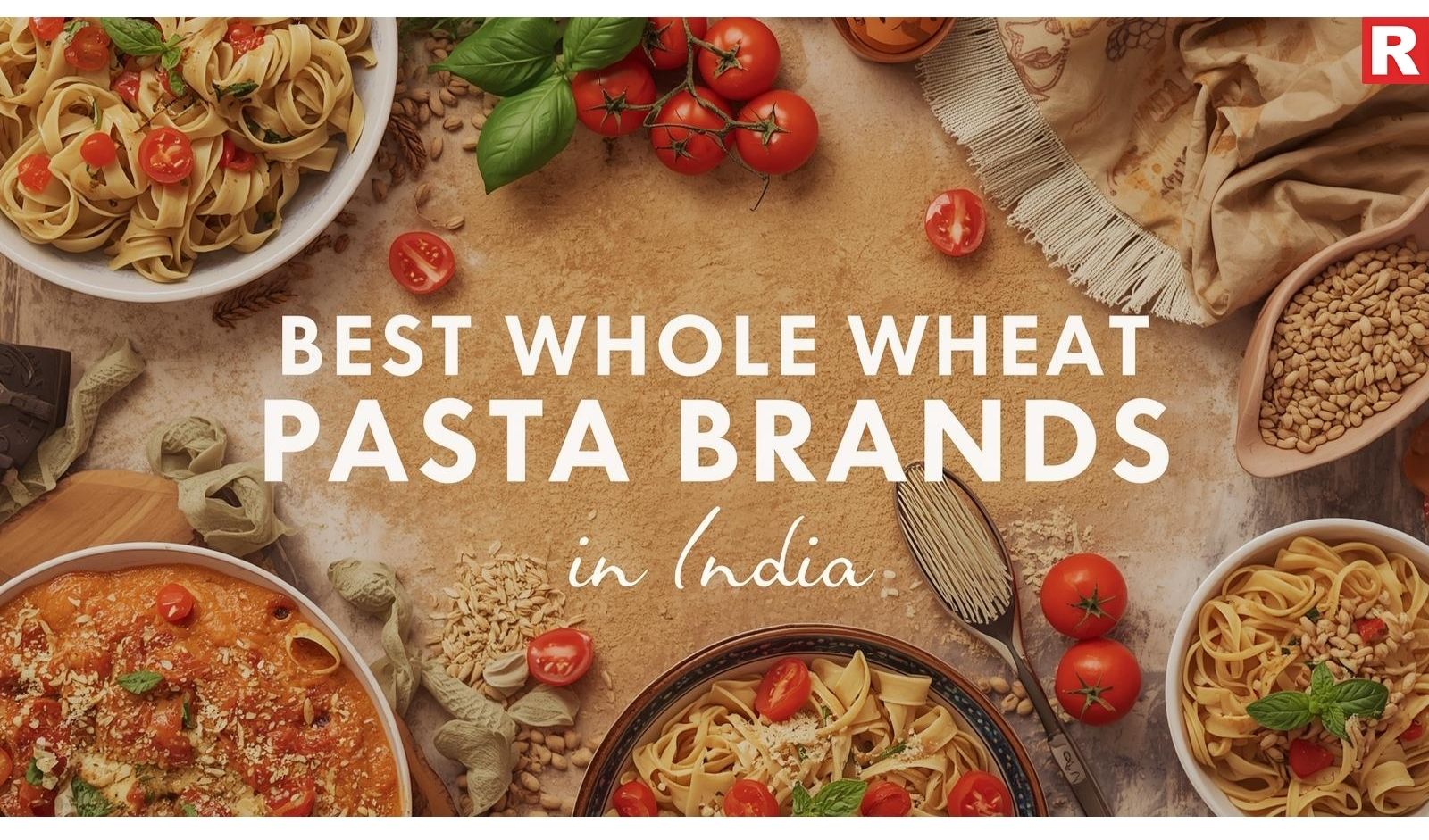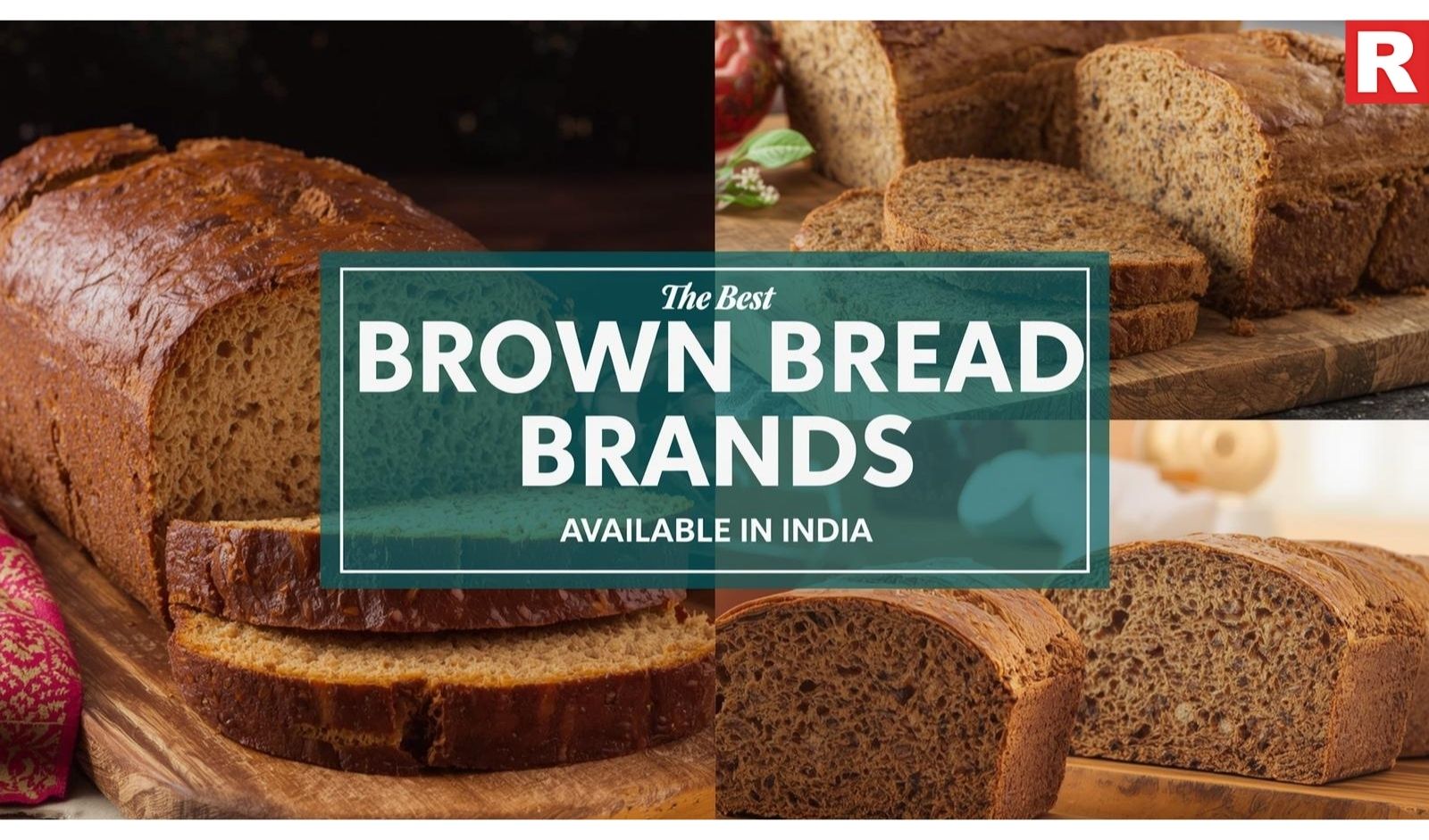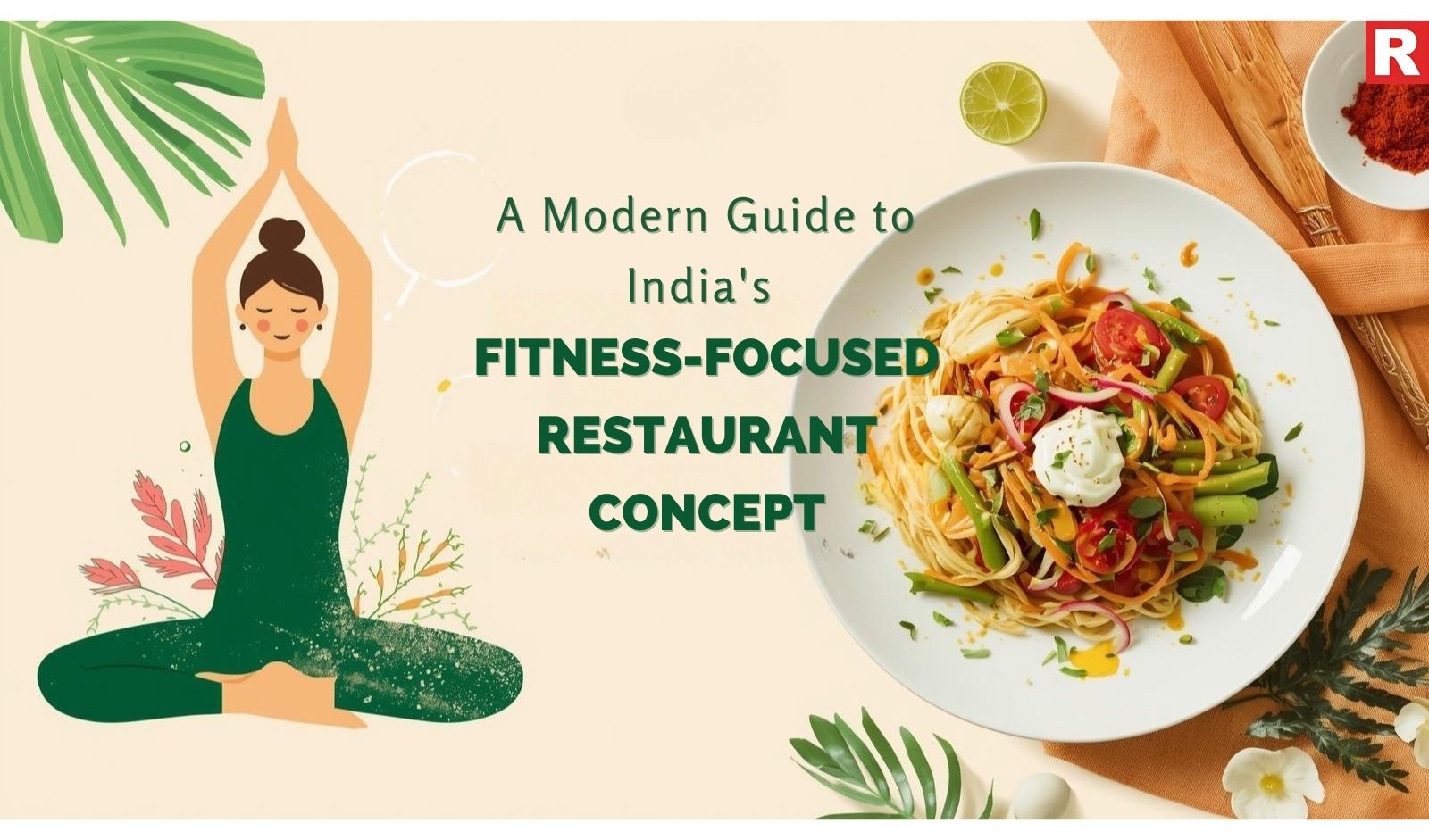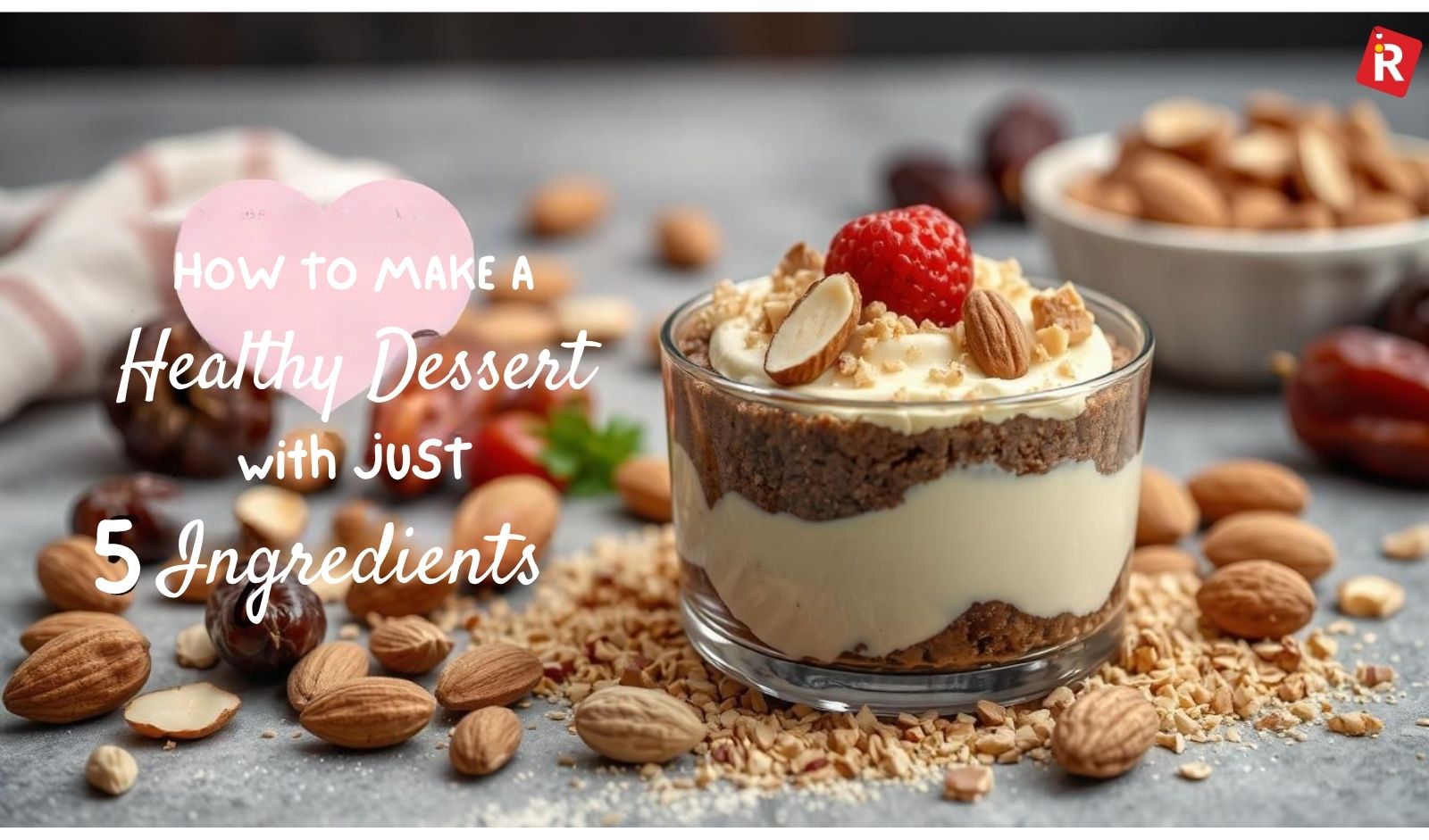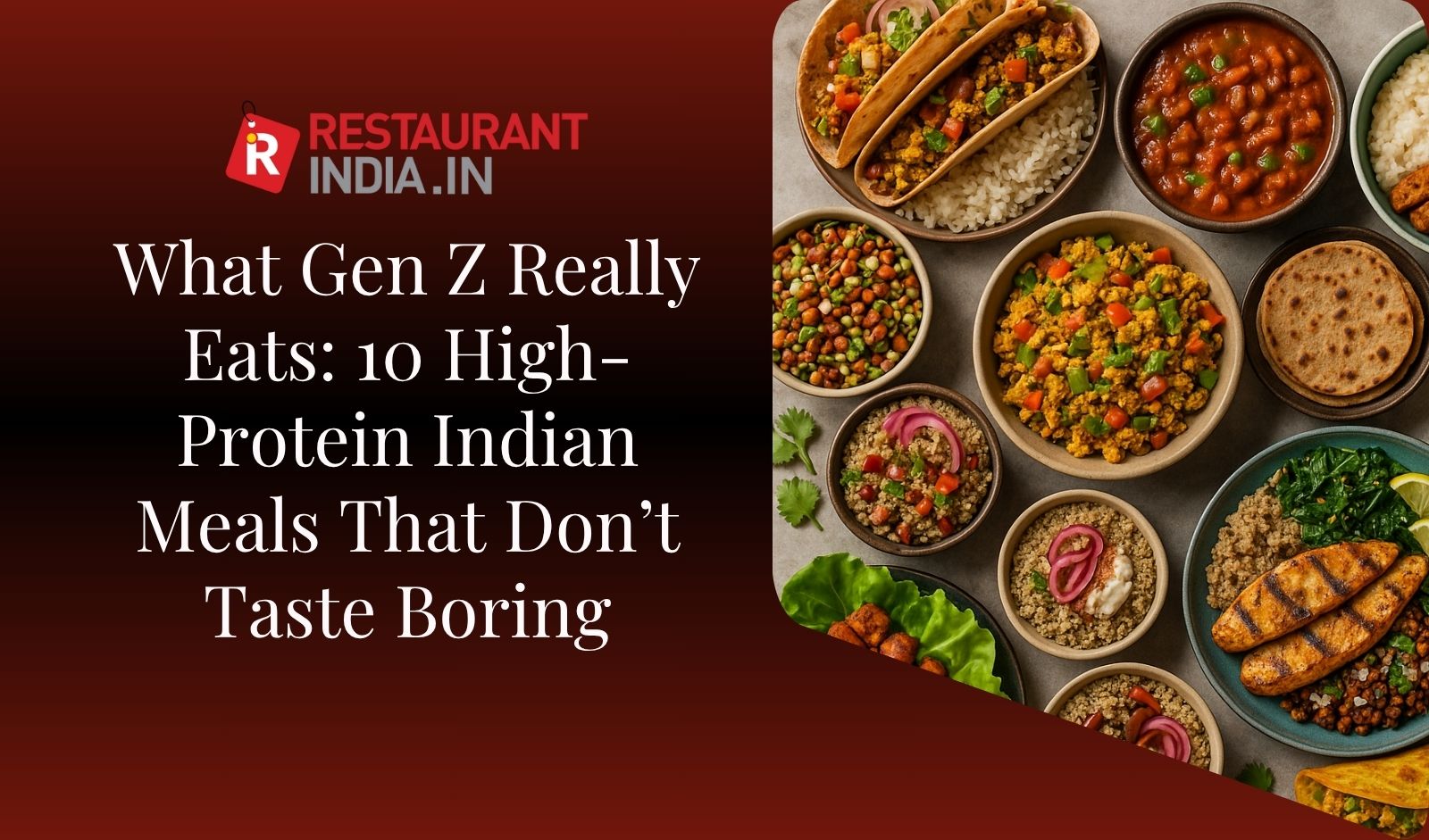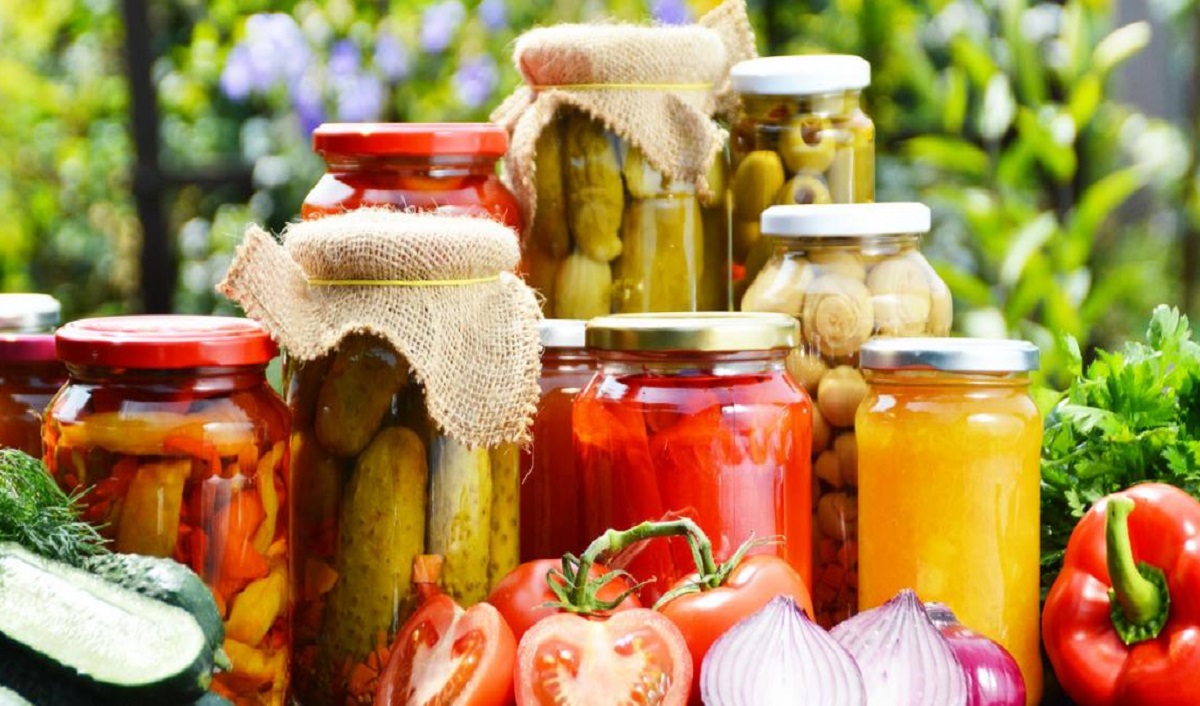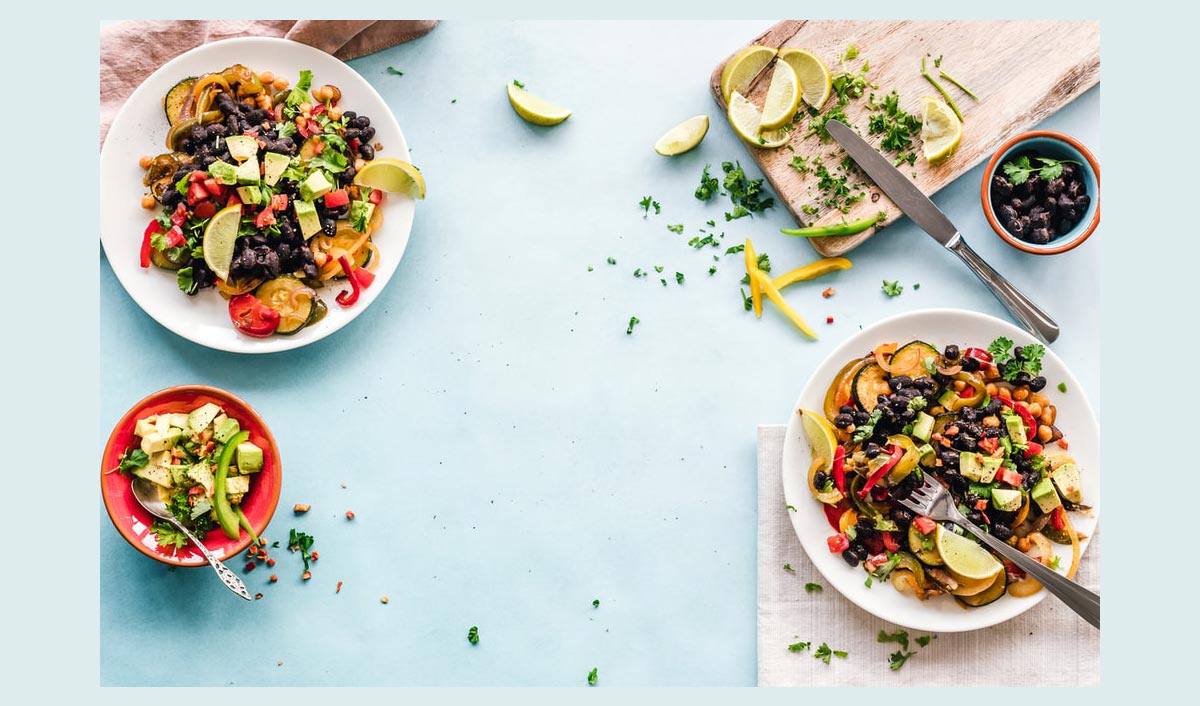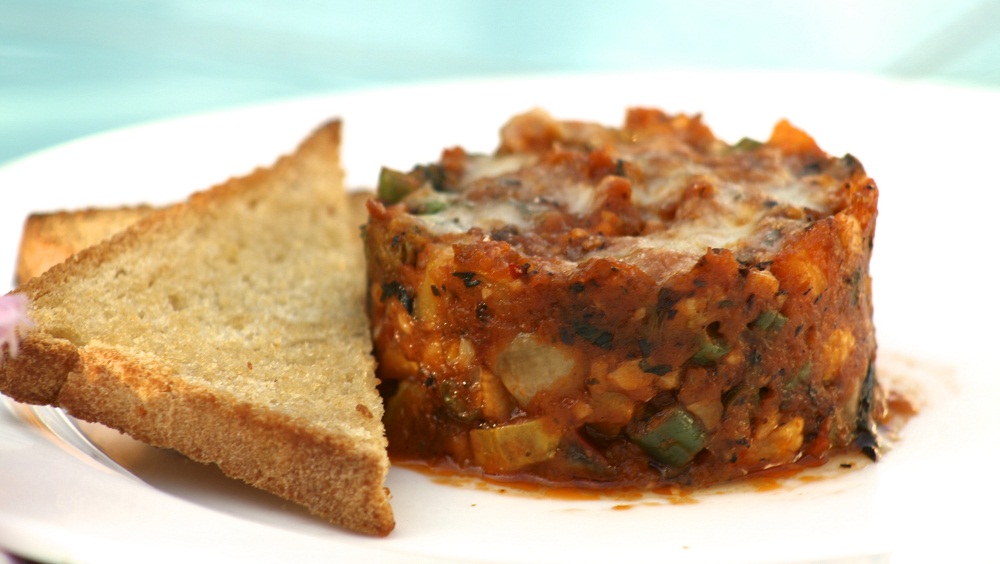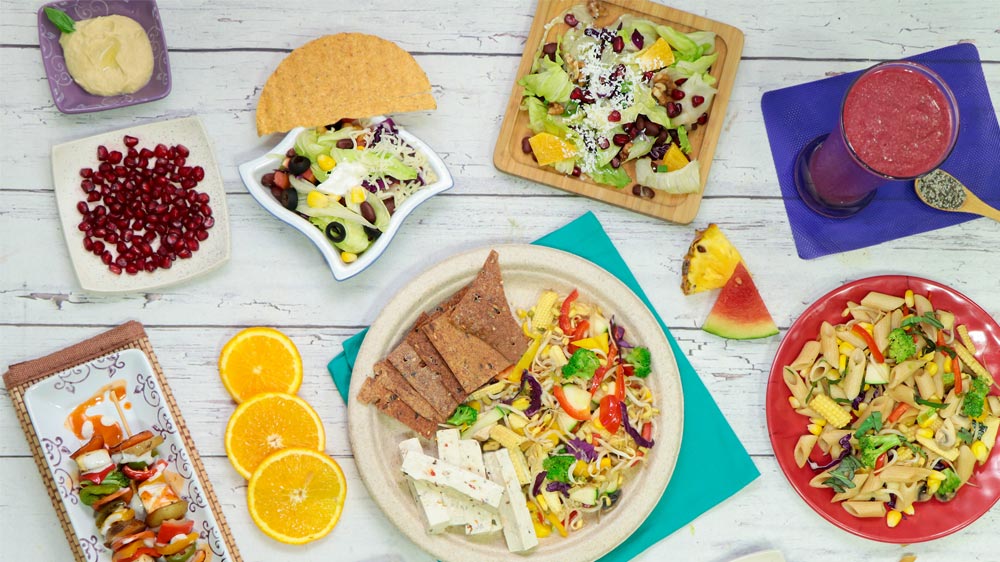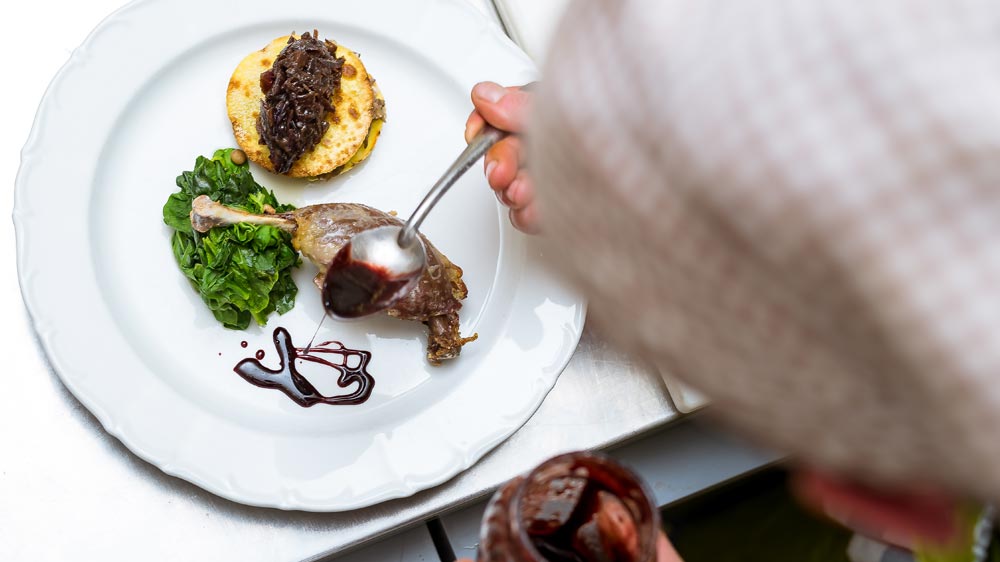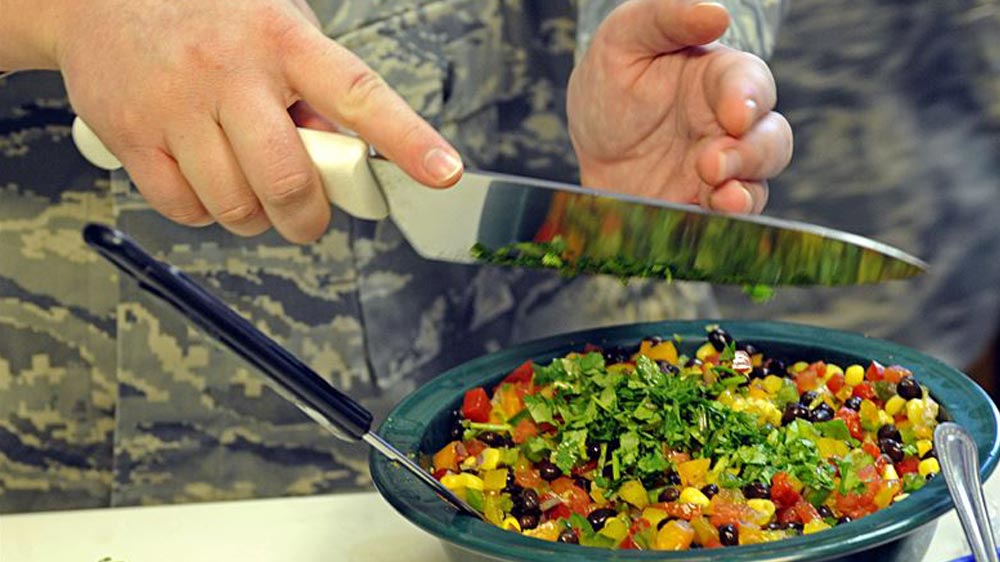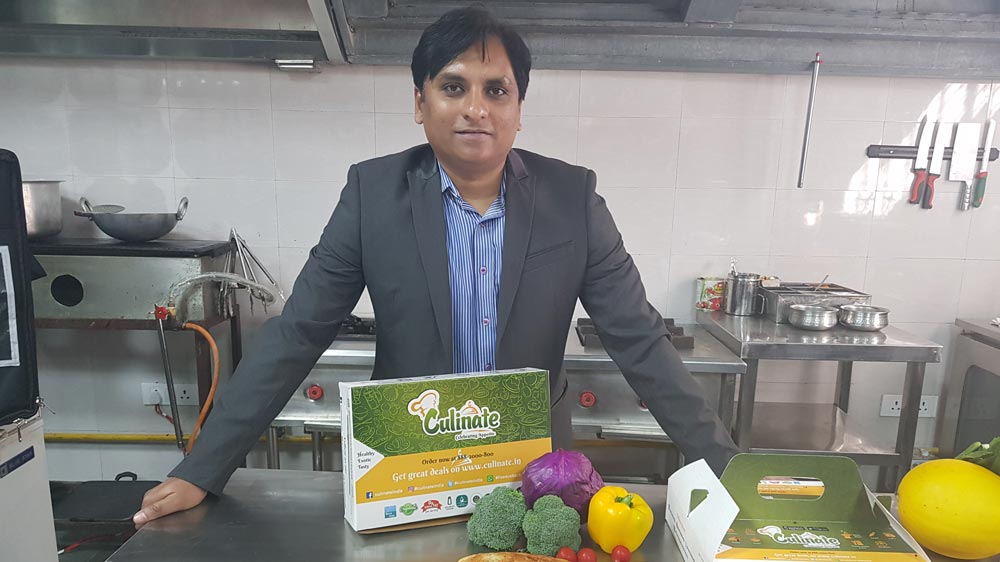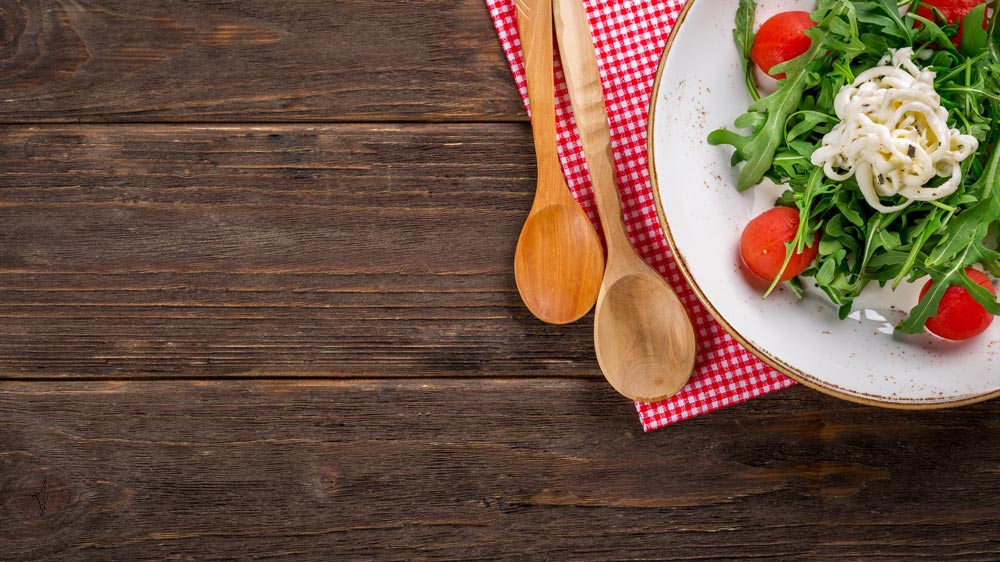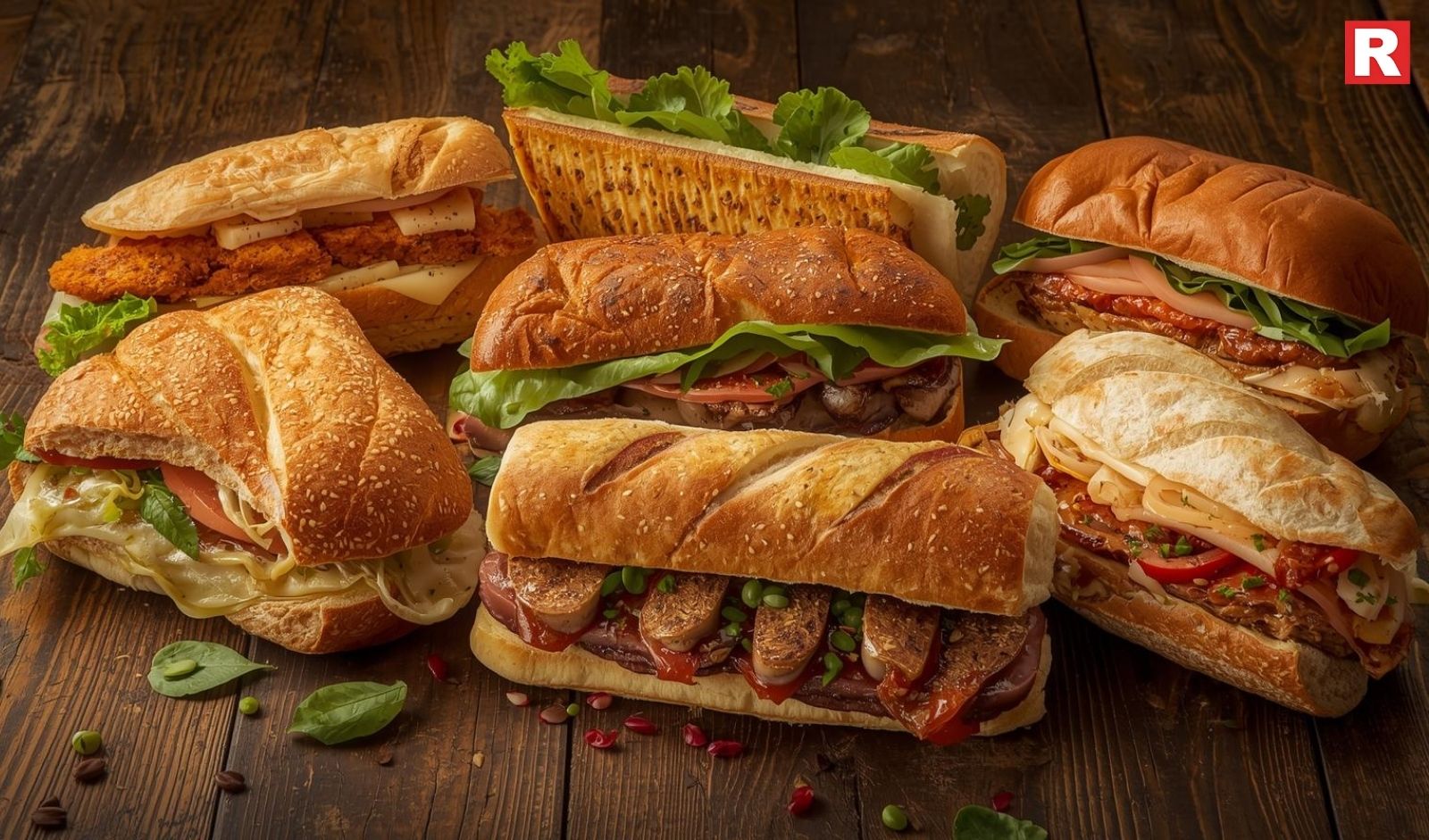
Working towards a healthier lifestyle, but cravings keep coming your way? Don’t worry. This happens to the best of us. When you start any diet or exercise, then it might be that sometimes crave something sweet or junk food. The desire to eat something sweet, salty, or even a fulfilling meal can hinder your diet, and sometimes it also leads to overeating that might just ruin your plans. In such a case, progressing towards weight management or completing fitness goals becomes an impossible dream. But what if we tell you that there is a way to control your cravings without compromising on flavor or eating less? There have always been certain food items that can help you conquer your cravings.
The secret to this lies in high-protein, but low-calorie food items that can help to put a stop to cravings without compromising on taste. Protein, which is a macronutrient, is known for its ability to promote fullness, which helps you to feel full much longer. And if you also eat low-calorie food items, then this becomes the ultimate weapon for you to manage hunger and live a healthier life. In this article, we will be talking about 10 food items that are not only low in calories, but also with protein, that can help you to put a stop to your cravings.
What are cravings?
Cravings, as opposed to general hunger, are strong, targeted desires for a certain food. The reward system in the brain is primarily responsible for them.
The brain releases the "feel-good" chemical dopamine when we eat highly appetizing foods that are heavy in fat, sugar, or salt. Our brains are conditioned to seek out those meals again as a result of the strong reward signal this produces. Emotional states, hormone changes, or even environmental signals like a certain fragrance or image might cause this reaction.
Read more: Top 8 Must-Try Sandwiches from Around the World
Why Protein is Your Secret Weapon Against Cravings

Before we look at the food items, let’s get to know the reason why protein is so good at managing cravings:
- Satiety: Protein is the macronutrient that satisfies hunger the most. It causes the release of hormones that tell your brain that you're full, which lowers your appetite in general.
- Thermic Effect: Compared to fats and carbs, protein has a larger thermic effect of food (TEF). This implies that digesting and metabolizing protein requires more energy (calories), which gradually increases your metabolism.
- Muscle Preservation: Eating enough protein with a lack of calories aids in the preservation of lean muscle mass, which is essential for a healthy metabolism.
- Blood Sugar Stability: Protein reduces the rate at which sweets are absorbed into the blood, avoiding sharp spikes and falls that frequently result in reactivated cravings.
Let's now examine the foods that will enable you to manage your appetite.
The Top 10 High-Protein, Low-Calorie Foods to Conquer Cravings
1. Greek Yogurt (Plain, Non-Fat)

For anyone trying to boost their protein intake without consuming too many calories, Greek yogurt is a true superfood. It has a thicker, creamier texture and a significantly higher protein content than ordinary yogurt since the majority of the whey is strained off.
- Protein Power: Approximately 17-20 grams per 6-ounce serving.
- Calorie Count: Roughly 100-120 calories per 6-ounce serving.
- Bonus: Also rich in probiotics for gut health and calcium for strong bones.
Reducing Cravings: It is very fulfilling due to its high protein content and rich, creamy texture. When topped with fruit or honey, it can quell sweet cravings, and when used as a base for dips, it can satisfy savory cravings.
How to Enjoy: Eat it in a fruit and nut breakfast parfait, as a foundation for dips like tzatziki, as a savory snack when combined with herbs and spices, or as an alternative to sour cream.
Know more: Top Drinks You Should Consume to Get a Festive Glow
2. Chicken Breast (Skinless, Boneless)

Chicken breast is a classic for a reason: it's thin, versatile, and full of high-quality protein. It is the foundation of many nutritious diets.
- Protein Power: Around 25-30 grams per 3.5-ounce (100g) cooked serving.
- Calorie Count: Approximately 165 calories per 3.5-ounce serving.
- Bonus: Excellent source of B vitamins and essential minerals like phosphorus and selenium.
Reducing Cravings: It is a great option for sating hunger during mealtimes and avoiding post-meal snacking because of its meaty composition and high lean protein level.
How to Enjoy: Enjoy it grilled, baked, stir-fried, shredded in salads or sandwiches, or in a lean curry.
3. Eggs (Whole)
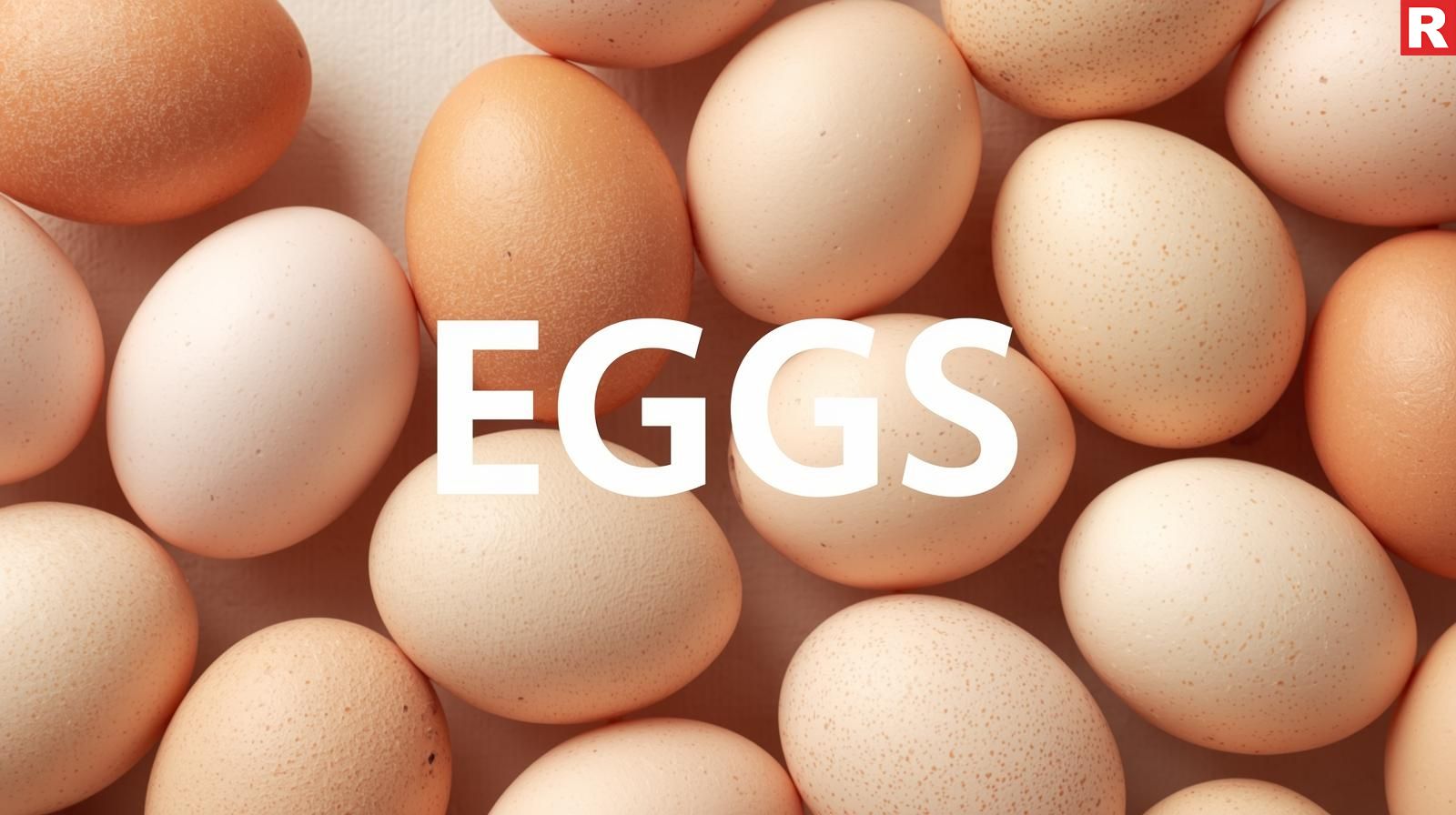
Frequently referred to as "nature's multi-vitamin," eggs are among the most comprehensive and readily absorbed protein sources. The current study supports its consumption in a healthy diet, despite previous concerns regarding cholesterol.
- Protein Power: 6 grams per large egg.
- Calorie Count: Around 70-80 calories per large egg.
- Bonus: High in vitamin D, choline for brain function, and potent antioxidants, including zeaxanthin and lutein, for eye health.
Reducing Cravings: Eggs are a great breakfast choice to avoid mid-morning snack assaults since their protein and healthy fats provide you with long-lasting energy and a feeling of fullness that lasts for hours.
How to Enjoy: Added to salads, omelets, frittatas, poached, scrambled, or boiled.
What's new: 10 Popular Energy Drinks and Their Benefits
4. Cottage Cheese (Low-Fat or Non-Fat)
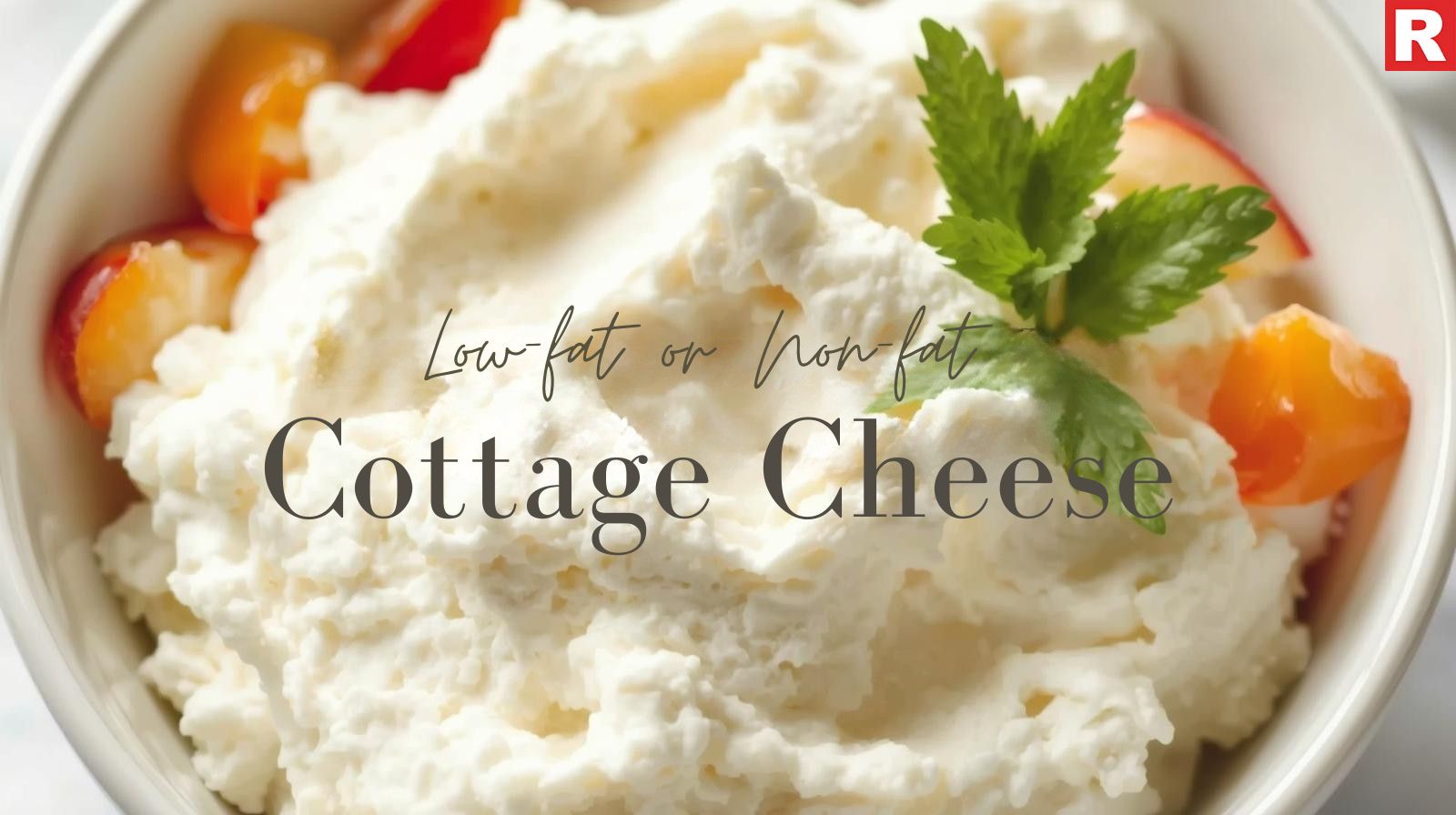
Despite being an outsider, cottage cheese is an excellent and reasonably priced source of protein, especially casein protein, which releases amino acids slowly and sustainably.
- Protein Power: Around 11-14 grams per 1/2 cup serving.
- Calorie Count: Approximately 80-100 calories per 1/2 cup serving.
- Bonus: Contains healthy probiotics and is high in calcium and phosphorus.
Reducing Cravings: It's slow-digesting casein protein that satisfies your hunger and is ideal as a pre-bedtime or mid-meal snack. Cravings for richness might also be satiated by the creamy texture.
How to Enjoy: Enjoy it as a high-protein spread on whole-grain bread, with fruit, and sprinkled with chives and black pepper. It can also be added to savory dips.
5. Skimmed Milk

Skim milk, sometimes referred to as fat-free milk, is milk that has had the cream (milkfat) extracted. As most of the fat (whey) is squeezed out, it is a low-calorie drink. Skim milk is a simple and reasonably priced classic that provides a clean, low-calorie protein boost. It's a fantastic post-workout recovery drink or a simple, satisfying snack because it's a great dose of casein and whey proteins.
- Protein Power: Approximately 8–9 grams per cup.
- Calorie Count: About 80–90 calories are included in a 1-cup portion.
- Bonus: An excellent source of potassium, phosphorus, and calcium—all of which are critical for heart and bone health.
Reducing Cravings: The combination of fluids and protein makes you feel hydrated and full. Additionally, it might sate desires for light, refreshing beverages or creamy textures.
How to Enjoy: It can be poured over cereal, combined with coffee or tea, used as a foundation for smoothies, or just consumed by itself.
6. Lentils

Lentils are a great food for anyone who wants to increase their intake of plant-based proteins or who follows a plant-based diet. They are affordable, high in fiber and protein, and quite adaptable.
- Protein Power: Around 9 grams per 1/2 cup cooked serving.
- Calorie Count: A half-cup cooked serving has about 115 calories.
- Bonus: Excellent source of manganese, iron, folate, and soluble and insoluble dietary fiber.
Reducing Cravings: The high fiber content and protein provide a potent satiating impact that helps stave off hunger for hours. They can also offer a hearty, comfortable feel.
How to Enjoy: as a side dish, in salads, veggie burgers, soups, and stews.
7. Tofu (Firm or Extra-Firm)
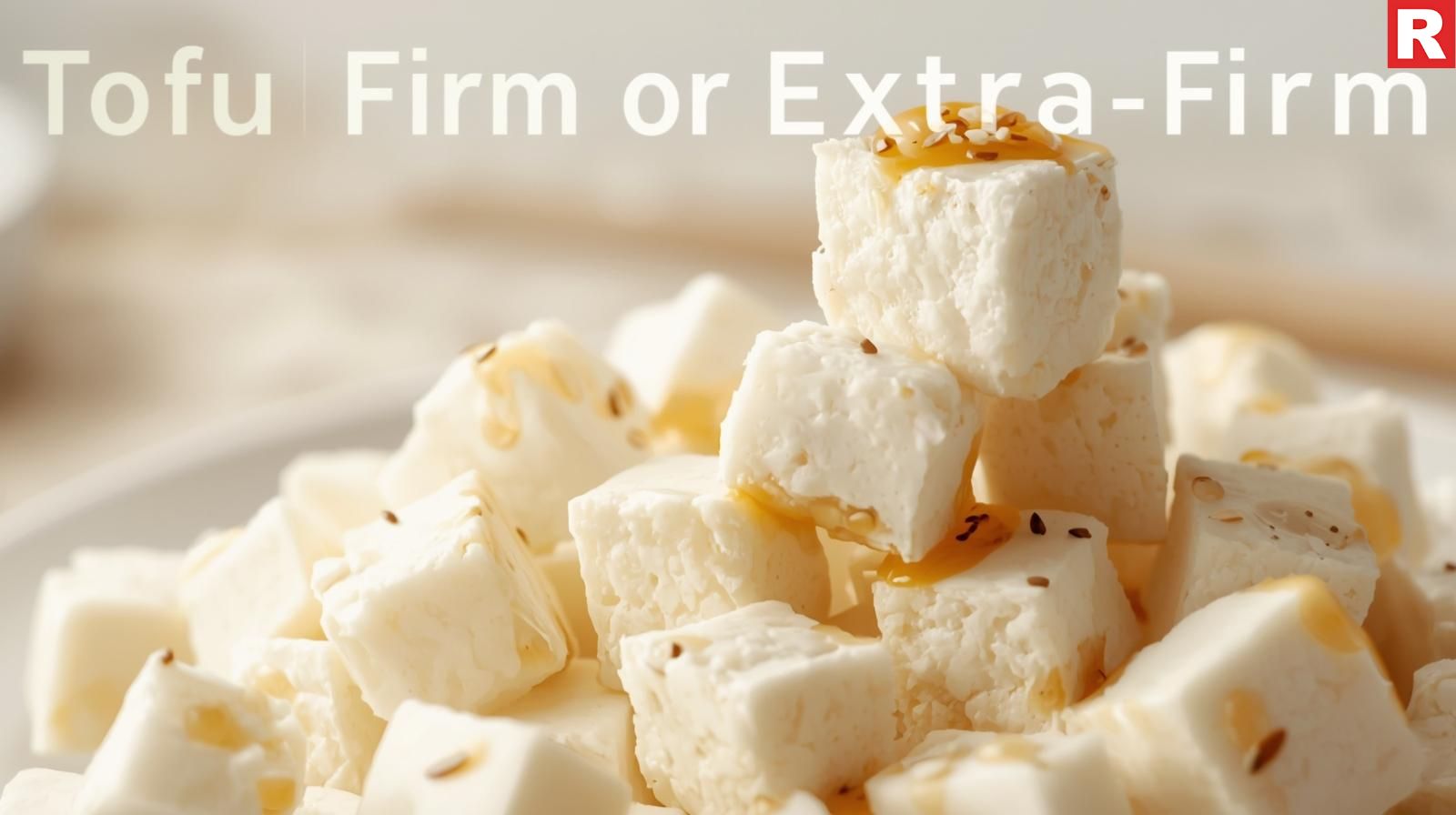
Made from soybeans, tofu is a staple plant-based protein. It offers a full protein intake and is highly adaptable, absorbing the flavors of whatever it is cooked with.
- Protein Power: Approximately 8-10 grams per 3-ounce (85g) serving.
- Calorie Count: Around 70-80 calories per 3-ounce serving.
- Bonus: Rich in manganese, iron, and calcium.
Reducing Cravings: When properly prepared and seasoned, its substantial protein content and solid texture make it satisfying. It's a fantastic option for a filling plant-based lunch.
How to Enjoy: Enjoy it stir-fried, grilled, roasted, scrambled (in place of eggs), or mixed into curries.
8. Chickpeas (Garbanzo Beans)
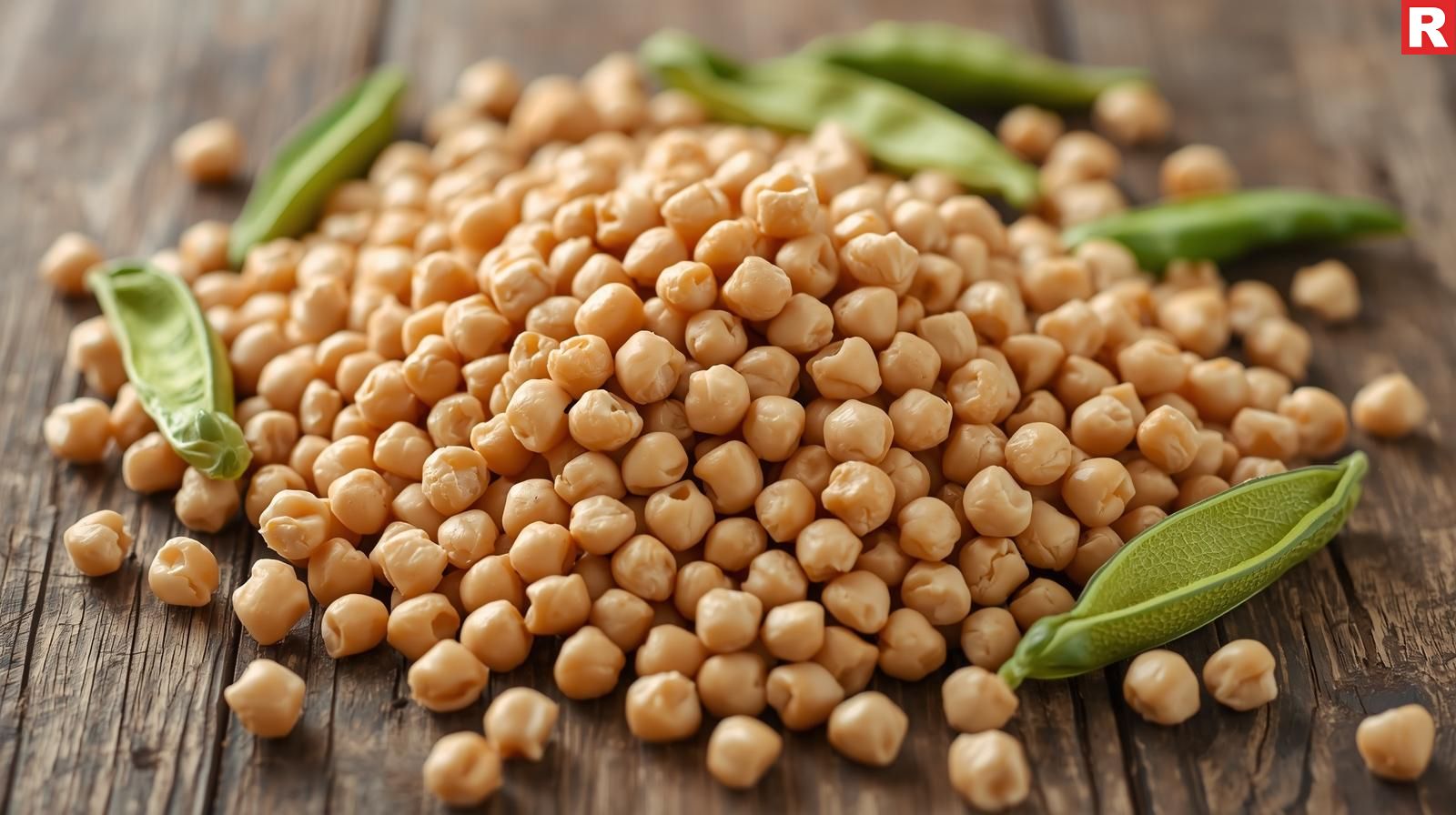
A staple of many plant-based diets, chickpeas are a versatile and nutritious bean. They provide a potent combination of fiber and protein, which makes them very good at promoting satiety.
- Protein Power: 7-8 grams per half-cup portion that has been cooked.
- Calorie Count: A half-cup cooked portion has about 130–140 calories.
- Bonus: High in iron, manganese, and folate. The high fiber content is great for the health of the digestive system.
Reducing Cravings: The combination of fiber and protein has a substantial, satiating impact that lasts for several hours, which helps people avoid midday snacks.
How to Enjoy: Add to salads and soups, combine into hummus (a dip), roast with spices for a crunchy snack, or use as the foundation for a vegetarian curry.
Check out: Top 10 Non-alcoholic Drink Ideas for Your Restaurant
Best Whole Wheat Pasta Brands in India
9. Quinoa

Quinoa, also referred to as a "pseudocereal," is a complete source of protein since it has all nine of the essential amino acids. Because of this, it is extremely valuable to any diet and rare in the plant world.
- Protein Power: About 8 grams of protein are found in one cup of cooked food.
- Calorie Count: One cup of cooked food has about 220 calories. (Its satiating effect is unmatched, despite its slightly higher calorie count.)
- Bonus: Naturally gluten-free and a fantastic source of iron, magnesium, and B vitamins.
Reducing Cravings: It is an excellent alternative to less nutrient-dense cereals because of its substantial fiber and protein content, which also reduces blood sugar spikes and provides you with long-lasting energy.
How to Enjoy: As a hot cereal for breakfast combined with nuts and fruits, as a side dish, or as a foundation for salads.
10. Chia Seeds
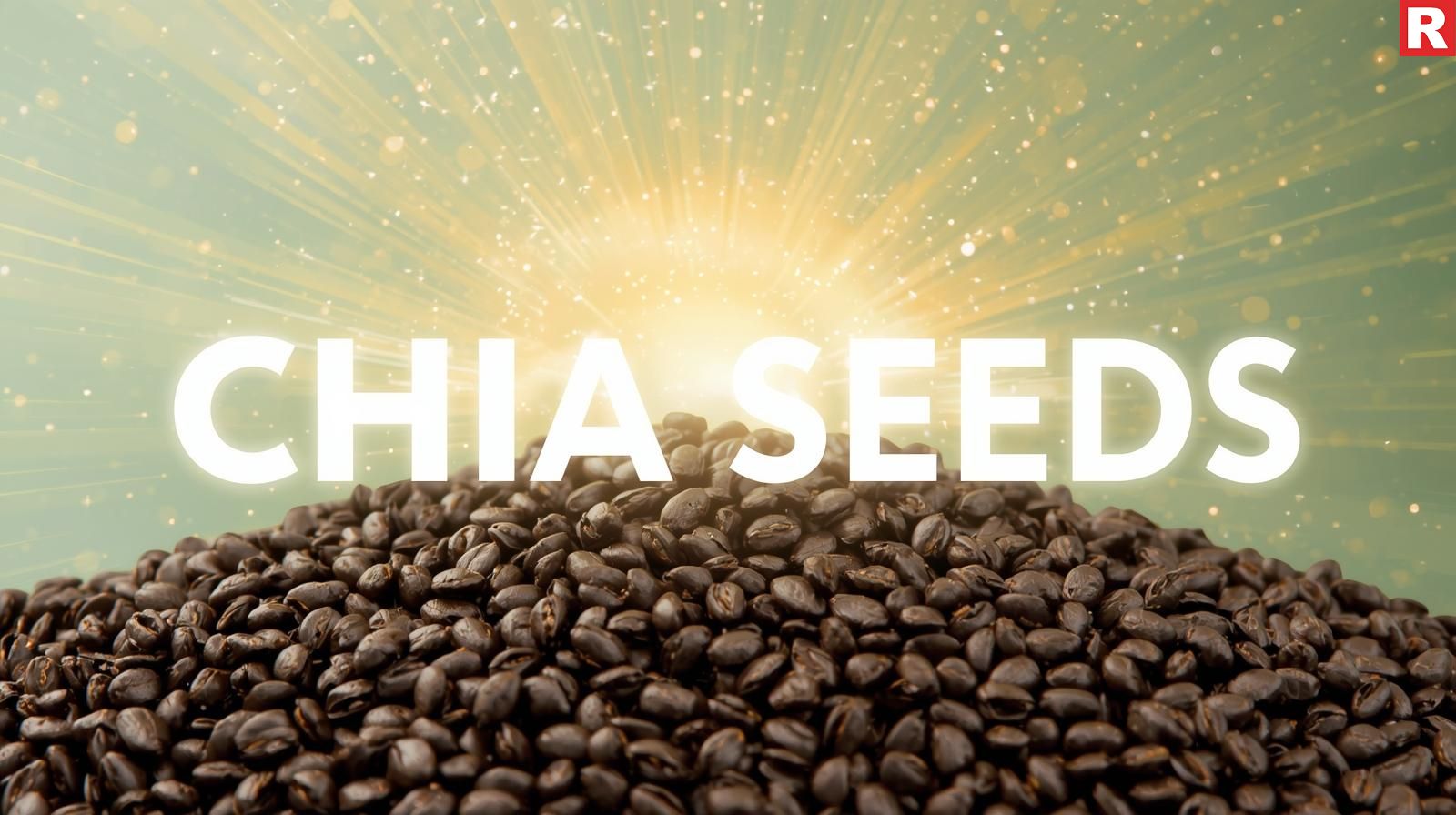
Rich in fiber and good fats, chia seeds are a true nutritional powerhouse. They can be used in a wide range of recipes due to their special capacity to absorb liquid and solidify into a gel.
- Protein Power: About 4-5 grams of protein per 2-tablespoon portion.
- Calorie Count: About 60–70 calories are included in a 2-tablespoon portion.
- Bonus: Contains omega-3 fatty acids, which are essential for heart and brain health, in one of the best plant-based forms.
Reducing Cravings: Because of their high fiber content, they swell in your stomach, giving you a feeling of fullness that drastically lowers your appetite.
How to Enjoy: Sprinkled over yogurt or cereal, mixed into smoothies, or soaked in liquid to produce chia pudding.
Read this: Chia Magic: Health Benefits & Endless Delicious Ways to Enjoy
Fuel Your Body, Conquer Your Cravings
The key to overcoming cravings is making better, more informed eating choices rather than starving yourself. You can help your body feel fuller for longer, balance your energy levels, and support your health goals by making high-protein, low-calorie foods a priority.
In addition to being nutrient-dense, the ten meals on the above list are also tasty, adaptable, and offer the long-lasting fullness you require to deal with hunger and cravings. Include them in your regular diet, try various preparations, and see how really fulfilling and beneficial these simple modifications can be. Take a big step toward a better, more manageable, and more pleasurable eating path by embracing the power of protein.

The world of superfoods is vast and enormous. Still, not any food can become a superfood. However, chia seeds, which have recently sparked a wave in the healthy food industry, are the ones that deserve to be a superfood. These are a nutritional powerhouse with their ability to store many key nutrients in such a small amount. The origin of chia seeds can be dated back to the ancient Aztec and Mayan civilizations, where chia seeds were once renowned for their ability to help maintain endurance and energy. In fact, the term "chia" itself is derived from the Mayan word for "strength."
In addition to its amazing health benefits, this ancient staple has seen a spectacular comeback in popularity today due to its extraordinary cooking possibilities. Unlocking the magic of chia seeds is one of the easiest and most effective ways to enhance your daily nutrition, whether you are a dedicated health enthusiast or someone just beginning their health journey. In this article, we will be discussing the multiple health benefits of these tiny but nutrient-dense seeds, and also give you tips on how to enjoy them in your meals.
Read more: Top Drinks You Should Consume to Get a Festive Glow
The Unbelievable Nutritional Powerhouse
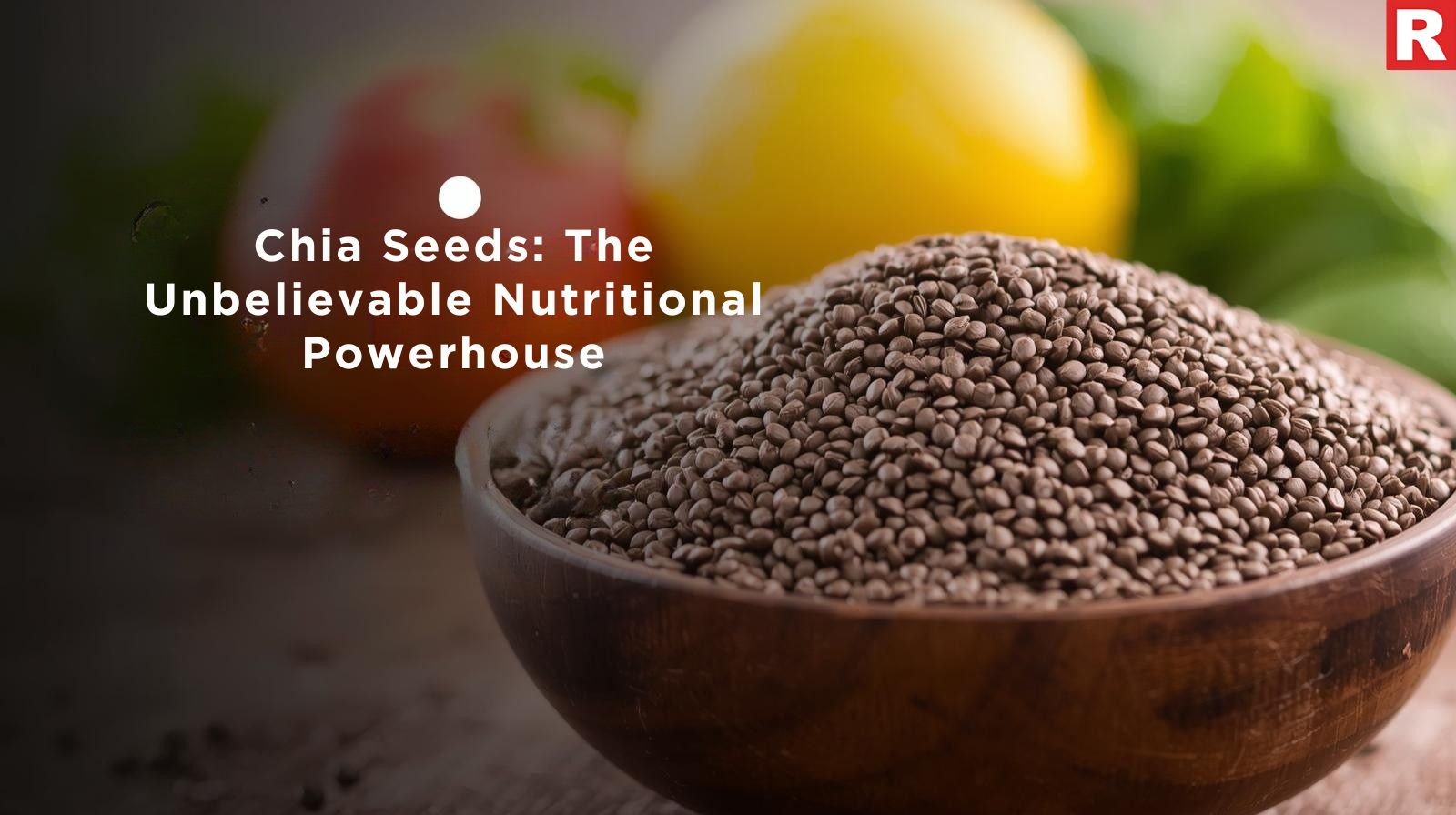
Don't be fooled by how small these seeds are. Rich in vital nutrients, chia seeds are a nutritional powerhouse that can improve your health from the inside out. Let's take a closer look at what makes them unique.
1. Rich in Omega-3 Fatty Acids
The remarkably high amount of omega-3 alpha-linolenic acid (ALA) in chia seeds is one of its main factors. Chia seeds are actually among the best organic sources of this essential fatty acid. ALA is essential for heart health because it lowers blood pressure, reduces inflammation, and lowers the risk of heart disease. By incorporating chia seeds into their diet regularly, vegetarians and vegans can easily meet their omega-3 requirements without relying on fish oil supplements.
2. A Fiber Champion
A single two-tablespoon serving of chia seeds provides a great amount of daily intake of fiber intake, making them a genuine champion of the fiber space. They contain both soluble and insoluble fiber, which are essential for digestive health of a person. By forming a gel-like structure in your stomach, the soluble fiber slows down digestion, increases feelings of fullness, and helps keep blood sugar levels stable. Chia seeds are, therefore, a great tool for people with diabetes and for managing their weight. By giving your stool more volume, the insoluble fiber encourages regular bowel movements and keeps constipation at bay.
3. Complete Plant-Based Protein
For people looking to attain protein from plant sources and increase their protein intake, chia seeds are the best option. They have a complete amino acid profile, since they provide all nine essential amino acids that our bodies are unable to manufacture on their own. Because of this, they are a better source of protein than many other plant-based options and are a great complement for athletes and plant-based diet followers.
4. Loaded with Antioxidants
Chia seeds are rich in antioxidants, which are substances that combat free radicals and lessen the body's oxidative stress. This defense mechanism supports general cellular health, lowers the risk of chronic diseases, and fights aging symptoms. Chia seeds' antioxidants also keep their delicate omega-3s from getting oxidized, which is another reason why they stay fresh for so long.
5. Abundant Minerals
Chia seeds are an excellent source of vital minerals in addition to their macronutrient composition. Their calcium content is surprisingly high, surpassing that of the majority of dairy products by weight. They are also a good source of phosphorus, which combines with calcium to form strong bones and teeth, and magnesium, which is essential for healthy muscles and nerves.
Know more: 10 Popular Energy Drinks and Their Benefits
How Chia Seeds Work
The amazing capacity of chia seeds to absorb liquid and create a gel is among their most appealing qualities. Their high soluble fiber content gives them their special quality. They can absorb up to 10–12 times their weight in water or another liquid, giving them a pudding-like consistency. Their versatility comes from their natural gelling effect, which makes them an excellent natural thickening, binder, and texturizer in a wide range of recipes.
Their capacity to gel also adds to their health advantages. The seeds help you feel full and satisfied for longer after eating, which can reduce overeating and help you lose weight.
Delicious Ways to Enjoy Chia Seeds
Are you prepared to begin using this superfood in your diet? Because of their neutral flavor, chia seeds may be used in almost any meal without changing its flavor, making them extremely easy to use. Here are a few of the most popular and delicious ways to eat them.
Chia Pudding: The Classic Staple

Chia pudding is perhaps the most well-known usage for chia seeds, and with good reason for that. It's easy, tasty, and incredibly customizable. It is ideal for a nutritious dessert or a breakfast that can be prepared in advance.
Simple Recipe for Chia Pudding:
Ingredients:
- Chia seeds, two tablespoons
- Half a cup of liquid, such as ordinary milk, almond milk, coconut milk, or oat milk
- One teaspoon of sweetener, such as honey, maple syrup, or a few drops of stevia
- Half a teaspoon of vanilla essence (optional)
Instructions:
- Mix the chia seeds, liquid, sweetener, and vanilla essence thoroughly in a basin or container.
- After letting the mixture settle for roughly five minutes, whisk it once more to remove any remaining clumps.
- Cover and chill for at least two hours, or better yet, overnight, until it thickens and takes on the consistency of pudding.
- Before serving, sprinkle your preferred chocolate chips, nuts, or fruits on top.
Innovative Variations:
- Add 1 tablespoon of cocoa powder to the chocolate chia pudding.
- Mash a handful of fresh berries into the mixture to make Berry Chia Pudding.
- Use coconut milk to make tropical chia pudding, then garnish with pineapple and mango.
What's new: Top 10 Non-alcoholic Drink Ideas for Your Restaurant
Smoothie & Juice Boosters

One of the simplest ways to receive a nutritious boost without even realizing it is to add chia seeds to your fresh juices or smoothies. Just put a tablespoon or two into your blender along with the rest of your ingredients. In addition to adding fiber, protein, and healthy fats, they will thicken the smoothie and make it a more nutritious and delicious meal.
Baking & Cooking Add-Ins
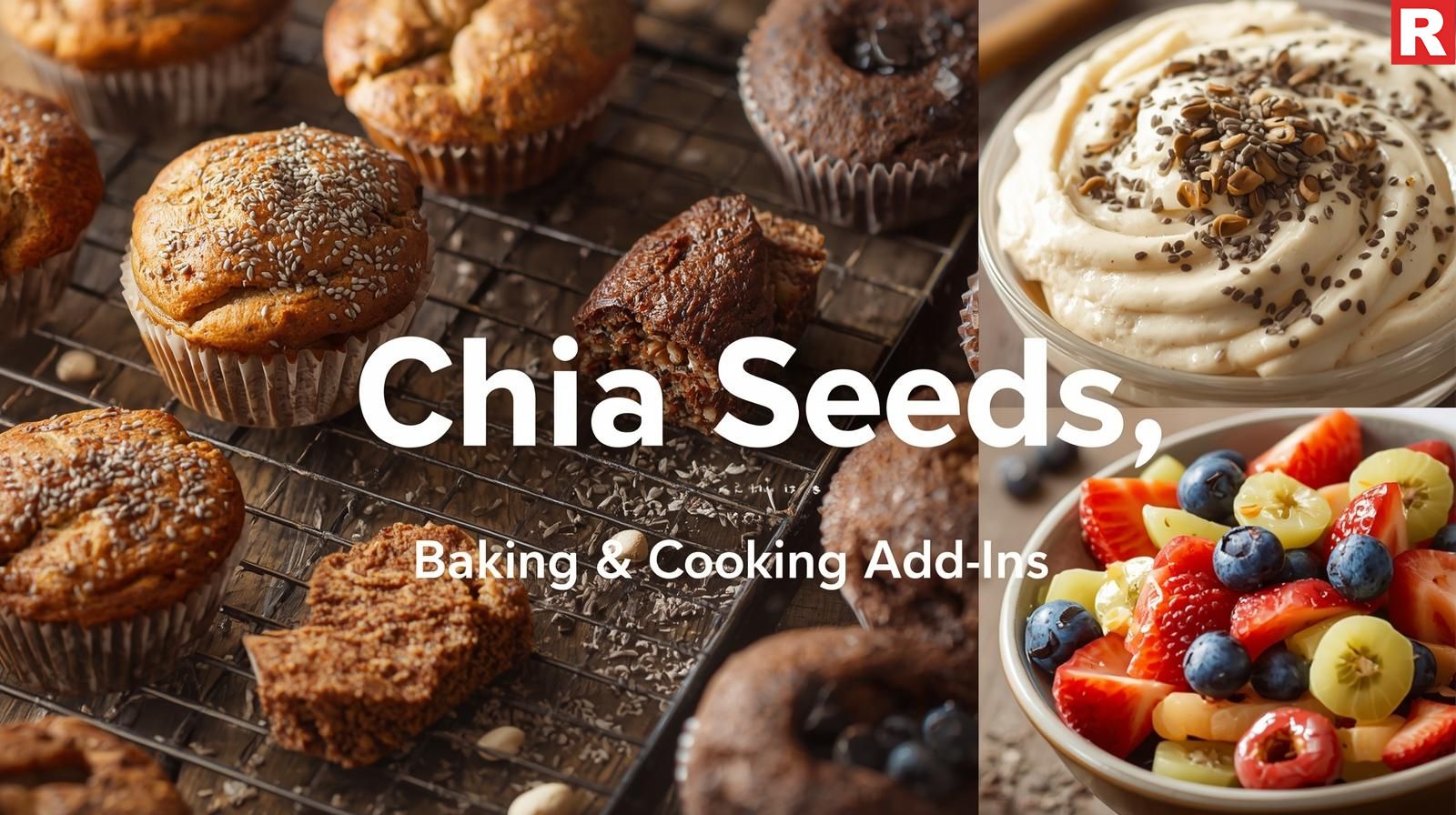
Chia seeds are a great gluten-free option to enhance baked foods' nutritional value and texture.
- In breads and muffins: Add them to the mix for a nice crunch and fiber boost.
- As an Egg Substitute: A "chia egg" is the ideal option for vegan or egg-free baking. To make a gel, combine 1 tablespoon of chia seeds with 3 tablespoons of water and let for 5 minutes. In most recipes, this mixture can be used as a binder in place of one egg.
Toppings & Garnishes
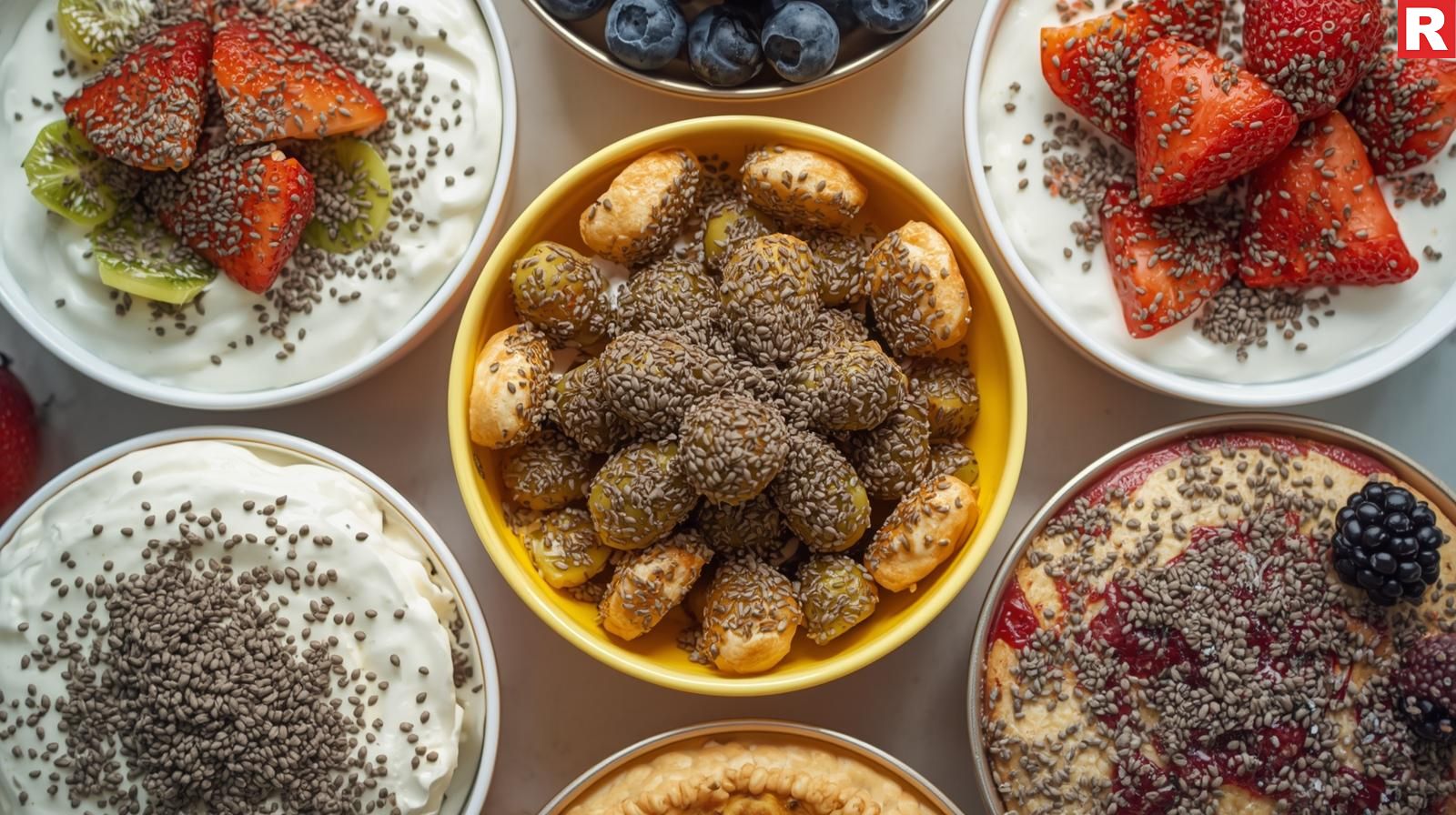
If you don’t want to mess with a recipe or simply need a good garnish to finish your dish, then you can simply sprinkle a tablespoon of crushed or whole chia seeds on your favorite dishes. They will be perfect for:
- Yogurt or oatmeal
- Salads
- Cereal
- Fresh fruit bowls
- Soups
Chia Fresca: The Ancient Energy Drink

Chia Fresca is a refreshing, hydrating beverage that originated in Mexico and is very simple to prepare. It's ideal as a refreshing beverage on a hot day or as a natural energy boost before working out.
Easy Recipe for Chia Fresca:
Ingredients:
- One or two tablespoons of chia seeds
- One cup of water
- Half a lemon or lime's juice
- Your preferred sweetener (to taste)
Instructions:
- Add the chia seeds to the water and stir.
- Let them soak for 15 to 20 minutes, stirring now and then, until they take on the consistency of gel.
- Add the sweetener and lemon or lime juice. Mix thoroughly and serve cold.
In short, there are multiple ingredients and many customizable ways to eat chia seeds. You can enjoy them with your choice of element, like yogurt, fruits, berries, water, or even milk.
Check out: Best Foods for Glowing Skin & Healthy Hair
How to Make a Healthy Dessert With Just 5 Ingredients
Tips for Buying, Storing, and Using Chia Seeds
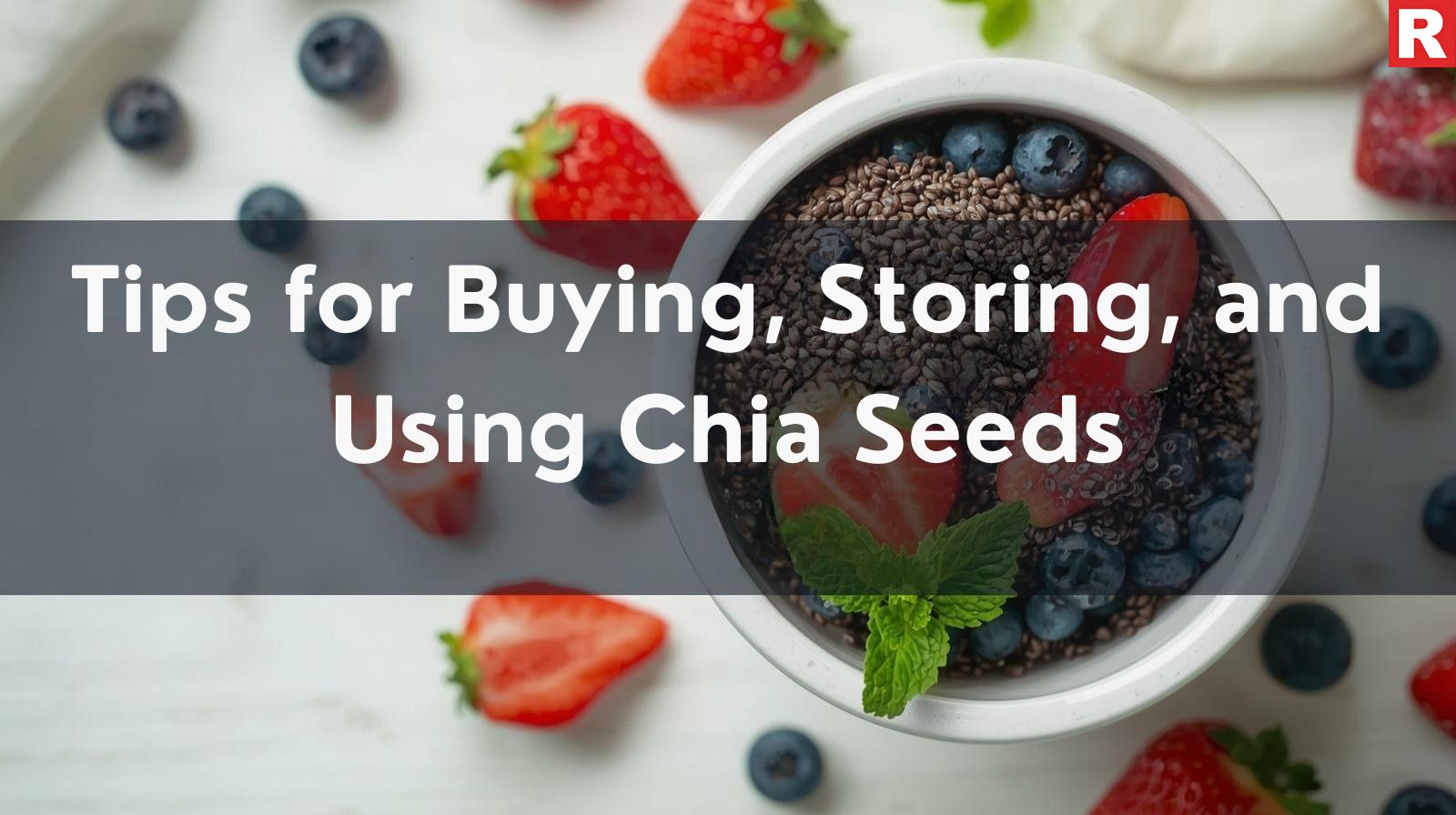
Knowing a little bit about chia seeds will help you get the most out of them.
- Buying: When purchasing, look for whole chia seeds in a bag or sealed container. They are available in both black and white forms and have the same nutritional value.
- Storage: Chia seeds have a long shelf life because of their consistent antioxidant content. Keep them in a cool, dark location, such as your pantry, in an airtight container. They can last for a number of years.
- Hydration: Although it's not technically required, soaking chia seeds beforehand can facilitate digestion and guarantee that you receive the full advantages of their gel-like quality. Make sure to stay hydrated throughout the day if you take them dry.
- Dosage: Start with one to two tablespoons daily. To make sure your digestive system gets used to the high fiber level, this is a good starting quantity.
Read this: 10 vegetarian foods that are healthy and suitable for Fasting
The Simple Magic of Chia
Chia seeds stand out for their stunning simplicity and undisputed effectiveness in a world full of complicated diets and pricey supplements. They provide a powerful plant-based supply of protein, fiber, omega-3 fatty acids, and vital minerals in a small, simple package. Their "magic" is found in their potent, natural ability to support and nourish the body rather than in a secret element.
Chia seeds are a monument to the idea that some of the most powerful changes originate from the tiniest sources, whether they are added to your favorite dish, mixed into a morning smoothie, or made into a filling pudding. Accept the chia magic and learn how this age-old superfood can improve your life pleasantly and healthfully.

Pasta has evolved from its beginnings as an Italian staple to become a popular comfort food in both homes and restaurants in India's changing food sector. But as health consciousness rises across the country, especially in major urban cities, mindful customers are turning their attention away from typical refined wheat pasta. Alternatives that combine the beloved texture and versatility of pasta with the substantial nutritional advantages of whole grains are becoming more and more popular. The main focus of this story is whole wheat pasta, which offers a nutrient-dense, fiber-rich alternative that promotes a healthier way of living without compromising the enjoyment of a delicious pasta dish.
This in-depth article explores the growing appeal of whole wheat pasta in India. We will discuss its nutritional advantages, important considerations for buyers, and the top brands of whole wheat pasta in India, looking at their components, texture, accessibility, and appeal for families and health-conscious individuals nationwide.
Read this: Frankenstein-Inspired Foods and Drinks for Your Spooky Celebrations
The Advantages of Whole Wheat Pasta
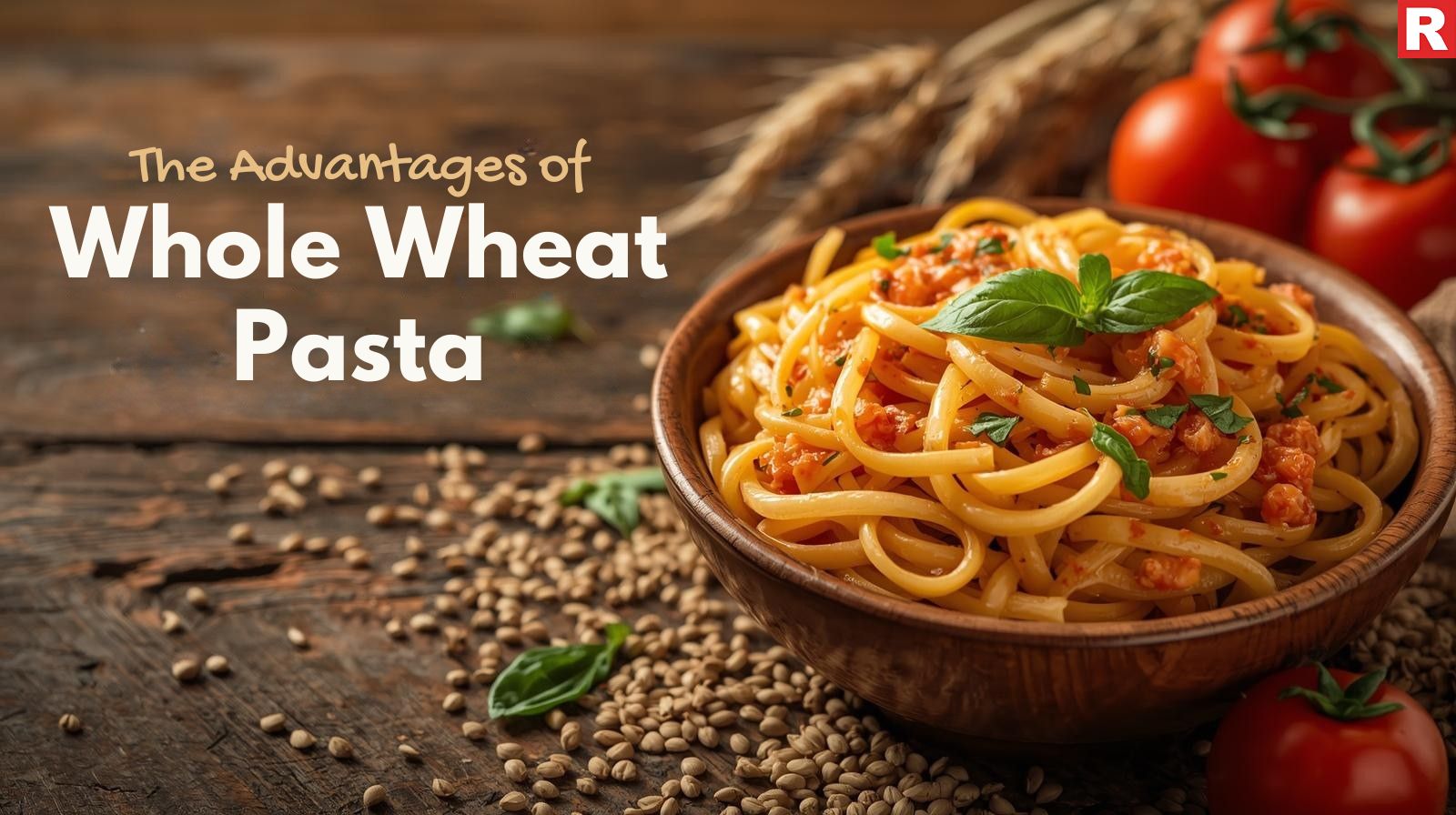
Growing knowledge of health and a desire for less processed foods are the main causes of the trend toward whole wheat pasta:
- Higher in Dietary Fiber: Whole wheat pasta keeps the bran, which is high in dietary fiber, unlike processed pasta. Fiber helps control blood sugar levels, improves gut and heart health, facilitates digestion, and improves hunger, which keeps you fuller for longer.
- Additional Nutrients: Whole wheat flour contains the germ and endosperm, which are vital sources of iron, magnesium, zinc, selenium, and the B vitamins (B1, B3, and B5). When wheat is refined to become maida, the nutrients are mostly lost.
- Reduced Glycemic Index (GI): Whole wheat pasta often has a lower GI than white pasta because of its higher fiber content. Because of this, it raises blood sugar more gradually, which makes it a better option for people with diabetes or those looking for long-lasting energy without a sudden increase in blood sugar.
- Weight management: Whole wheat pasta's higher fiber and protein content make you feel fuller for longer, which may help you cut back on calories and manage your weight.
- Promotes Gut Health: The fiber serves as a prebiotic, feeding good bacteria in the gut and promoting a healthy digestive tract.
Know more: 7 Reasons to Add Macadamia Nuts to Your Daily Diet
What to Look For While Buying "Whole Wheat Pasta"?
To ensure that you are certainly buying pasta from a brand that is genuinely made from wheat flour, you need to keep these indicators in mind:
- The First Ingredient: The most important indicator is "Whole Wheat Semolina" or "Whole Durum Wheat Semolina" as the first ingredient. A product is not truly whole wheat if its first or only ingredient is "refined wheat flour" (maida) or "durum wheat semolina" (without the word "whole"). Look for "whole wheat" at the top of the list because some brands may use a combination.
- Fiber Content: Examine the nutritional information panel to determine the fiber content. Each serving of a high-quality whole wheat pasta (usually 50–80 grams of dry pasta) should include at least 4-6 grams of fiber.
- Ingredient List: Generally, a simpler and shorter list of ingredients is preferable. Be mindful of extra sodium, artificial coloring, and other additives.
- Texture: Compared to white pasta, expect a slightly firmer, chewier texture. Cooking till the pasta is done may take an additional minute or two.
- Color: Unlike pale yellow pasta, true whole wheat pasta will have a somewhat darker, brownish tint.
- "100% Whole Wheat" Label: The most obvious guarantee that no refined flour was used in its manufacture is seen on the label.
Top Whole Wheat Pasta Brands in India
As the demand for healthier whole-wheat pasta grew in India, several brands jumped into the market offering excellent wheat options. Here are some of the top brands providing whole wheat pasta in the country:
1. Barilla Whole Wheat Pasta
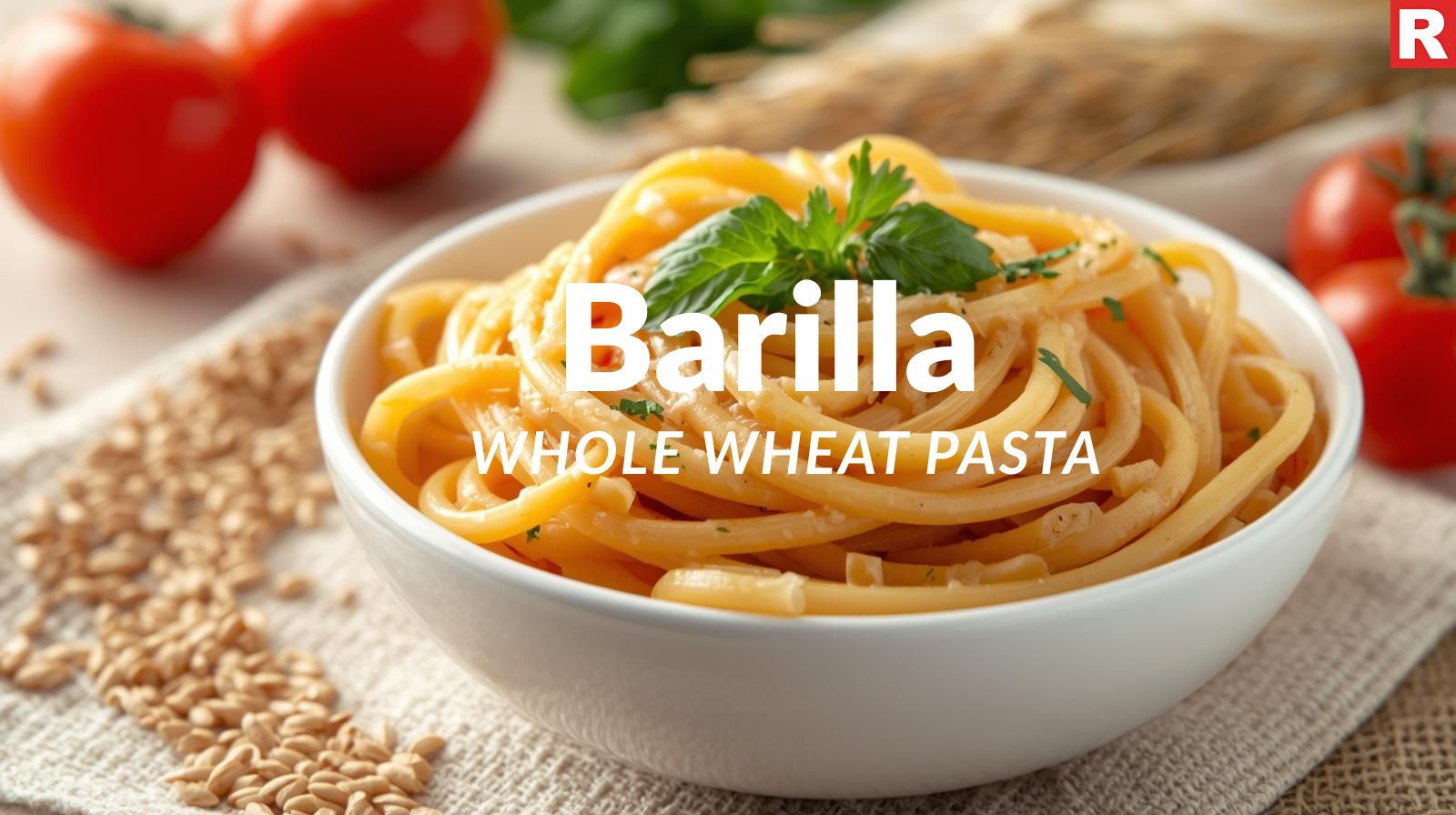
The Italian-based big company Barilla is well-known throughout the pasta industry, and its entire wheat line is well-liked in India. Because of its typical chewy texture, genuine Italian quality, and accessibility in all major Indian cities, Barilla Whole Wheat Pasta is popular with consumers. It has a hard bite and a rich flavor that complements a variety of sauces because it is made from 100% whole durum wheat semolina. Its high fiber content in the nutritional profile appeals directly to health-conscious consumers. Barilla is a solution for anyone looking for a high-quality, genuine whole wheat pasta experience because of its wide variety of shapes, which include penne, spaghetti, fusilli, and farfalle. It is easily accessible because it is available in practically all significant supermarkets and online shopping platforms.
2. Disano Whole Wheat Pasta
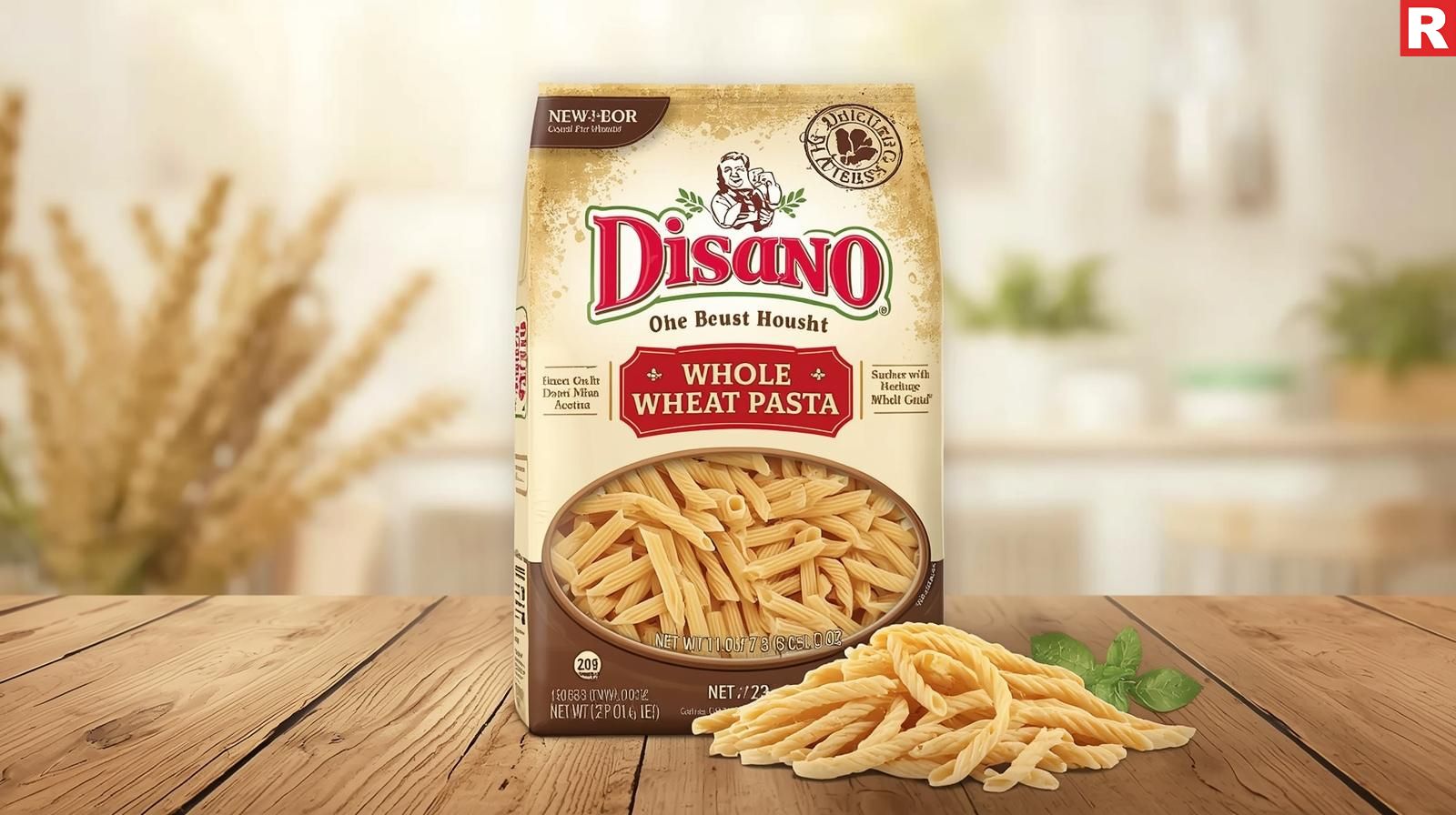
With its line of nutritious food items, such as pasta and olive oil, Disano has swiftly become a well-known brand in the Indian market. Disano Whole Wheat Pasta is well-known for being a reliable and reasonably priced whole wheat choice that offers a pleasing texture and flavor. The desired fiber and nutritional advantages are provided by the 100% whole wheat durum semolina used in its production. Customers in India value Disano's ability to provide a high-quality product that fills the gap between more affordable options and luxury international brands. Its steady quality and growing availability in supermarkets and online retailers make it a formidable competitor for regular, healthful pasta dishes that appeal to a wide range of families.
What's new: Best brown bread brands in India
3. Saffola Oodles Whole Wheat Pasta
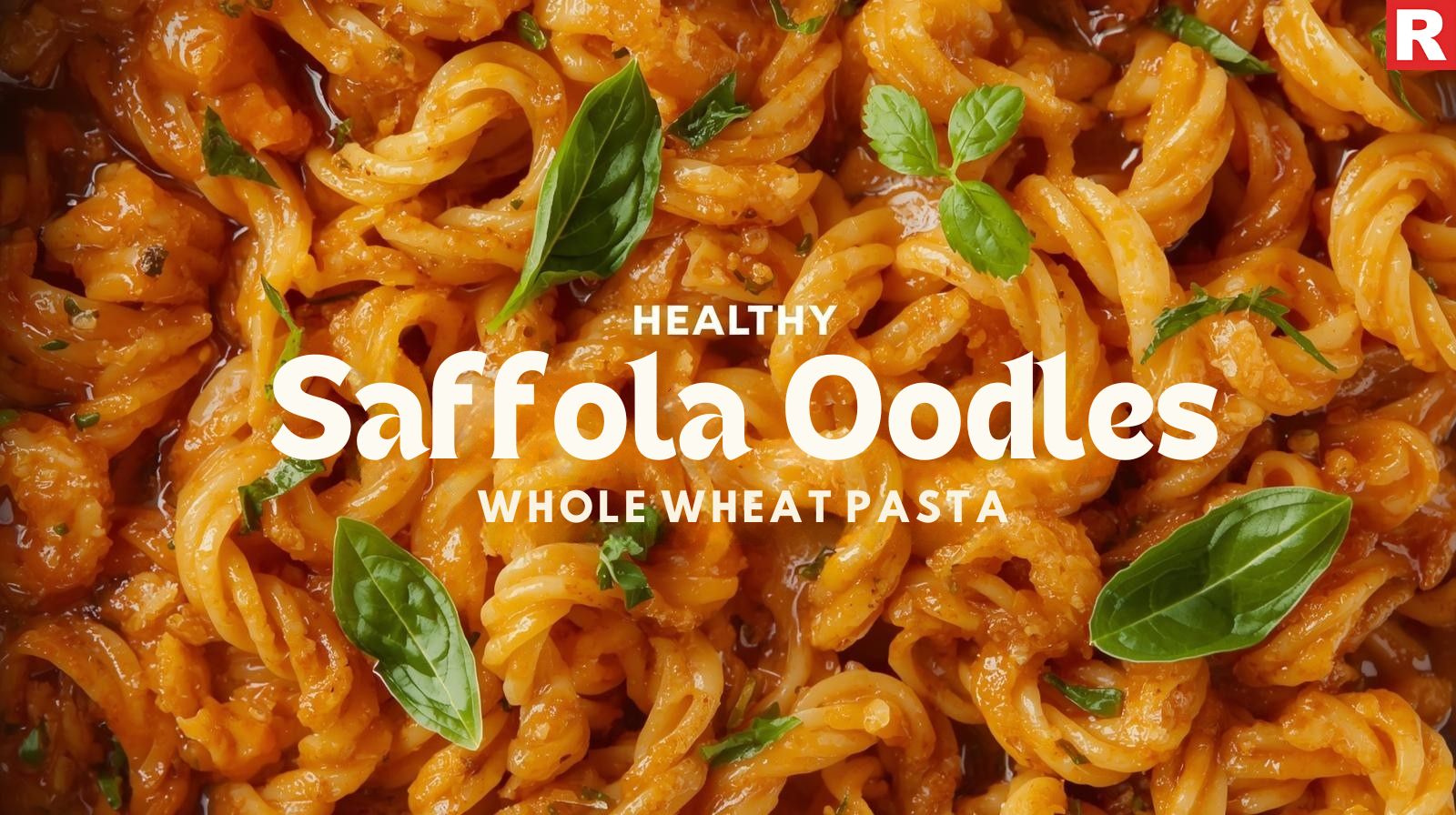
The well-known Indian brand Saffola, which is associated with wellness and health, expanded its product line to include whole wheat pasta. Saffola Oodles Whole Wheat Pasta is well-known for combining the ease of a quick-cooking pasta with the reliability of the Saffola brand. It is frequently promoted as a healthy option for meals or snacks. Although it contains "whole wheat flour," customers should verify the ingredient list for the particular "Oodles" product because certain variations may contain additional ingredients. It seeks to offer a delicious, quick, and comparatively healthier substitute for conventional instant noodles, appealing to a younger customer base and busy people who value convenience and healthier ingredients in their prepared foods.
4. Nutriorg Whole Wheat Pasta
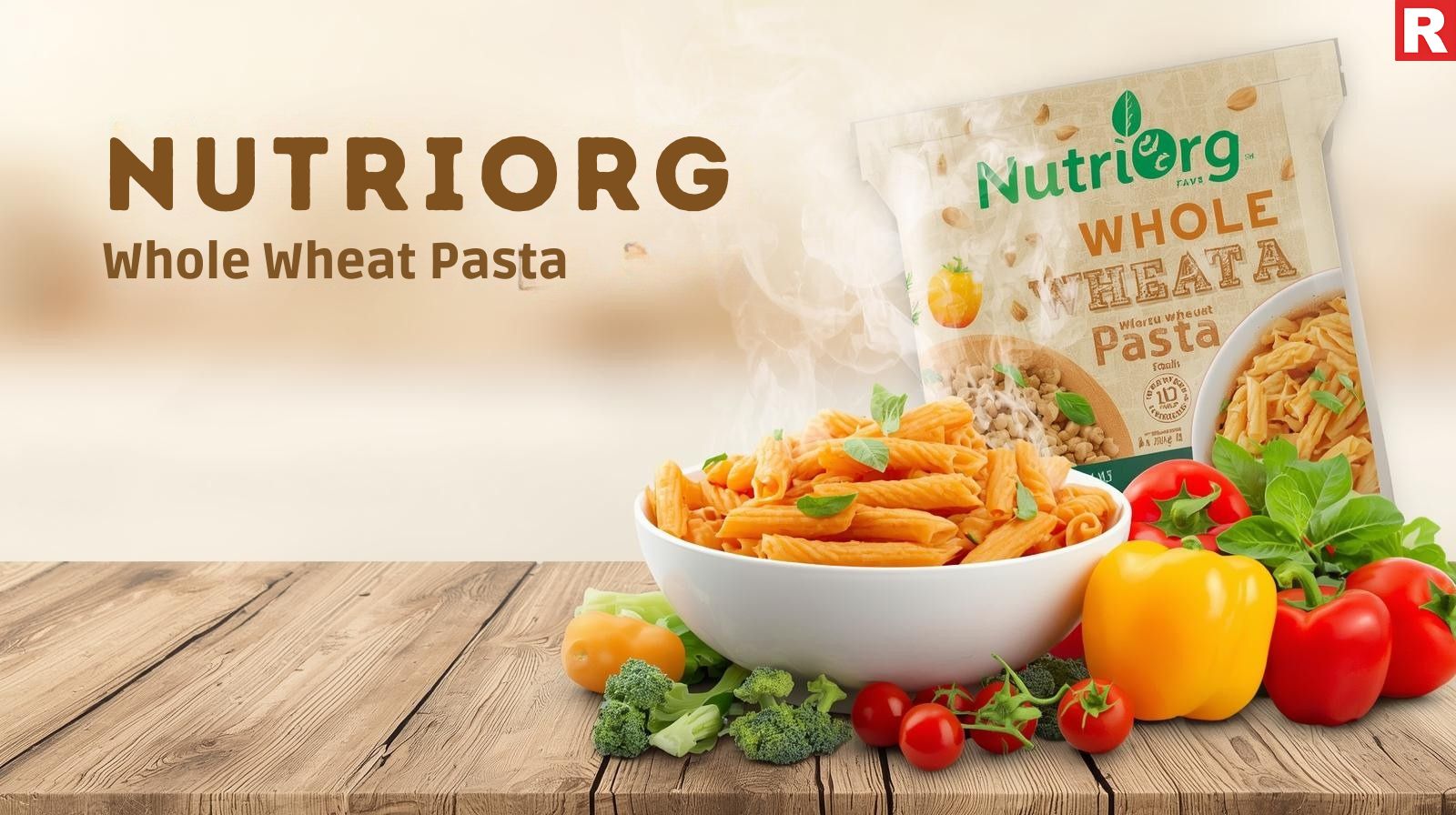
Whole wheat pasta from the Indian company Nutriorg reflects the company's strong commitment to natural and organic food items. Because of its organic certification and emphasis on the health of whole wheat without any additives, Nutriorg Whole Wheat Pasta is well-known. Constructed from 100% organic whole wheat, it targets customers who value organic ingredients and seek out clean-label products. Its dedication to sustainable agricultural methods and avoidance of artificial fertilizers and pesticides makes it appealing, even though its availability may be limited in organic stores and online platforms. For the increasing number of environmentally concerned and health-sensitive Indian consumers, these factors make it their first choice.
Check out: 7 Essentials to Keep Staff Trained in Your Restaurant
How Health & Wellness Trends Are Redefining Indian Dessert Menus
4. Borges Whole Wheat Pasta
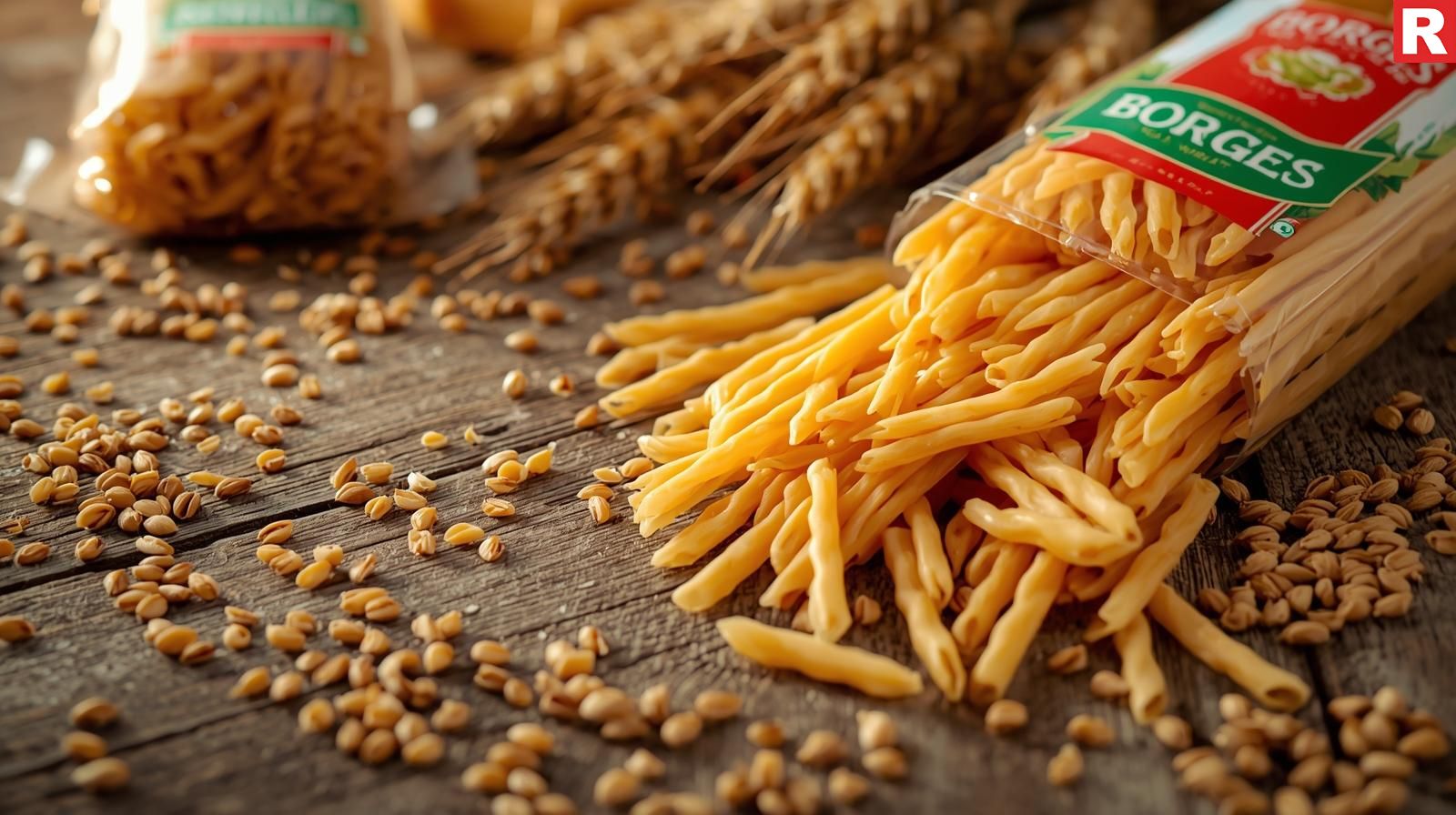
The popular Mediterranean food brand Borges is well-known in India, especially for its olive oils and, more recently, its pasta line. Borges Whole Wheat Pasta is well-known for its premium whole durum wheat semolina, which guarantees a superb texture and genuine flavor. It is distinguished by its firm bite and good sauce-holding capacity, which are traits of high-quality Italian pasta. It serves customers who value imported quality and a dependable whole wheat choice from a reputable foreign brand. It comes in a variety of forms and is available in luxurious supermarkets and online grocery stores throughout major Indian cities. It is a favorite among people looking for healthy gourmet options because of its dedication to using only the best ingredients.
5. Weikfield Whole Wheat Pasta
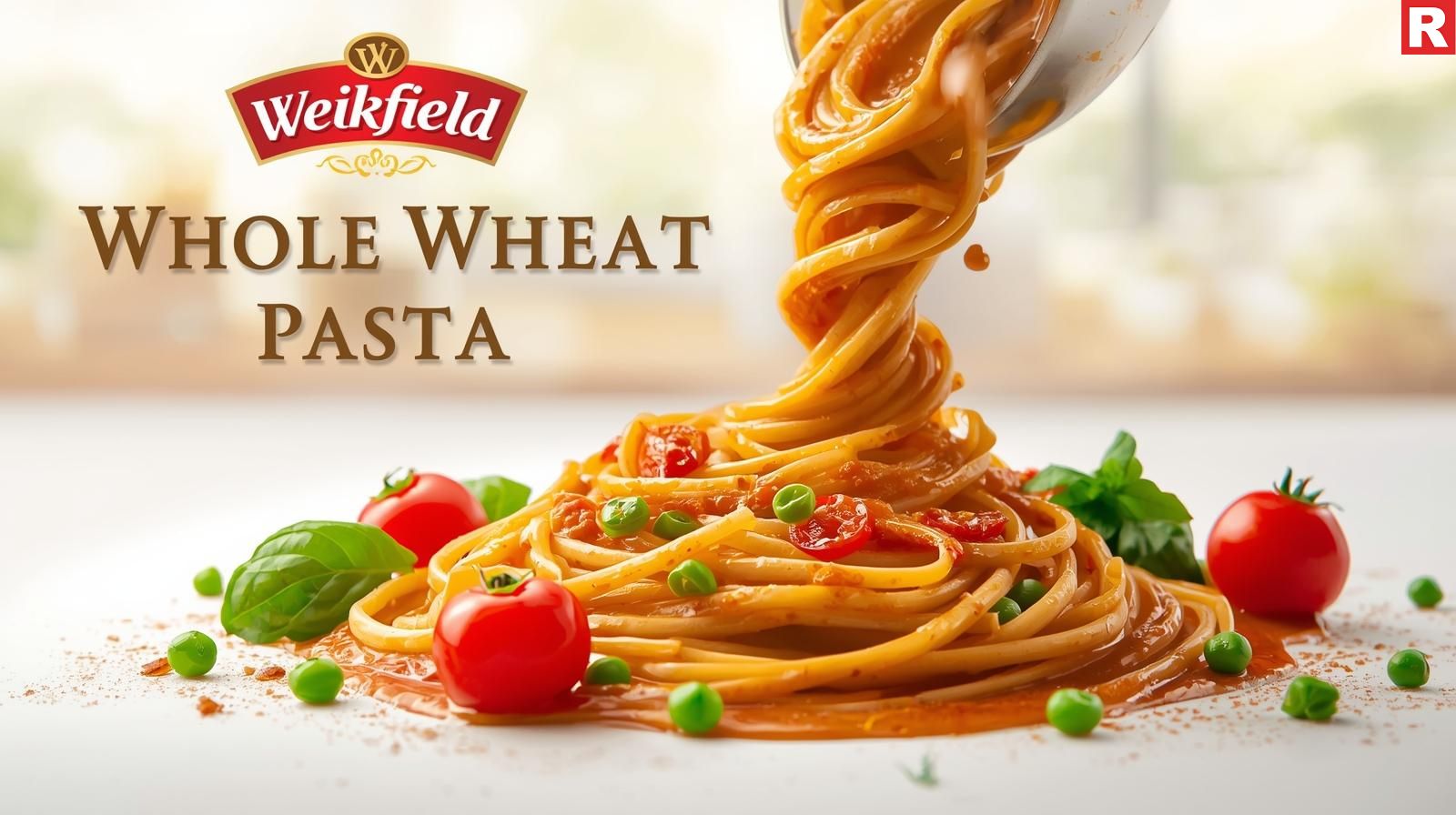
Weikfield, a well-known Indian food brand that specializes in baking supplies and cooking goods, has expanded into the whole wheat pasta industry. Weikfield Whole Wheat Pasta is well-known for being widely available, reasonably priced, and an affordable whole wheat choice for Indian homes. It offers a simple and dependable whole wheat product that guarantees the extra fiber and nutrients that consumers are looking for. Due to its wide distribution network, it is readily available in neighborhood supermarkets and grocery stores, making it a practical option for daily cooking for families of all income levels who are transitioning to healthier options.
Read this: Instagram-Worthy Interior & Food Styling Trends That Are Driving Footfalls in Metro Cities
Tips for Cooking and Enjoying Whole Wheat Pasta
- Remember the Cooking Time: In order to achieve an al dente (firm to the bite) texture, whole wheat pasta usually takes one to three minutes longer to cook than white pasta. Always follow the directions on the package and do a taste test.
- Lots of Water: To keep the pasta from sticking and to ensure that it cooks through, use a lot of boiling salted water.
- Pairing Sauces: The flavor of whole wheat pasta is a little more powerful and nuttier. It goes well with substantial sauces such as tomato-based gravies, pesto, mushroom sauces, or chunky vegetable sauces. Oil-based, lighter sauces are also effective.
- Accept Textures: Enjoy its distinct, pleasant chewiness rather than expecting the same texture as refined pasta.
Conclusion
Whole wheat pasta's rising appeal in India is clearly proof of a national movement in health and wellness. The need for nutritious, whole-grain substitutes is growing as people become pickier about what they eat. Today's market provides a wide variety of whole wheat pasta options to suit different tastes, ranging from kid-friendly blends to authentic textures. Customers can make smart choices by carefully reading labels like "whole wheat semolina" and taking into account variables like fiber content. Including whole wheat pasta in regular meals is an easy yet significant step toward eating in a healthier and more ethical manner.

The Indian diet has changed significantly in recent years, including the simple loaf of bread. Customers are increasingly choosing healthier options over refined flours as a result of the growing health and wellness trend that is spreading through major cities in the country. Once considered an uncommon product, brown bread has gained popularity in many health-conscious households due to its lower glycemic index, increased fiber content, and whole-grain advantages. Its adaptability and health benefits have made it a popular option for people trying to make better food choices, whether they are eating sandwiches or toast each day.
This in-depth article explores the rising demand for brown bread in India. The nutritional benefits of brown bread will be discussed, along with what to look for when selecting a genuinely healthy brand. Additionally, the Best Brown Bread Brands in India will be highlighted, with an emphasis on their ingredients, texture, availability, and suitability for the educated consumer, particularly in metropolitan areas.
Read more: 7 Reasons to Add Macadamia Nuts to Your Daily Diet
The Advantage of Brown Bread: Why the Switch?

A better understanding of nutrition and the long-term health advantages of whole grains is the main factor behind the switch from white to brown bread:
- Increased Fiber Content: Dietary fiber is abundant in brown bread, particularly when it is produced from whole wheat. Fiber supports the health of the heart, helps control blood sugar levels, improves appetite (keeping you fuller for longer), and facilitates digestion.
- Benefits of Whole Grain: Whole wheat flour (atta), which contains the bran, germ, and endosperm of the wheat kernel, is used to make authentic brown bread. These ingredients are rich in vital minerals that are frequently lost in processed white flour, such as iron, magnesium, zinc, B vitamins, and antioxidants.
- Reduced Glycemic Index (GI): Brown bread often has a lower GI than white bread because of its higher fiber content. This makes it a better option for people with diabetes or looking for long-lasting energy because it raises blood sugar levels more gradually.
- Weight management: Brown bread's fiber helps people feel full, which may lower their daily calorie consumption overall and help them control their weight.
- Gut Health: The fiber supports a healthy digestive tract and feeds beneficial gut bacteria by acting as a prebiotic.
- Lower Risk of Chronic Illnesses: Eating whole grains on a regular basis has been associated with a lower risk of heart disease, type 2 diabetes, and several types of cancer.
A quick and easy way to adopt a healthy lifestyle for health-conscious families and individuals is to include brown bread in their daily diet.
What to Look For When Buying "Brown Bread"
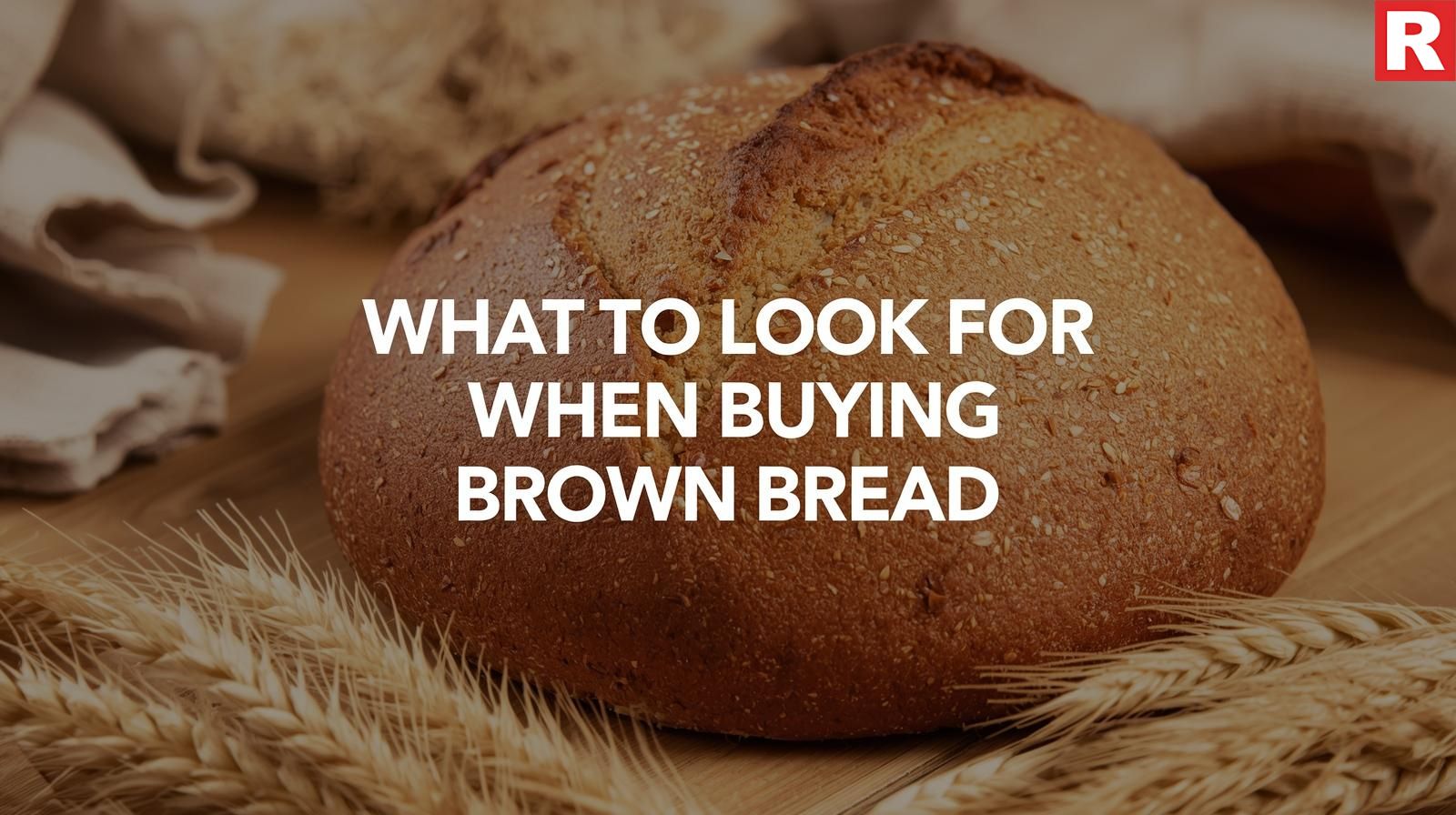
Sometimes the word "brown bread" is deceiving. Without really using whole grains, some manufacturers give white bread a brown tint by coloring it with molasses or caramel. Keep an eye out for these warning signs to make sure you're getting real, healthful brown bread:
- The first ingredient is "whole wheat flour" or "wholemeal flour": The most important indicator is this one. It's basically white bread with coloring if "refined wheat flour" (maida) is the first or only flour mentioned.
- Fiber Content: Verify the nutritional data for the fiber content. Each slice of high-quality brown bread should include at least two to three grams of fiber.
- Sugar Level: Pay attention to additional sugars. A certain amount of natural sweetness is fine, but too much sugar can counteract the health advantages.
- Ingredient List: In general, shorter, more identifiable ingredient lists are preferable. Steer clear of breads that include excessive amounts of high-fructose corn syrup, emulsifiers, or chemical preservatives.
- Texture & Density: Compared to soft white bread, real whole wheat bread frequently has a denser, rougher texture.
- "100% Whole Wheat" Label: This indicates that no refined flour was used, making it the gold standard for brown bread.
Know more: Top Eco-friendly Cleaning Product Brands in India for Restaurants
Top Brown Bread Brands in India
There is an increasing number of brown bread brands available in the Indian market, each with specific characteristics. Here is a thorough analysis of the top brands available:
Britannia
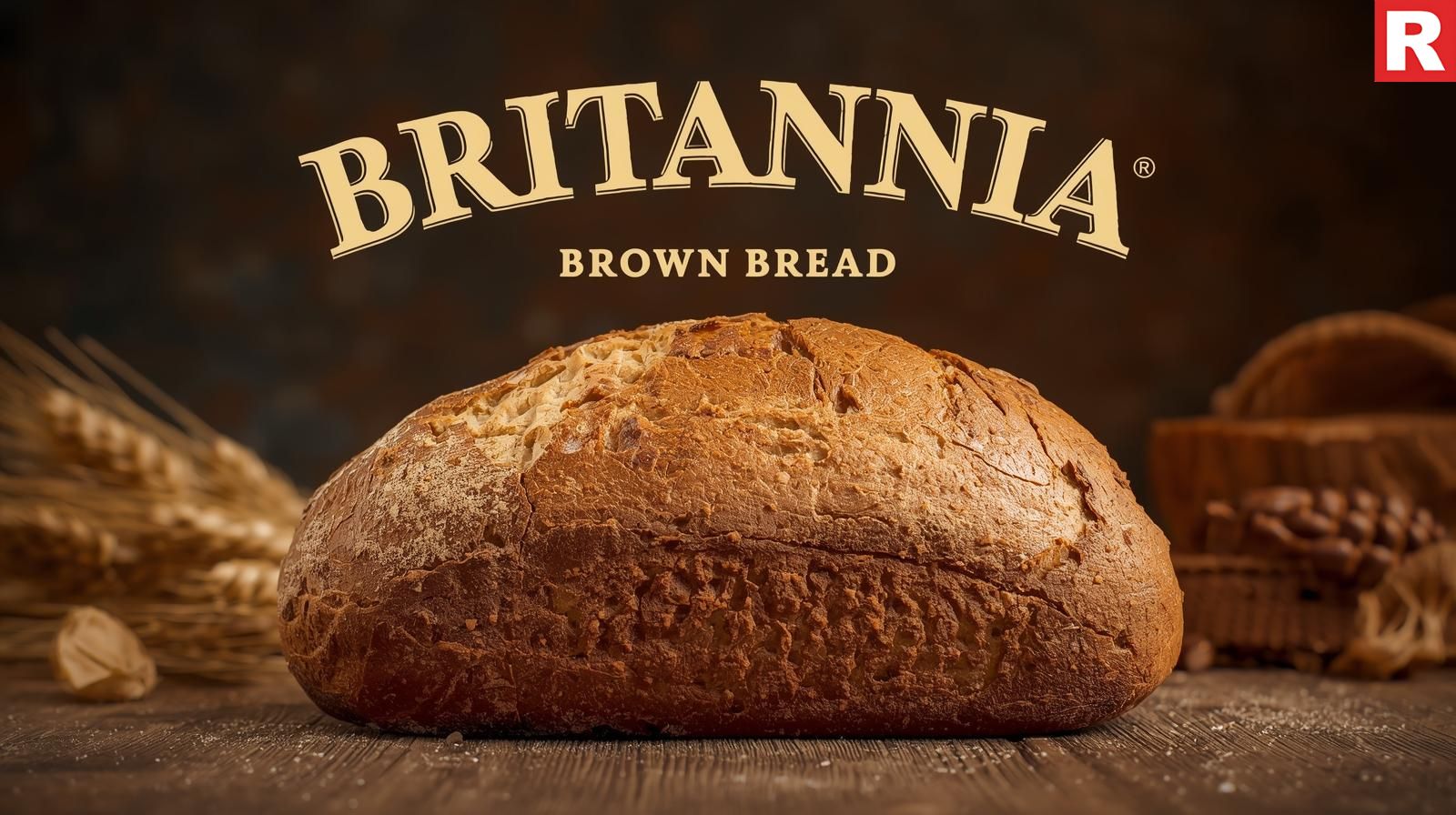
Britannia, a well-known brand in India for many years, has successfully adjusted to health trends and commands a sizeable portion of the bread industry. Britannia's brown bread is well-known for being widely accessible, consistently high-quality, and having a comparatively soft texture that appeals to a wide range of Indian consumers. It constantly mentions "Whole Wheat Flour" (Atta) as the main ingredient, guaranteeing a healthy supply of fiber and vital elements found in whole wheat. Families all throughout the country find it to be an accessible and practical option for everyday use due to its widespread availability in practically every supermarket, grocery store, and neighborhood kirana shop, as well as its reasonable pricing.
Harvest Gold
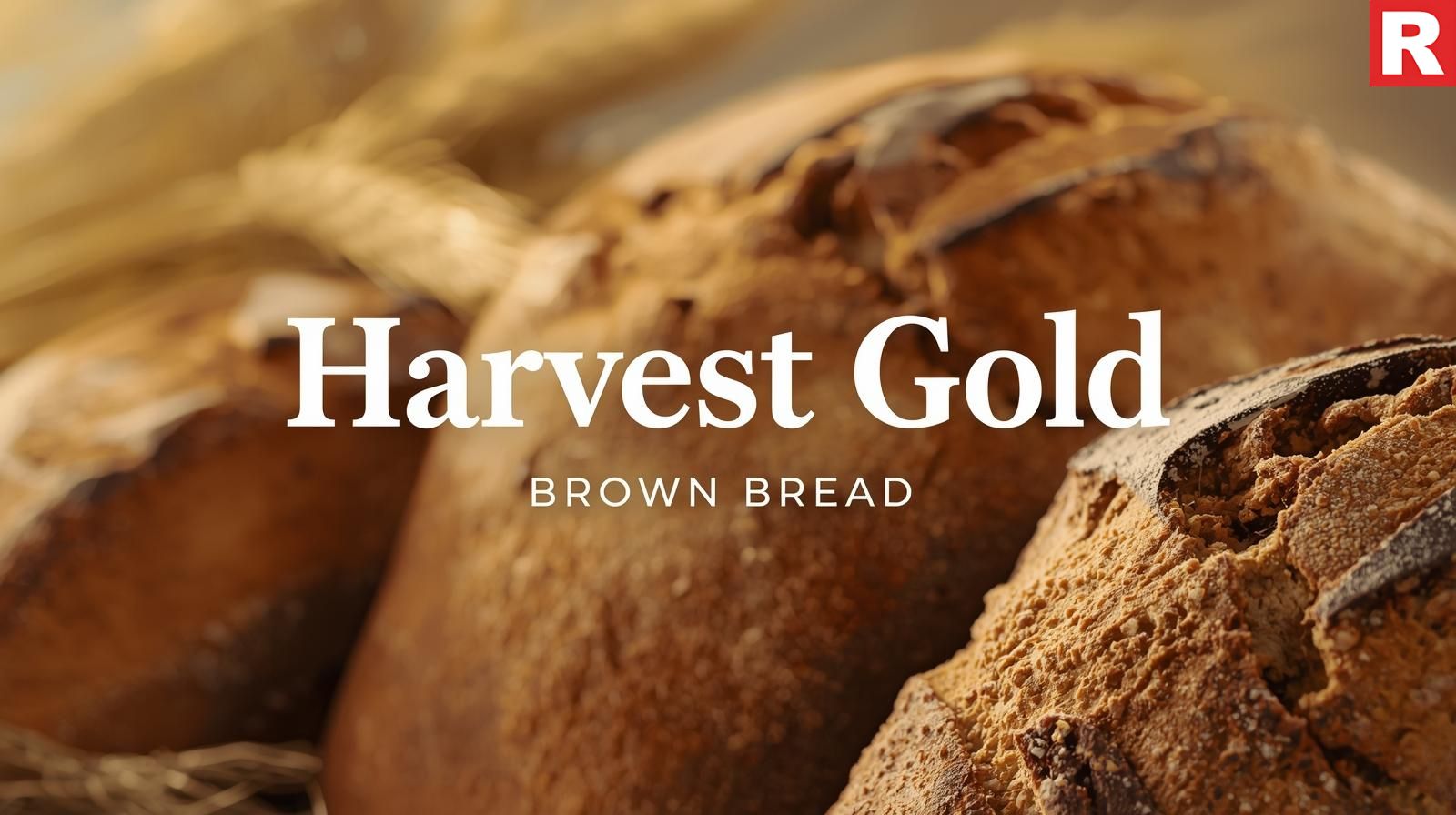
Harvest Gold is a well-known brand, especially in North India, that is well-known for its soft and fresh bread products. Harvest Gold's brown bread is recognized for its strong regional presence, constant freshness, and superb texture. It is popular for its effective daily fresh supply chain and specifically lists "Whole Wheat Flour" as the main ingredient. The bread is suitable for people switching from white bread since it achieves a decent balance between softness and the usual solidity of whole wheat bread. Many households looking for dependable, whole wheat deliciousness consider it a staple due to its significant market presence in the locations where it operates.
English Oven

The premium bakery brand English Oven, which is a division of Mrs. Bector's Food Specialties, is well-known throughout India for its superior bread and baked goods. The brown bread from English Oven is recognized for its outstanding quality, superb texture, and flavor profile, which frequently tends toward a more handmade feel. It is renowned for its consistent quality and good crust development, and it always uses whole wheat flour to provide authentic brown bread. While still being delightfully soft, the bread frequently has a somewhat stronger, more genuine whole wheat quality. It appeals to selective customers who value a higher-quality product for gourmet sandwiches and toast, and it is commonly accessible in supermarkets and larger grocery stores in metro areas, as well as increasingly in other urban areas.
What's new: How Health & Wellness Trends Are Redefining Indian Dessert Menus
Modern Bread
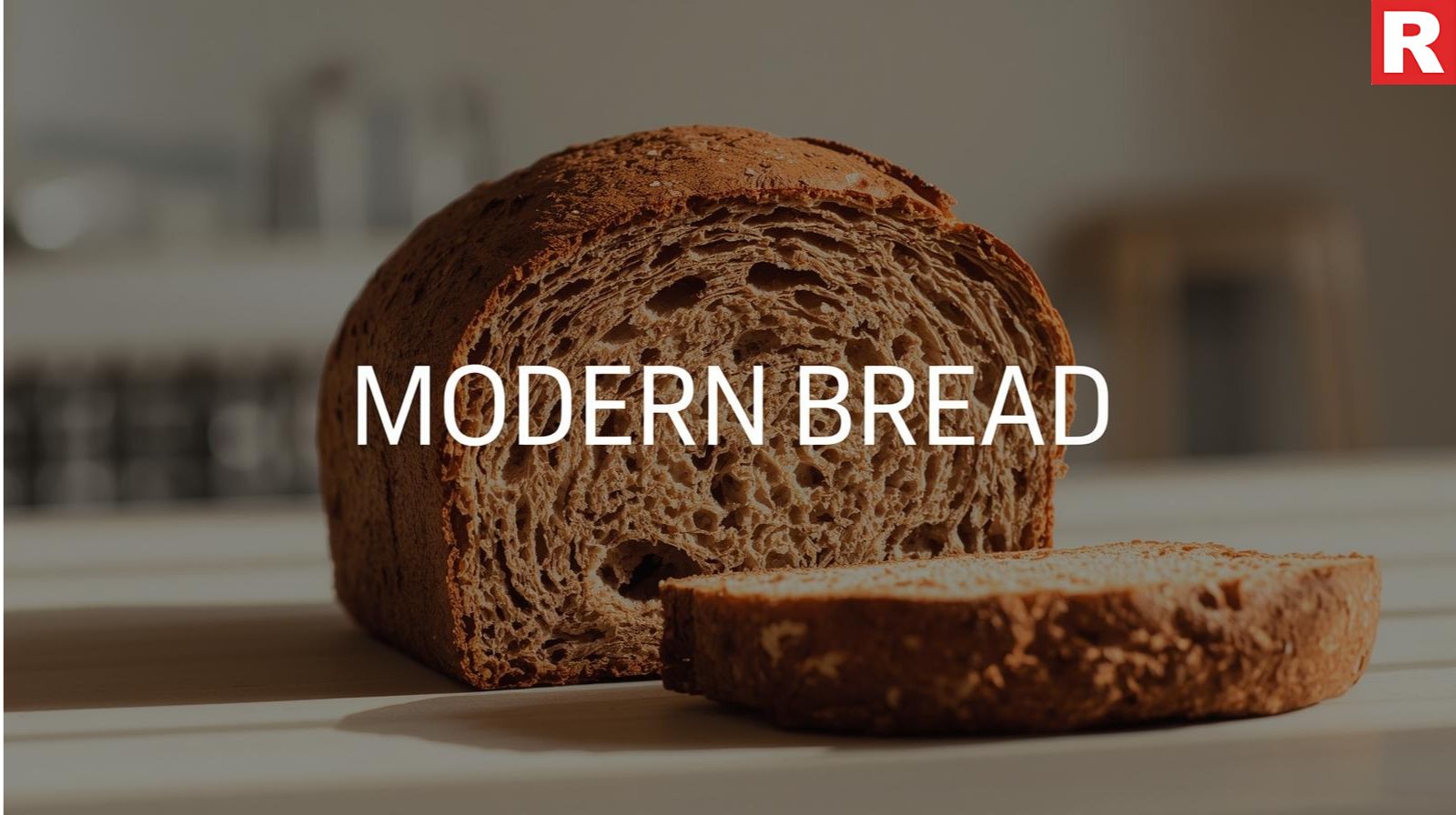
For many years, Modern Bread, a traditional company in India, has been a staple in many homes. Brown bread from Modern Bread is well-known for being widely available in many states, being reasonably priced, and working effectively as a whole wheat bread choice for daily use. It is a dependable alternative for those looking for healthier bread options at a competitive price because it uses whole wheat flour as its main ingredient. Because of its wide distribution network, which makes it accessible even in more isolated and smaller towns, healthy bread is now available to a wider range of people and represents a reliable brand that continues to thrive over time.
The Baker's Dozen

In major Indian cities, The Baker's Dozen, a relatively new creative bakery company, has rapidly developed a devoted following because of its dedication to providing premium, natural, and preservative-free products. Often marketed as "Whole Wheat Sandwich Bread" or something similar, The Baker's Dozen's brown bread is well-known for its minimalist label, clear lack of artificial preservatives, and genuine, healthful flavor. It has a richer, nuttier flavor profile and a more rustic, chewy texture. It frequently mentions clearly that it is made entirely of whole wheat flour. Mostly found in gourmet shops, a few supermarkets, and their own online delivery services in large cities, it serves health-conscious consumers who value natural ingredients and clean eating, and who are prepared to go for specific brands for better flavor and no artificial additives.
Check out: What Are the Special Dishes You Must Try This Durga Puja
Top Electric Cooker Brands for Restaurants in India
Spencers (Private Label)
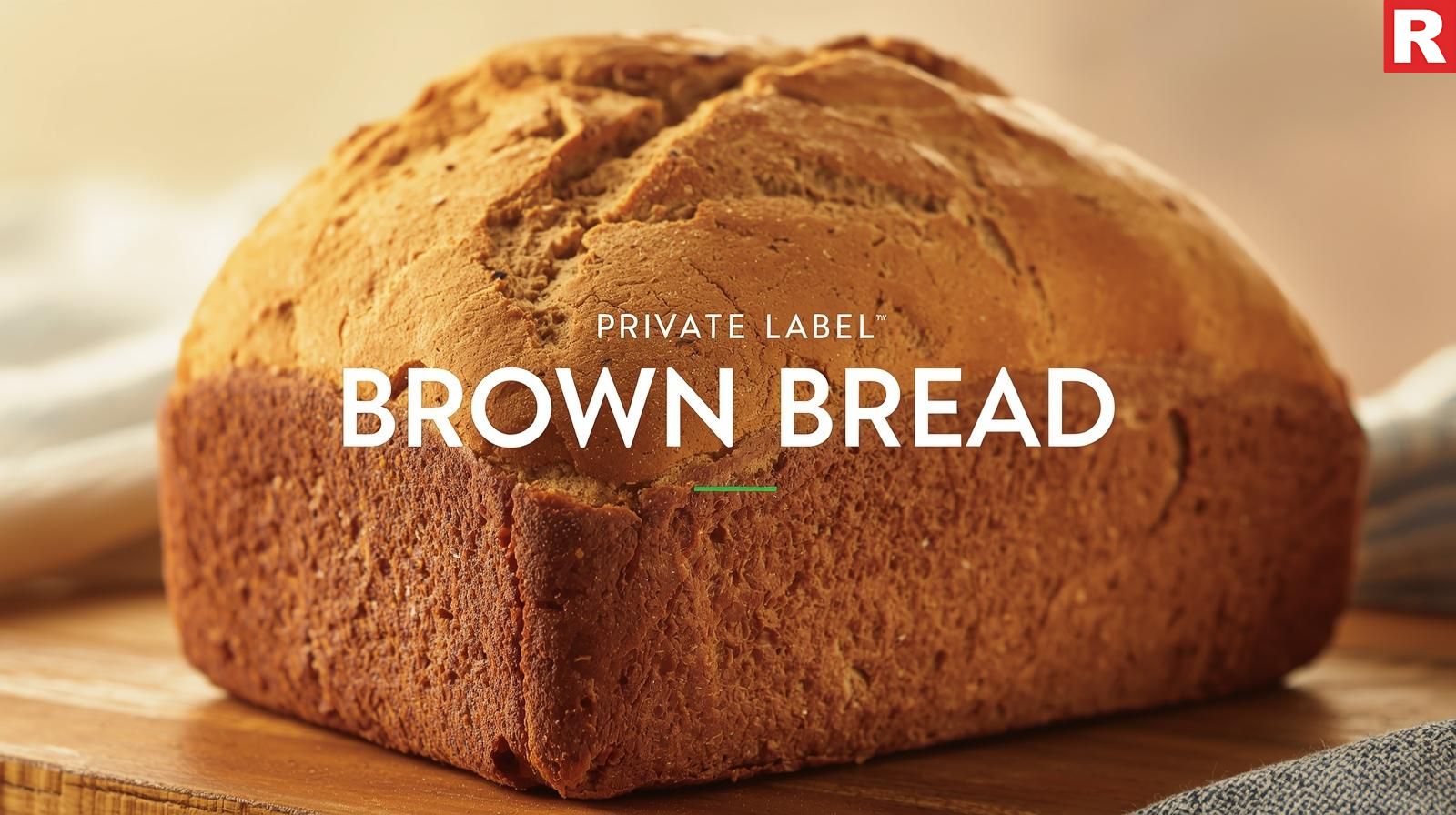
In India, a number of major supermarket chains, including Spencers, Big Bazaar, Reliance Smart, and others, sell brown bread under their own private label. Given their direct store-to-shelf service within their respective supermarket chains, these private-label brown breads are well-known for offering affordable, frequently fresh brown bread options. For regular supermarket shoppers, their prices are typically extremely affordable, providing exceptional value and convenient availability. Although whole wheat flour is typically used, it is always a good idea to look up particular information in the ingredient list because different retailers may have different formulas. For those looking for a convenient and reasonably priced brown bread to include in their weekly shopping, they provide an affordable choice.
Making the Right Choice
Customers in India need to balance awareness, taste, and practicality while selecting the best brown bread:
- Examine the Labels Carefully: Make sure "whole wheat flour" is listed as the first component on the ingredient list, and pay close attention to the amount of sugar and preservatives. Your main line of defense against "brown-washed" white bread is this.
- Think About Your Preference for Texture: Do you like a denser, more rustic loaf for a gourmet experience, or a very soft bread for regular sandwiches? Textural preferences are catered to by different brands.
- Availability Factor: How simple is it to find the brand in your area's local stores or online delivery services?
- Budget: There are several range of brown bread options available, from highly affordable to expensive, so be sure your selection is within your price range.
- Shelf Life: Naturally, brands with fewer preservatives would be less durable. Although this necessitates more frequent purchases, it frequently signals higher freshness and a "cleaner" product.
Read this: Best Flour Brands in India for Pizza & Bakery Restaurants
A Healthier Staple for the Modern Indian Diet
Due to customer demand for wholesome, whole-grain options, brown bread has become increasingly popular in India, marking a national health and wellness revolution. Alongside creative products from more recent, quality-focused firms, this selective pattern has led to the expansion of numerous reliable and affordable solutions from large competitors. Local bakeries and supermarket private labels add even more variety to the selection. The market currently meets all needs, whether one is looking for a product that is widely available, has a particular texture, uses high-quality components, or is devoid of preservatives. Making an educated choice enables customers to include whole-grain goodness into their diet with ease, signaling a long-term change in India toward mindful eating.

As the urbanisation of the Indian population increased, so did the concept of a healthy lifestyle and fitness, especially in urban cities. This notion is not just a passing trend made by social media, but an established movement. Ever since the emergence of COVID-19, Indian people have become actively aware of their health and fitness. A considerable portion of the public is actively seeking food that not only tastes good but also helps them achieve their fitness goals, as evidenced by the skyrocketing number of gym memberships, the rise in marathon participation, and the increased awareness of diet and well-being. This shift in Indian culture has created an opportunity for restaurateurs to transition from traditional Indian concepts to ones that combine delicious cuisine with nutrition for fitness.
This article serves as a guide that dives into the fitness-focused restaurant concept in India. We'll look at how to start a food business that caters to athletes, wellness believers, gym-goers, and busy professionals searching for healthy, transparent, and convenient meal options. From menu planning and smart marketing to creating a community center and cultivating a positive ambiance, this article will provide a detailed plan for success in a rapidly expanding market sector. By helping your customers reach their objectives, you will ensure that your business thrives.
Read more: Fundraising For A Restaurant: How it Works?
Understanding India's Growing Fitness Wave

Knowing your target market well is the first step in creating a profitable restaurant with a fitness theme. India's market for health and wellness is expanding due to several factors:
- Gym Culture's Rise: Even in tier-2 cities, fitness facilities, CrossFit boxes, and boutique studios are common. Their members are actively looking for balanced meals that are high in protein.
- Enhanced Health Awareness: As the relationship between diet and chronic illnesses becomes more widely recognized, more people are choosing foods with caution.
- Dietary Trends: People frequently discuss keto, paleo, vegan, gluten-free, and fasting between meals, and they are searching for restaurants that can accommodate these particular requirements.
- Professional Convenience: People with hectic schedules seek healthy, quick, and pre-portioned food options that work with their busy schedules.
- Sports & Performance: For peak performance and rehabilitation, both professional and amateur athletes need to follow a strict diet.
Keep in mind that your restaurant is offering an answer to these changing requirements in addition to food.
Know more: A Comprehensive Guide to In-house Restaurants in the Indian Market
A Customizable & Macro-Centric Menu for Fitness-Focused Restaurants

The foundation of your fitness-focused restaurant is the menu. It needs to be clear, flexible, and truly tasty.
Macro-Centric Meal Labeling: Labeling macro-centric meals is a non-negotiable requirement. The breakdown of macronutrients (protein, carbs, and fats) and the number of calories in each dish must be prominently displayed.
- For instance: "Grilled Peri-Peri Chicken with Quinoa & Roasted Veggies: 450 Kcal | P: 40g | C: 30g | F: 18g." Customers are then more willing to make choices that support their fitness objectives.
Create Your Own Plates or Bowls: Provide a part that is customizable so that customers can select:
- Proteins: Include light fish (such as salmon and basa), paneer tikka, tofu scramble, grilled chicken breast, and lentil and chickpea patties.
- Complex Carbs: Quinoa, Brown Rice, Bajra and Jowar Millets, Sweet Potato Mash, and Whole Wheat Pasta are examples of complex carbohydrates.
- Fresh veggies: A varied range of raw, grilled, or steamed seasonal veggies.
- Healthy Fats: Nuts, seeds, avocado slices, and olive oil drizzling are good sources of healthy fats.
- Clean Dressings/Sauces: Low-sugar chutneys, hanging curd dips, and mild vinegar dressings.
Targeted Meal Sections:
- High-Protein Power Meals: Recipes created especially to aid in muscle growth and repair.
- Low Carb/Keto-Friendly: Items with just a small amount of carbohydrates.
- Plant-Based/Vegan Delights: Creative and tasty recipes that suit plant-based diets.
- Pre & Post Workout Snacks: Snacks to eat before and after working out include energy bits, protein bars, fruit salads, and hard-boiled eggs.
Alternatives to "Cheat Day" (Healthy Treats): Serve comfort meals in healthier forms. For instance, baked "fries" prepared from sweet potatoes, whole wheat pizzas with lean toppings, or low-sugar treats that are high in protein.
Indian Flavors, Healthy Twist: Add traditional Indian flavors to nutritious foods for a healthy twist. Consider dishes such as "Tandoori Chicken Salad," "Palak Paneer with Brown Rice," or even "Spiced Lentil & Quinoa Patties."
Check out: Best Food Delivery Apps & Quick Commerce Platforms in India
The Future of Food Service At Home
Creating the "Wellness Hub" Ambiance & Space for Fitness-Focused Restaurants

A healthy lifestyle should be encouraged and supported by the physical surroundings of the restaurant.
- Clean & Energizing Design: Go for a contemporary, minimalist look. Make the most of natural light and include wood, stone, and a lot of greenery. Stay clear of clutter.
- Comfortable and Practical Seating: Offer a variety of seating arrangements, such as shared tables for large groups or individual tables for fast lunches. For short bites, think about getting some high stools.
- Positive & Uplifting Vibe: Play uplifting, inspiring background music at a comfortable volume, such as instrumental, light pop, or lo-fi beats.
- Information & Education: Take into account putting up a tiny whiteboard or computer screen that shows off health advice, the advantages of particular foods, or the achievements of nearby exercise enthusiasts.
- Retail Corner: Include a tiny retail area. Collaborate with nearby companies or fitness companies to sell:
- Bars and supplements of protein.
- Nuts, seeds, and dried fruits as healthy snack options.
- Branded goods (t-shirts, water bottles).
- Wellness magazines or cookbooks with a focus on health.
- Hygiene & Transparency: Maintaining flawless cleanliness is crucial. If possible, an open kitchen idea can demonstrate the fresh preparation and hygiene, building trust.
Strategic Marketing: Reaching Your Fit-Focused Tribe

Your marketing must be community-driven and extremely focused.
Hyper-Local Collaboration with Fitness Facilities & Gyms:
- Exclusive Discounts: Provide members of local fitness centers and gyms with exclusive discounts.
- Meal Plans: Work together to provide pre-ordered weekly or monthly meal plans that are customized to the objectives of their members.
- On-Site Promotions: Introduce your food by setting up a tasting stand at nearby gyms.
- Nutrition Workshops: Hold collaborative workshops on healthy eating at your restaurant or fitness center.
Strategic Content Marketing & Digital Presence:
- Instagram & Facebook: Your main visual channels are Facebook and Instagram. Share colorful, high-quality pictures of your cuisine along with macro analysis. Give behind-the-scenes looks, dietary advice, and success tales.
- Local SEO: Make your Google My Business page more visible by using keywords such as "gym food," "healthy restaurant," "keto-friendly," and "vegan options."
- Food Blogging/Influencers: Collaborate with nearby nutritionists, food bloggers, and fitness influencers who share the values of your business.
- WhatsApp Groups: Establish a specific WhatsApp broadcast list for daily deals, new menu items, or exclusive promotions, aimed at nearby fitness centers and health associations.
Events & Workshops in the Community:
- Organize Nutrition Talks: Ask local fitness instructors or dieticians to speak at your restaurant about nutrition.
- Healthy Cooking Classes: Provide courses that emphasize particular dietary cuisines or the preparation of healthful meals.
- Fitness Meet-ups: Give local yoga or running clubs a place to get together before or after their events.
Loyalty Programs: Establish a loyalty program that offers incentives for regular, healthful eating. Use the promotion "Buy 10 healthy meals, get 1 free smoothie."
What's new: How to Find Your Niche in the Restaurant World
Standard Restaurant’s Take on the Fitness-Friendly Meal Trend

The fitness-focused trend is not limited to customized cafes or committed wellness restaurants. Many traditional restaurants across India are using a smart move to capture the attention of a wide audience. They are incorporating healthy dishes into their menu to cater to health-conscious diners. With this method, they can maintain their original identity as a traditional restaurant and also embrace the modern demand for healthier options.
Here are some ways a standard restaurant can effectively combine fitness-friendly meals into its original menu:
- Menu Adaptation, Not Overhaul: Instead of a menu that is created from scratch, standard restaurants can offer lighter and healthier versions of their most popular dishes. For example, classic butter chicken made from less cream and more healthier meal. Biryani made with brown rice instead of white, or a fried appetizer, but grilled instead of fried. This gives customers a choice without altering the menu and creating dishes for only one group of people.
- Strategic Ingredient Swaps: Small changes can have a huge impact. Simple ways to make food healthier include using natural sweeteners like honey or dates in place of sugar, substituting white flour in rotis and bread with whole wheat or millets, and switching from refined oil to olive or coconut oil.
- Honest and Trust-Building Labeling: Including a tiny, obvious label on the menu designating "high-protein," "vegan," or "gluten-free" options shows that the establishment is dedicated to meeting the dietary requirements of a wide range of customers. Listing the calorie and macronutrient content, even if it is estimated, for important health-focused dishes greatly increases customer trust.
- A Dedicated "Healthy & Fit" Section: Restaurants may allocate a specific area on their menu for their healthier options as a "Healthy & Fit" section. Health-conscious customers can now easily locate what they want without having to search the entire menu or request changes. Nutrient-dense bowls, lean protein main courses, and special salads could all be found in this section.
- Seasonal & Special Offerings: Chefs might launch "healthy specials" on a weekly or monthly basis that showcase local, seasonal ingredients and creative, light cooking methods. This allows the culinary crew to try out new flavors and ingredients and keeps the healthy menu interesting.
Read this: The Pros and Cons: Comparing Franchise vs. Independent Specialty Restaurants
Conclusion
The fitness-focused restaurant concept in India is a response to a fundamental change in customer preferences, not just a passing trend. Restaurant owners can attract a highly motivated and expanding customer base by painstakingly creating a clear, adaptable, and delectable menu, creating a location that is motivating and focused on wellness, participating in focused community marketing, and making sure that everything runs smoothly. In addition to being a place to dine, your restaurant will play a significant role in your customers' journeys towards health and wellness by turning their meals into stepping stones to a better, fitter lifestyle and ensuring your own successful future in India's vibrant food industry.

In the past, health enthusiasts used to advise against eating any sugar at all if one wanted to become healthy or live longer. As the mere mention of desserts can frequently signal the idea of processed sugars, harmful fats, and caloric overload. People have long believed that if something tastes good, it must be bad for your health. Therefore, to become fit, one needs to let go of their cravings and sweets completely.
But what if the secret to truly tasty and healthful desserts lies in extreme simplicity? What if you could make a delicious, fulfilling treat with just five basic, healthy ingredients? This article aims to dispel the idea that healthy sweets are complicated, uninteresting, or require a cabinet full of unusual ingredients. We'll delve into the concept, investigate the power of strategic ingredient selection, and provide you with practical methods for creating
mouthwatering, guilt-free desserts that are as simple to prepare as they are to consume.
Read more: 4 Easy High-Protein Egg Recipe Ideas For A Post-Workout Boost
The Philosophy of 5-Ingredient Healthy Desserts

The concept of a 5-ingredient dessert is more than just convenience; it is a deep philosophy centered on embracing simplicity, emphasizing whole foods, and learning the actual meaning of "healthy."
Simplicity as a Strength
When you limit yourself to only five ingredients, each one must earn its spot. This limitation requires an emphasis on natural foods' unique flavors and sensations rather than relying on sophisticated processes or an array of chemicals. It promotes the idea that less is generally more—fewer ingredients usually equal less processing, fewer hidden sweets or bad fats, and a closer connection to the innate quality of what you're eating. This method simplifies both the cooking process and the nutritional content.
Focus on Whole Foods
Any truly nutritious 5-ingredient dessert is built on a foundation of whole, unprocessed foods. This includes prioritizing foods straight from nature, such as fruits, nuts, seeds, and natural sweeteners in their purest form. By avoiding refined flours, artificial sweeteners, and saturated oils, you can create a dessert from scratch that is high in fiber, critical vitamins, minerals, and good fats, rather than empty calories. This is the fundamental idea underlying wonderfully healthful dessert dishes.
What's new: Indian Spice Blends from Restaurant Chefs: Recipes, Techniques & Regional Masalas
Understanding the Concept of "Healthy"
In this context, "healthy" does not imply calorie-free or without sweetness. Instead, it refers to a nutritionally beneficial dessert, increases hunger, and promotes overall well-being. This involves actively reducing or eliminating refined carbohydrates, prioritizing healthy fats, and focusing on items that naturally contain fiber and critical nutrients. It's all about smart substitutions and mindful consumption, changing dessert from a guilt-inducing treat to a nutritious element of your diet.
Strategic Ingredient Selection
With only five spaces, each ingredient must serve several functions. A single ingredient may add sweetness, act as a binder, produce a lovely texture, or supply the major taste. This creates a strategic point of view in the kitchen, transforming you into a food planner who maximizes the possibilities of each option. This targeted approach is essential for making minimal-ingredient desserts that still deliver on taste and texture.
Know this: How to Run a Successful Hotel Restaurant in India: Strategies, Challenges & Growth Tips
Healthy Doesn't Mean Bland
Perhaps the most common misconception regarding healthy 5-ingredient desserts is that they must be bland or unpleasant. The purpose of this article is to prove the opposite. By cleverly blending naturally sweet fruits, rich nut butters, and aromatic spices, you can make treats that are deeply fulfilling, highly flavored, and pleasantly luxurious, debunking the myth that guilt-free desserts are always dull. Creativity within boundaries frequently produces the most innovative and tasty solutions.
The Core 5 Ingredients For Healthy Desserts
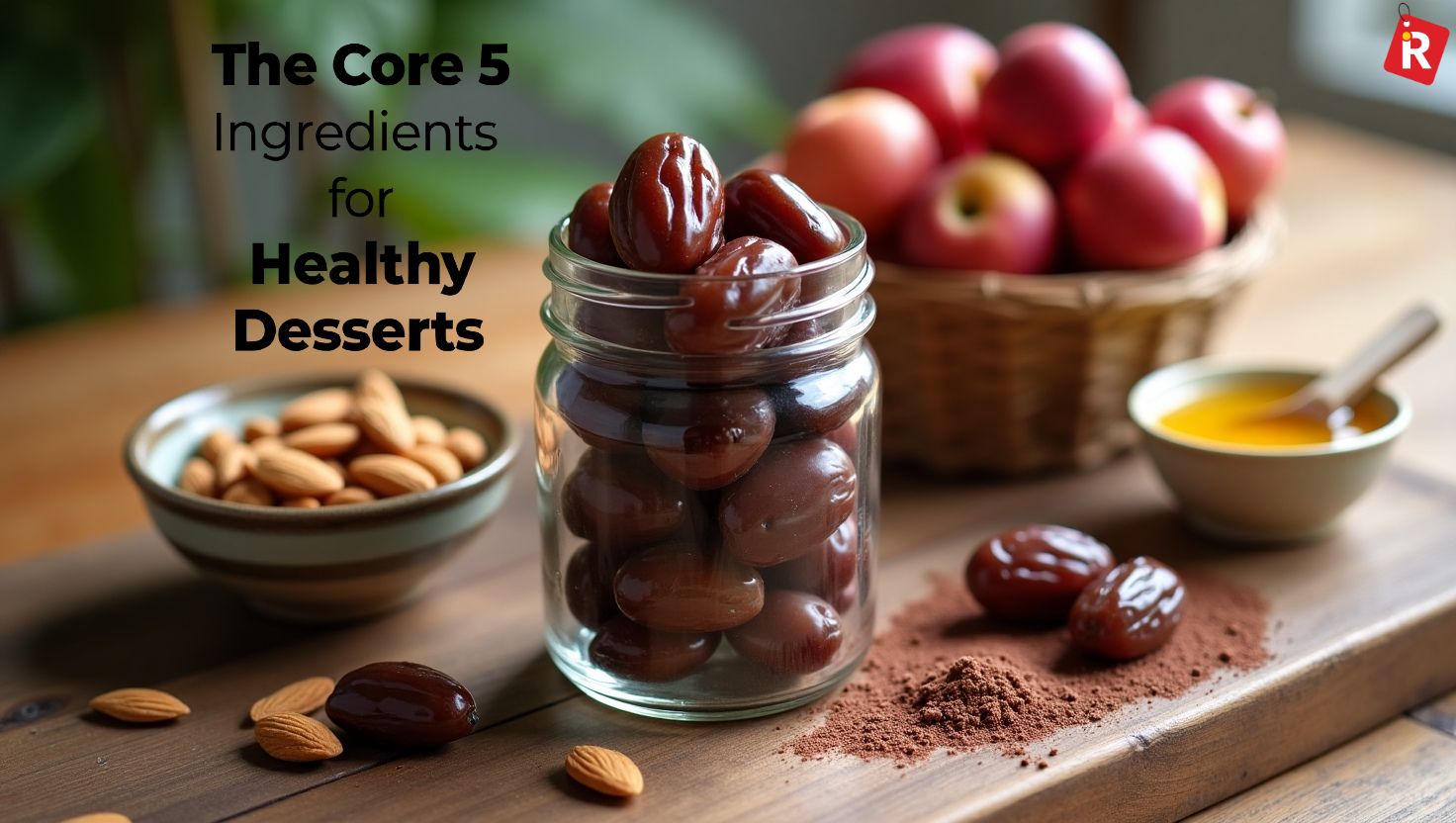
To properly master the art of 5-ingredient healthy desserts, you should first know the key ingredient categories that will make up your diverse toolkit. Consider these not as specific items, but as functions that various healthy foods can perform.
1. Natural Sweeteners
These are your go-to for providing wonderful sweetness without using refined sugar. Beyond taste, many have extra nutritional benefits.
Examples: Medjool dates (for natural caramel sweetness and binding), pure maple syrup, raw honey, ripe bananas (for sweetness and creaminess), and fruit purées (such as applesauce or mango pulp for natural sugars and moisture).
Role: Provides primary sweetness, can act as a binder, and increases moisture.
Considerations: Dates provide fiber and minerals, while maple syrup contains antioxidants. Even when using natural sugars, be aware of portion quantities.
2. Healthy Fats/Binders
These ingredients add richness, help to bind other ingredients together, and contribute to a satisfying texture, often containing beneficial fats.
Examples: peanut, almond, and cashew butters (for healthy fats, protein, and binding), avocados (for creamy texture and healthy fats), full-fat coconut milk or cream (for richness and dairy-free creaminess), and chia seeds.
Role: Adds richness, helps hold items together, and improves texture and satisfaction.
Check out: Different Types of Bars to Explore in 2025: Where Drinks Meet Vibes
10 Actionable Interior Design ideas for Restaurants
3. Flavor Foundations
These ingredients contribute to the overall flavor character of your dish, frequently adding natural sweetness and moisture.
Examples: Berries (strawberries, blueberries, and raspberries—for tartness, sweetness, and antioxidants), ripe bananas (for natural sweetness and a creamy foundation), mangoes, cocoa powder (for chocolatey undertones), and vanilla essence (for aromatic depth).
Role: Establishes the fundamental flavor, adding natural sweetness and moisture.
4. Texture and Fiber Enhancers
These ingredients provide a pleasing sensory contrast, such as a nice crunch or a chewy aspect, while also increasing fiber content.
Examples: nuts (almonds, walnuts, and pecans for crunch and healthy fats), seeds (chia, flax, sunflower, and pumpkin for crunch, fiber, and omega-3s), shredded coconut (for chewiness and tropical taste), and rolled oats (for chewiness and bulk, especially in baked goods).
Role: Textural variation, fiber addition, and moisture absorption.
5. Flavor Boosters
These little but powerful ingredients improve and balance the overall flavor profile without adding many calories or much weight.
Examples: cinnamon, cardamom, nutmeg, and ginger powder (for warmth and spice), a tiny teaspoon of sea salt (to improve sweetness and balance flavors), lemon juice (to brighten acidity), and other extracts (almond, peppermint) for specific aromatic notes.
Role: Enhances and balances primary flavors while adding aromatic depth.
Your Go-To 5-Ingredient Healthy Dessert Recipes

1. No-Bake Chocolate Energy Truffles
Ingredients
- Medjool dates: seeded, for natural sweetness and binding.
- Peanut butter: natural and unsweetened, providing healthful fats and creaminess.
- Unsweetened Cocoa Powder: Provides a deep chocolate flavor.
- Rolled oats: texture, fiber, and bulk.
- Pinch of sea salt: To boost sweetness and balance flavors.
Method: In a food processor, combine pitted dates, rolled oats, cocoa powder, peanut butter, and a pinch of sea salt. Process until a sticky, doughy mixture develops. Roll into little, bite-size truffles.
Enjoy: Refrigerate for a quick energy boost at any time.
2. Creamy Berry-Banana "Nice Cream"
Ingredients
- Frozen Ripe Bananas: Sliced for natural sweetness and creamy consistency.
- Frozen mixed berries: tartness, sweetness, and antioxidants.
- Full-Fat Coconut Cream: Use only the thick cream portion from a cold can for extra richness.
- Vanilla Extract: Provides fragrant depth.
- Pinch of sea salt: To improve the overall flavor.
Method: In a high-speed blender or food processor, add frozen banana slices, frozen mixed berries, chilled coconut cream, vanilla essence, and a pinch of salt. Blend until smooth and creamy, scraping down the sides as necessary. Only a small amount of coconut water or non-dairy milk should be added to get things moving.
Enjoy: For optimal consistency, serve immediately.
Know more: The Restaurant's Toolkit: Essential Apps, Resources, and Strategies to Organize Your Business
3. Simple Apple & Oat Crumble
Ingredients
- Apples: Sliced or diced (approximately one large apple).
- Rolled oats: For a crumbly topping and fiber.
- Maple Syrup: Adds natural sweetness to both fruit and toppings.
- Melted coconut oil: It is used to bind the crumble and add richness.
- Ground cinnamon: For a warm, aromatic spice.
Method: Preheat the oven to 180°C (350°F). Toss sliced apples with 1 tablespoon maple syrup and half the cinnamon, then place in a small oven-safe dish. In a separate bowl, combine the rolled oats, melted coconut oil, remaining maple syrup, and cinnamon to make a crumbly topping. Sprinkle the topping evenly over the apples. Bake for 15-20 minutes, or until the apples are soft and the topping turns golden brown.
Enjoy: Serve warm.
4. Avocado Chocolate Mousse
Ingredients
- Ripe avocados: peeled and pitted for smoothness and healthful fats.
- Unsweetened cocoa powder: provides a rich chocolate flavor.
- Maple Syrup (or Dates): Provides natural sweetness.
- Vanilla Extract: Used to enhance flavor.
- Pinch of sea salt: To balance sweetness and enhance chocolate flavor.
Method: Mix ripe avocados, unsweetened cocoa powder, maple syrup (or 2-3 soaked pitted dates), vanilla essence, and a pinch of sea salt in a high-speed blender or food processor. Blend until the avocado is smooth and creamy, with no lumps remaining.
Enjoy: Allow at least 30 minutes to chill before serving.
Conclusion
The art of dessert keeps evolving, demonstrating that enjoyment does not have to be at the expense of health or convenience. By embracing the wonderful simplicity of the 5-ingredient concept, you have access to a world of tasty, healthful treats that are easy to prepare, inexpensive, and well-suited to a health-conscious lifestyle.
It's about making wise selections with your main ingredients, allowing natural flavors to shine, and remembering that true luxury is frequently found in purity and harmony. So, the next time you have a sweet craving, don't seek processed foods. Instead, open your cupboard, select your five power ingredients, and set out on a delightful adventure of guilt-free enjoyment. It's about making wise decisions rather than making sacrifices and turning each sweet taste into a celebration of health and happiness.

Gen Z is changing Indian eating habits by demanding high protein without sacrificing flavor in everything from reels to actual meals. Today's young Indians are turning to traditional flavors and contemporary shortcuts to meet their macros without sacrificing taste or culture, even though protein shakes and boring grilled chicken still have a place.
These 10 high-protein Indian dishes are Gen Z-approved, full of flavor, simple to prepare, and anything but dull, whether you're a gym-goer, desk-worker, or someone simply trying to reach your daily protein goal.
1. Paneer Bhurji with Multigrain Roti

Protein: ~22g per serving
Prep Time: 15 mins
Best For: Post-workout lunch or quick dinner
Bhurji-style paneer, which consists of soft crumbled paneer mixed with a spicy masala base of tomatoes, onions, turmeric, and green chilies, is anything but boring. For freshness, squeeze in some lime juice and add some capsicum. To increase fiber and reduce glycemic load, pair with jowar or multigrain rotis.
Pro Tip: For a cleaner cut, use homemade low-fat paneer instead of regular paneer. For texture and extra protein, add crushed peanuts or hemp seeds.
2. Vegan-Friendly Soy Keema Tacos (Desi Style)
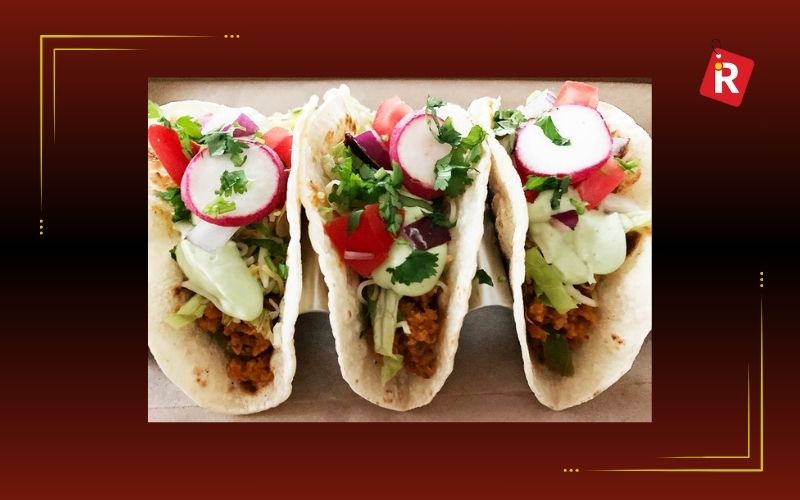
Protein: about 18g per two tacos
Ideal For: Snack boxes or meal-prep dinners
Although soy granules have no cholesterol and plant-based protein, they have the texture of minced meat. This spicy, juicy, and filling keema is made with garam masala, garlic, and onions. For crunch, stuff it into lettuce wraps or whole-grain tacos.
Pro Tip: For a naturally sweet, micronutrient-rich, and visually appealing taco filling that's ideal for gatherings, mix in some shredded carrot or beetroot.
3. Egg Chaat Bowl
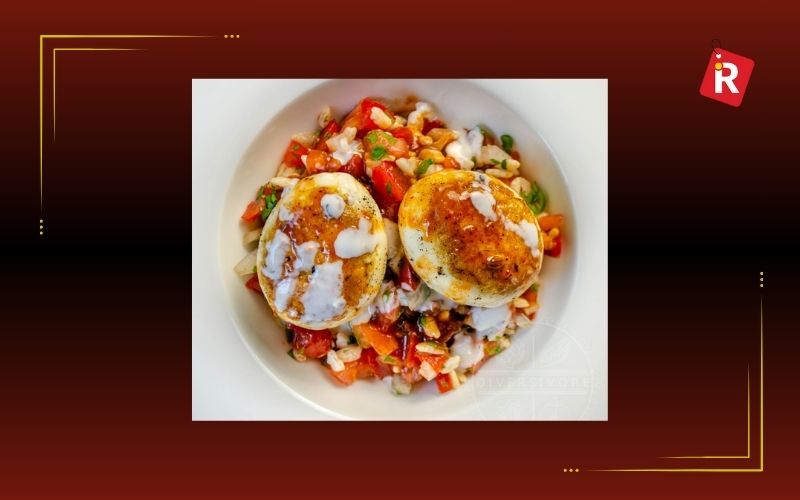
Protein: 12g of protein per two eggs
Ideal For: Lazy late-night meals or snack cravings
Chopped onions, green chilies, tomatoes, and coriander give boiled eggs a spicy chaat makeover. A 5-minute street-style protein bowl can be made by drizzling tamarind chutney or yogurt on top and adding some roasted chana or sev for texture.
Why It Works: The combination of protein and fat from eggs, the tang from the lime, and the crunch from the toppings quickly satisfies your hunger. Excellent for people who follow intermittent fasting as well.
4. Rajma Quinoa Bowl

Protein: Each bowl contains about 16g of protein.
Ideal For: Office tiffins or Sunday batch cooking
Rajma is more than just a comfort food; it's also a great source of iron, slow carbohydrates, and plant protein. For more amino acids and easier digestion, serve it over quinoa rather than rice. To make it a power bowl, add grilled vegetables or a soft-boiled egg.
Pro Tip: Enhance the flavor by tempering ghee with cumin seeds and hing. For a health-blog aesthetic, garnish with roasted flaxseed, microgreens, and hung curd.
5. Lettuce Wraps with Chicken Tikka
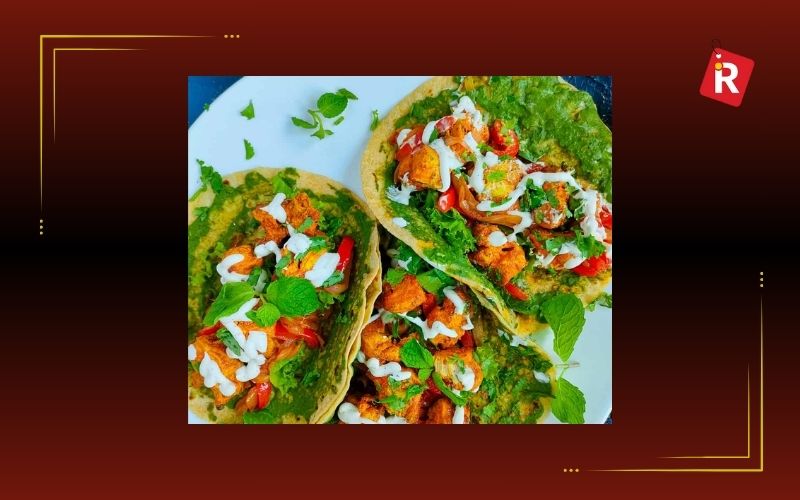
Protein: About 28g of protein per 100g of chicken
Ideal For: Weekend meal preppers, low-carb enthusiasts, and keto dieters
Pieces of perfectly roasted Tandoori-marinated chicken wrapped in crispy romaine or iceberg lettuce. Add sliced onions and coriander on top, then drizzle with mint yogurt dip. Full flavor, no carbs.
💡 Upgrade Idea: For a sweet boost, add pomegranate or grilled pineapple chunks. It also functions well in the cold, making it suitable for picnics and lunchboxes.
6. Stir-fried Chana Sundal

Protein: About 15g of protein per cup
Ideal For: Clean snacking, light meals, and Navratri fasts
Sundal, a temple-style snack from South India, is a simple, high-protein snack. Made with curry leaves, mustard seeds, fresh grated coconut, and kala chana (black chickpeas), it's incredibly filling, low in oil, and high in flavor.
Nutrition Add-On: To make it a total powerhouse, add baby spinach, sunflower seeds, or moringa powder.
7. Moong Dal Chilla with Stuffed Tofu
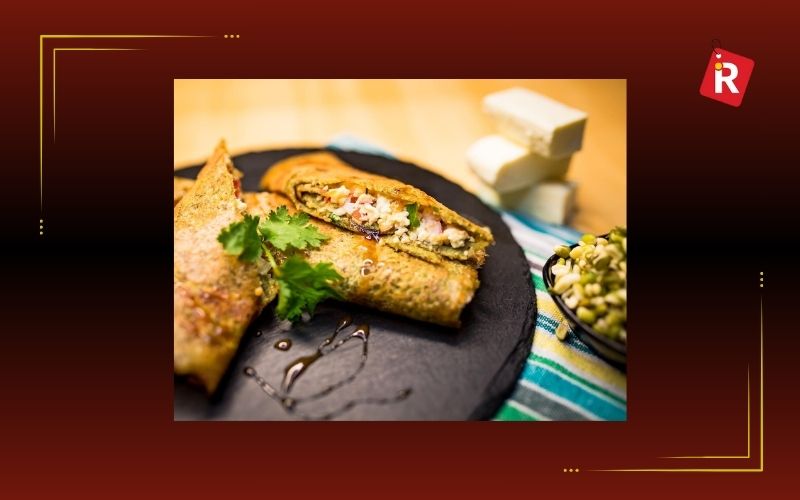
Protein: about 20g per serving (2 chillas plus tofu filling)
Ideal For: Post-workout snacks, college meals, and breakfast
Made from soaked moong dal, these flavorful Indian pancakes are naturally high in protein and free of gluten. Stuff with cheese and mashed green peas or sautéed tofu crumble. Each bite will provide you with complete protein, calcium, and fiber.
Elevate it: Serve with hot tomato garlic chutney, garnish with avocado slices, and sprinkle with sesame seeds. Your reel did indeed just go viral.
8. Fish Masala Bowl with Grilling

Protein: about 30g per 150g of fish
Ideal For: Brain days, keto eaters, and Sunday meal prep
Whether you choose to grill basa, salmon, or surmai, adding lemon, garlic, and a little tandoori spice results in a flavorful, flaky fillet that is high in protein and omega-3 fatty acids. Serve it with lemon pickle and sautéed greens over brown rice or millet.
Clever Add: Include hummus dip or a soft-boiled egg. Now you have an anti-inflammatory, macro-balanced meal.
9. Peanut Tadka with Sprouts Bhel
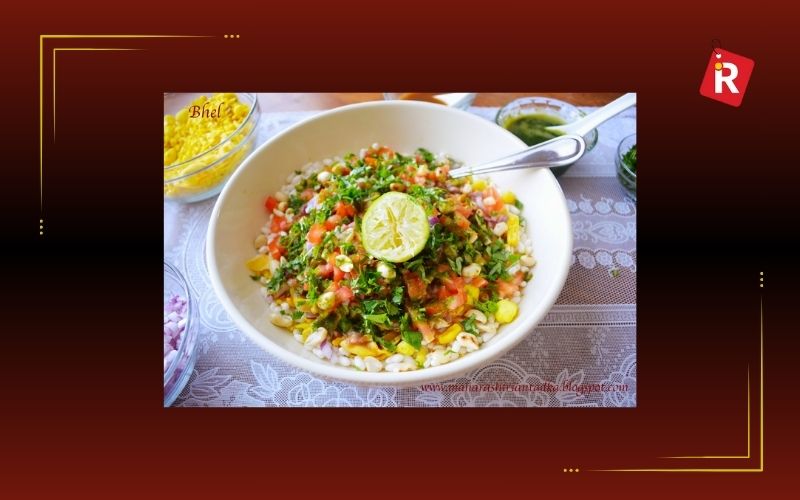
Protein: About 14g of protein per bowl
Ideal For: Detox days or evening snacks
This high-protein bhel uses sprouted moong or moth beans in place of puffed rice. Crunch, flavor, and gut health are all delivered by this dish, which is tossed with crunchy onions, tomatoes, cucumber, and lime and finished with a warm peanut tadka.
To make it a meal, top with paneer or crumbled feta and serve with boiled eggs. Serve warm with a ghee tempering in the winter or cold in the summer.
10. Grilled Tempeh with Curd Rice
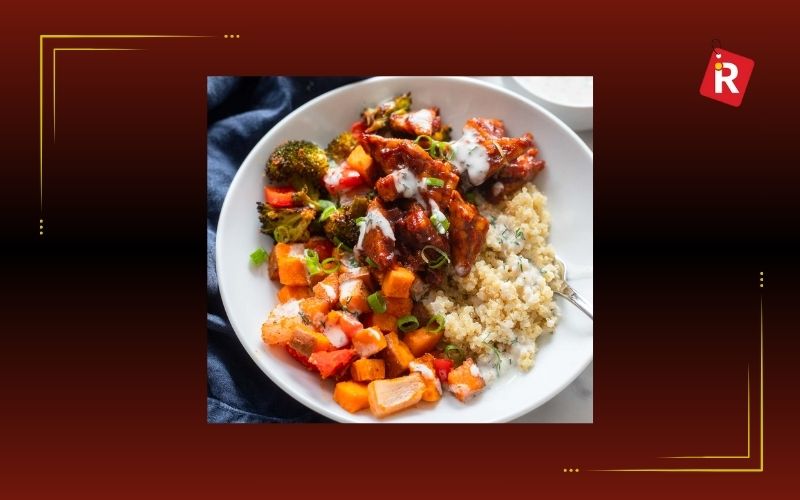
Protein: about 18g per plate
Ideal For: Light dinner days, gut resets, and recovery meals
India's go-to comfort food is curd rice, which is calming for both the stomach and the spirit. However, when combined with grilled tempeh (fermented soy cake) marinated in south Indian spices, you transform a simple dish into a powerful, protein-rich, gut-friendly meal.
Tempeh, why? It contains probiotics, is easier to digest than tofu, and provides all nine essential amino acids. This is all over Gen Z's wellness radar.
Why Gen Z Is Adoring These Dishes
- Instagrammable: These meals are shareable because of their vibrant colors, textures, and styling.
- Most take less than 30 minutes. Low Prep, High Reward
- Fusion-Friendly: Combine traditional and modern ingredients.
- Meal prep approved: excellent for cooking in large quantities
- Nutrient Dense: Equilibrium of fiber, protein, and good fats
Conclusion: The New Fitness Is Flavor
Young Indians today don't sacrifice flavor for health. They are discovering a middle ground: meals that are authentic, meet macro objectives, and honor culture. This list is only the start of a 100% Gen Z, high-protein, homemade food revolution.
This week, which will you try?

Many organs in our body are essential for our overall health. One of them is the Liver. This organ, located behind our rib cage, is a tireless powerhouse that serves as the body’s main detoxifying hub, a metabolic maestro, and an essential part of our immune system. However, in our current world, due to modernisation, our livers are under a great deal of strain because of the quantity of processed foods, environmental pollutants, and ongoing stress. Therefore, avoiding alcohol is not the only way to get our livers’ health back. We also need to intake nutrients that are good for liver health.
The good news is that there are many food products available in nature. When it comes to liver support, the idea of consuming superfoods (nutrient-dense foods with remarkable health benefits) is the best. These superfoods are rich in antioxidants, anti-inflammatory substances, and vital minerals. This helps in the liver's complex detoxification processes, shields its cells from harm, and enhances general hepatic health. As we are becoming more and more health-conscious, adding these top superfoods to our diet will be of great benefit to improve our body’s vitality.
After shedding light on the vital roles played by your liver, this in-depth article will identify the top 5 superfoods for liver health and explain exactly how each one helps to protect and improve this vital organ.
Check out: Ghost Kitchen: What is it?
Understanding Your Liver's Crucial Role
Hundreds of tasks that are vital to life and general health are handled by the liver, which is always operating in the background in silence. Its many varied duties are:
- Metabolism: The Liver serves as our primary metabolic center. So, almost everything we eat and drink is processed by it. The extra energy is stored as glycogen, and it transforms food components into forms the body can use, such as glucose for energy. Additionally, it breaks down proteins and fats to ensure that nutrients are used properly.
- Detoxification: The Liver is best known for its detoxification process. Toxins like narcotics, alcohol, metabolic waste products, and environmental contaminants are all neutralized and eliminated from the bloodstream by the liver, which functions as a highly advanced filter. It changes the toxic compounds into harmless ones that the body can eliminate through urine or bile.
- Bile Production: Bile is created by the liver, and it is a digestive fluid that is necessary for the breakdown of fats in the small intestine, the absorption of fat-soluble vitamins (A, D, E, and K), and the removal of waste.
- Storage: The liver also acts as a crucial storage space for critical minerals (copper, iron), vitamins (A, D, and B12), and glycogen, releasing them into the bloodstream when required.
- Protein Synthesis: The liver’s role in overall health is highlighted by the production of many essential proteins, such as albumin (which aids in maintaining fluid balance), blood clotting factors, and immunological proteins.
- Immune Function: Kupffer cells are specialized immune cells that create the initial line of defense in the liver. This defense line absorbs and eliminates dangerous bacteria, viruses, and other pathogens that enter the body through the digestive tract.
It's obvious that maintaining your liver through nutrition and lifestyle is not only advantageous but also crucial for preventing illness and promoting a healthy, active life, given its constant strain.
Top 5 Superfoods for Liver Health
Know this: Why Guests Choose third-party apps over direct ordering and how to win
1. Green Leafy Vegetables (e.g., Spinach, Kale, Arugula, Mustard Greens)

We all know how healthy leafy vegetables are. They are surely the undisputed kings of the nutrient kingdom, and their benefits are immeasurable for the liver. Green leafy vegetables have large amounts of chlorophyll, which is the pigment that gives these leaves their color. Chlorophyll is a powerful detoxifier. They are also rich in a spectrum of vitamins (A, C, E, K, B vitamins, folate), minerals (magnesium, potassium), and potent antioxidants. They also provide nitrates, which research suggests can help prevent fat accumulation in the liver.
Liver benefits:
- Toxin Neutralization: Chlorophyll aids in the neutralization of toxins, preventing pesticides and heavy metals from overpowering the liver.
- Enhanced Detoxification: They offer substances that actively increase the liver's built-in Phase I and Phase II detoxification enzymes, facilitating the liver's more effective breakdown and removal of toxins.
- Antioxidant Protection: Their strong antioxidant content guards against oxidative stress and free radical damage to vulnerable liver cells.
- Fat Reduction: According to some research, the nitrates in leafy greens may help prevent and treat fatty liver disease by reducing the buildup of fat in the liver.
- Better Bile Flow: Some substances can increase the production of bile, which helps with digestion and toxin removal.
How to consume: Include a lot of them in your regular meals. Blend them into soups and stews, add a few to smoothies, make colorful salads, or lightly sauté them as a side dish. For optimal enzyme and antioxidant content, raw ingestion is frequently recommended.
What's new: How Sprouts Can Help You Live a Better Life
2. Turmeric

Turmeric, which is a staple in traditional medicine and cuisine, owes its incredible health benefits primarily to a compound called curcumin. Curcumin is a polyphenol renowned for its exceptional anti-inflammatory and antioxidant properties. Its bioactive substances interact with several bodily molecular targets, including those involved in liver function.
Liver benefits:
- Anti-inflammatory Power: Curcumin aids in the substantial reduction of liver inflammation, which is a major contributing factor to the development of many liver diseases, such as hepatitis and non-alcoholic fatty liver disease (NAFLD).
- Antioxidant defense: It shields liver cells from oxidative damage brought on by pollutants and waste products from metabolism.
- Bile Production & Flow: Due to its choleretic qualities, turmeric promotes the generation of bile and aids in preserving a healthy bile flow, both of which are necessary for the breakdown of fat and the removal of waste.
- Detoxification Support: It helps the liver eliminate toxic chemicals by activating specific liver enzymes involved in detoxification pathways.
- Cellular Regeneration: According to some research, curcumin may help damaged liver cells regenerate.
How to consume: Use it generously in vegetable dishes, stews, and curries. For its health benefits, "golden milk" (turmeric latte) is a popular way to consume it. Supplements containing curcumin (typically with piperine or black pepper extract to improve absorption) are available for therapeutic dosages; nevertheless, before beginning any supplement treatment, always get medical advice.
3. Cruciferous Vegetables (e.g., Broccoli, Cauliflower, Cabbage, Brussels Sprouts)

Because of their special sulfur-containing components, these pungent vegetables, which belong to the Brassica family, are powerful liver aids. Glucosinolates, which are abundant in cruciferous vegetables, are broken down into physiologically active substances like sulforaphane and indole-3-carbinol (I3C) when they are chopped or chewed. They are also a great source of antioxidants, fiber, and vitamin C.
Liver benefits:
- Phase II Detoxification Boost: This is what makes them unique. The liver's Phase II detoxification enzymes, including glutathione S-transferase, are markedly increased in activity by sulforaphane and I3C. The body needs these enzymes to neutralize and get rid of environmental pollutants, excess hormones, and carcinogens.
- Antioxidant and anti-inflammatory: They help lower inflammation and shield liver cells from harm.
- Fatty Liver Protection: Consistent intake may help stop the buildup of fat in the liver.
How to consume: Eat them raw (like shredded cabbage in slaw) or roasted, steamed, or stir-fried. Compared to boiling, steaming them gently helps retain their healthy ingredients.
Read more: How to Effectively Market Your Restaurant
4. Garlic

Garlic is more than just a flavor enhancer; it has significant advantages for liver health and is a culinary and medical wonder. Allicin and other sulfur-containing chemicals, as well as selenium and other antioxidants, are abundant in garlic. Garlic's strong health benefits and distinctive scent are attributed to these chemicals.
Liver benefits:
- Enzyme Activation: Garlic's allicin and selenium are known to stimulate liver enzymes that aid in the body's detoxification process, enabling the liver to effectively remove toxins.
- Antioxidant Support: It shields the liver from oxidative stress by acting as a potent antioxidant.
- Glutathione Production: Garlic helps increase the body's production of glutathione, which is essential for liver cleansing and repair and is frequently referred to as the "master antioxidant" of the body.
- Antibiotic and Anti-Inflammatory Properties: Its natural antibiotic and anti-inflammatory properties support liver health and protection in general.
How to consume: Crush or chop the garlic and leave it for a few minutes before cooking so that the allicin can develop, for best results. Consume it raw in tiny amounts or add it to soups, curries, stir-fries, and dressings.
5. Berries
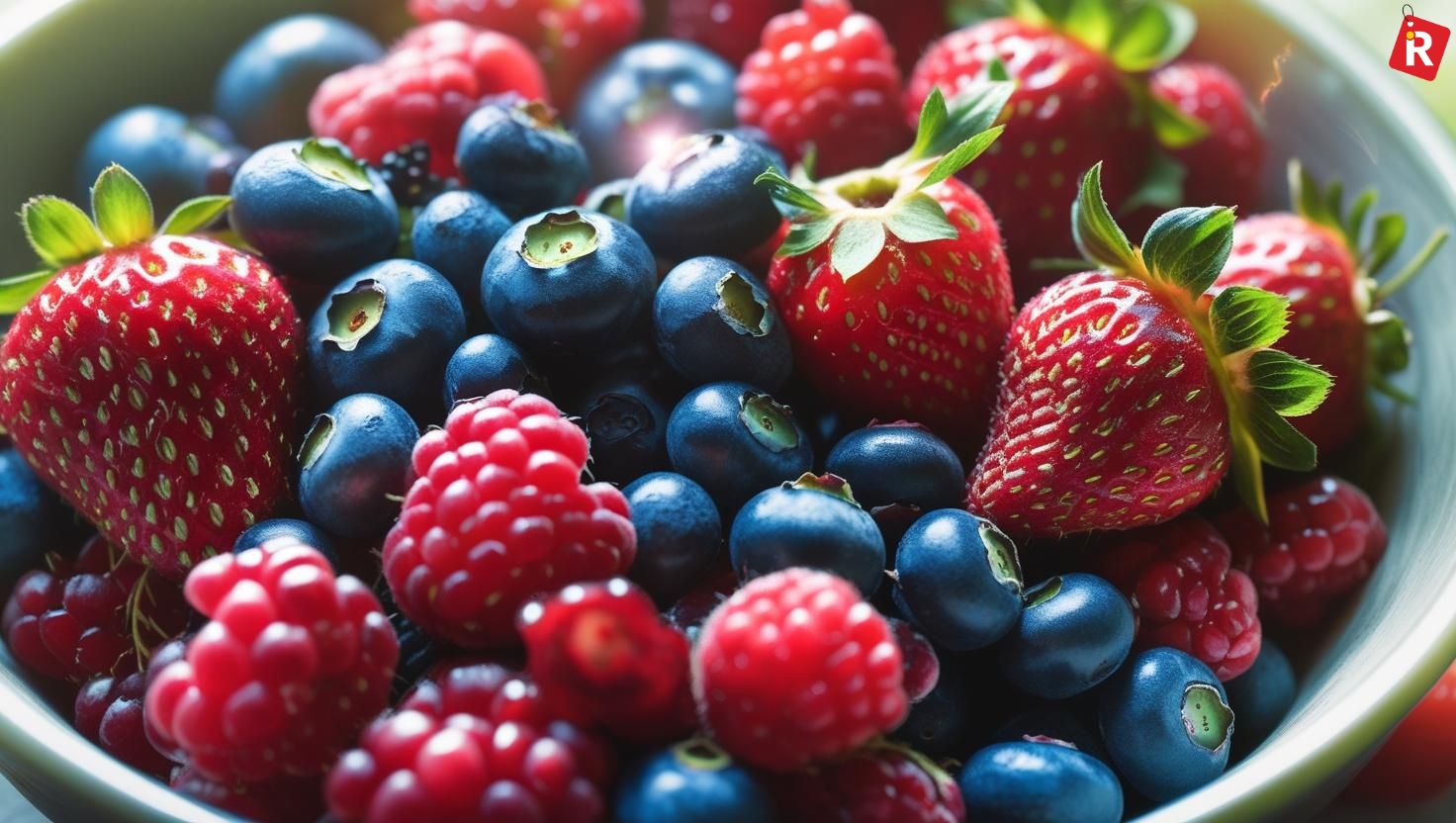
Any kind of Berries (e.g., Blueberries, Strawberries, Raspberries, Blackberries) are great for the liver since they are rich in antioxidant power. Berries are particularly high in ellagic acid, resveratrol, anthocyanins (the pigments that give them their vivid hues), and other potent polyphenols. They are also a great source of fiber and vitamin C.
Liver benefits:
- Protection Against Oxidative Stress: Berries' high antioxidant content helps shield the liver from oxidative stress and free radical damage, which can result in inflammation and liver disease.
- Reduced Inflammation: Liver tissue is soothed and protected by their anti-inflammatory substances.
- Increased Liver Enzyme Levels: Consistent intake has been associated with increased liver enzyme levels, which suggests enhanced liver health.
- Decreased Fibrosis: According to certain studies, berries' antioxidants may slow the development of liver fibrosis, or scarring.
- Overall Cellular Health: Berries indirectly improve the liver's capacity to carry out its numerous tasks by fostering cellular health throughout the body.
How to consume: Eat them raw or include them in nutritious desserts, smoothies, porridge, or yogurt. All year long, frozen berries are available and preserve the majority of their nutritious content.
Read this: A Close Look at Goa's Diverse Cuisine
Your Path to a Healthier Liver
The liver is a remarkable organ that works nonstop to maintain your health. You can strengthen its essential processes and shield yourself from a wide range of health problems by deliberately selecting to feed it the proper nutrients. Green leafy vegetables, turmeric, cruciferous vegetables, garlic, and berries are the top 5 superfoods for liver health because they provide a potent dosage of defense and assistance. Adopting these dietary allies is a tasty and proactive start toward a healthier liver and, eventually, a more vibrant and active you as we negotiate the challenges of modern life.

Strawberries are juicy, sweet, and a summertime favorite. Whether you toss them in a smoothie, layer them in a dessert, or enjoy them fresh out of the box, they always feel like a treat. But let’s be honest—these little red gems can spoil quickly. One day they’re bright and firm, and the next they’re mushy, leaking juice, or growing mold. It’s disappointing, especially if you’ve just bought a fresh-looking box expecting it to last a few days.
If this sounds familiar, you’re not alone. Strawberries are one of the most delicate fruits, and they require just a bit of extra care to keep them fresh. The good news is that with a few easy storage tips and tricks, you can extend their shelf life and reduce waste. Whether you’re buying strawberries in bulk for the week or want to make a weekend batch last longer, proper storage makes all the difference. From washing methods to fridge hacks, this guide covers everything you need to know to help your strawberries stay fresher, firmer, and tastier, bite after bite.
Read more: Why Should You Soak Mangoes Before Eating?
6 Common Fruits That Have the Highest Amount of Fibre: Your Tasty and Simple
Why Strawberries Deserve Better
Strawberries are delicate. Their skin is soft, and they absorb moisture easily. This makes them spoil faster than most fruits. On top of that, if one berry starts to rot, it spreads to the rest quickly. I’ve had to throw out full boxes of strawberries because I didn’t store them properly. After learning these simple tips, I rarely waste a berry. Let’s dive in.
Do You Wash Before You Store?
This is a common mistake. Washing strawberries right after buying them might seem like a good idea—but don’t do it. Moisture is the enemy here. Only wash strawberries when you're ready to eat them. If you wash them too soon, water can sneak into their skin and make them soft and moldy. Store them dry for best results. If you really want to wash them ahead of time, make sure you dry them completely with a paper towel before storing.
Know more: What Happens When You Consume 1 Avocado Daily?
The Secret Spa Treatment

This one changed how I handle strawberries. A vinegar rinse helps kill mold spores and bacteria that cause rotting.
How to do it:
- Mix 1 cup of white vinegar with 3 cups of water in a bowl.
- Soak the strawberries for 5 minutes.
- Rinse them with plain water.
- Dry each berry thoroughly with paper towels.
Once dry, store them in a clean, dry container. I tried this and my strawberries lasted up to 7 days without any mold.
The Paper Towel Trick (Your Strawberries Will Thank You)
This is one of the easiest hacks and works well. After drying the strawberries, line a container with a paper towel. Then gently place the strawberries on top in a single layer. Cover the top with another paper towel before sealing the lid.
The paper towels soak up extra moisture and protect the berries from getting mushy. This simple step has saved many boxes of strawberries in my kitchen.
Also check: What Is Caesar Salad, and Why Is It Named After the Roman Emperor?
These 7 Foods Can Help You Cool Your Stomach in Summer
Fridge or Counter? Let’s End the Debate
Here’s the rule:
- If you’re eating them the same day, keep strawberries at room temperature.
- If you want them to last, keep them in the fridge.
The fridge slows down the ripening process and mold growth. Keep the fridge temperature around 3–5°C (37–41°F). Don’t place strawberries near the back of the fridge, where it’s colder. They could freeze and turn mushy.
Freezing for Future Smoothies (or Midnight Cravings)
Sometimes, you just can’t eat strawberries fast enough. Freezing them is a great option.
How to freeze strawberries:
- Wash and dry them completely.
- Remove the green tops.
- Slice or leave them whole.
- Spread them on a tray lined with baking paper. Make sure they don’t touch.
- Freeze for a few hours.
- Once frozen, transfer to a freezer-safe bag or container.
Frozen strawberries are great for smoothies, desserts, and sauces. I often freeze a batch and use it for milkshakes or fruit bowls.
The Fancy Container Hack
Stop using the original plastic box. It traps moisture, which leads to mold. Instead, use a glass jar or a container with small holes for airflow. Even a glass bowl with a breathable lid works.
Personally, I use a wide-mouth mason jar lined with a paper towel at the bottom. I layer the strawberries and keep the lid loosely placed to allow air in. This simple change helped my berries last longer than ever before.
Berry Smart, Not Berry Sorry
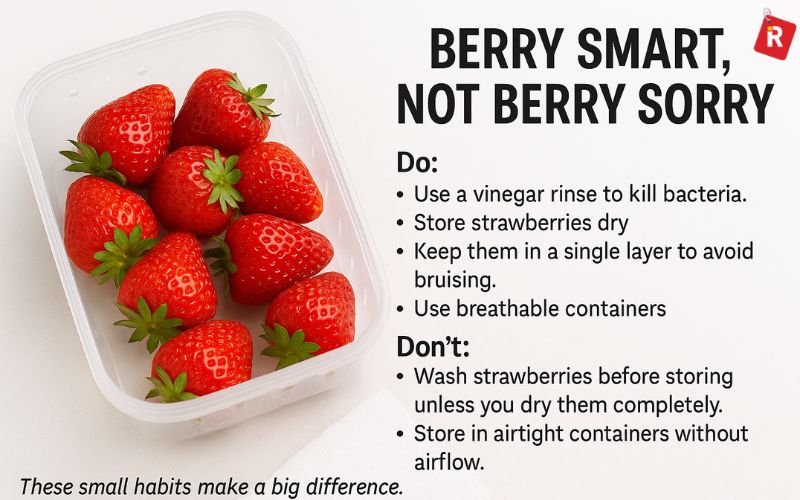
Here’s a quick list of do’s and don’ts to keep in mind:
Do:
- Use a vinegar rinse to kill bacteria.
- Store strawberries dry.
- Keep them in a single layer to avoid bruising.
- Use breathable containers.
Don’t:
- Wash strawberries before storing unless you dry them completely.
- Store in airtight containers without airflow.
- Leave them near strong-smelling foods (they absorb odors).
These small habits make a big difference.
Check more: 6 Benefits of Drinking Black Coffee
6 Unexpected Benefits of Eating Jackfruit (Kathal) – Nature’s Spiky Surprise!
Spot the Signs Before It Spreads
Strawberries can go bad quickly. Look for:
- Soft or mushy spots
- Mold (white or green fuzz)
- Leaking juice
- Bad smell
If one berry is bad, remove it right away. It can infect the rest. I check my stored berries daily and remove any soft ones to save the rest.
Rescuing the Almost-Too-Late Ones
Sometimes your strawberries are too soft for snacking but still usable. Don’t throw them out. Here’s what you can do:
- Make a quick jam with sugar and lemon juice.
- Blend into a strawberry sauce for pancakes or desserts.
- Add them to yogurt or oatmeal.
- Bake a strawberry cake or muffins.
These tricks help you reduce waste and enjoy strawberries in different forms. I often turn soft strawberries into homemade strawberry compote—it tastes better than store-bought jam.
The Bottom Line!
Strawberries are sweet, juicy, and one of the most loved fruits, but they spoil fast. Their delicate skin and high moisture content make them vulnerable to mold and mushiness. The good news? With just a little extra care, you can keep them fresh for much longer. Start by giving them a quick vinegar rinse to kill off bacteria and mold spores. Always dry them thoroughly before storing. Use breathable containers lined with paper towels, and place them in the fridge to slow down spoilage. Avoid washing them until you're ready to eat. Most importantly, check them daily and remove any soft or moldy ones to prevent the rest from spoiling. Whether you enjoy them as snacks, blend them into smoothies, or bake with them, these simple habits can help you reduce waste and enjoy every berry.

Diabetes has become a great issue for people all around the world. It is a condition that is caused by low insulin levels. Sugar is not converted to energy, resulting in a high rise in blood sugar levels. This can lead to many high-risk diseases in the future. While there is
Diabetes has become a great issue for people all around the world. It is a condition that is caused by low insulin levels. Sugar is not converted to energy, resulting in a high rise in blood sugar levels. This can lead to many high-risk diseases in the future. While there is
no cure for it, there are ways to control your blood sugar levels. That is, to maintain your diet. The best way to control your diet is to include fiber-rich foods in your meals.
Types of Diabetes:
- Type 1 Diabetes: The immune system attacks and destroys insulin-producing cells in the pancreas. It can occur at any age, but is mostly found in children and young adults.
- Type 2 Diabetes: It is a chronic condition in which the body cannot produce enough insulin as needed. It is mostly common in people over 40-45, however, new cases are being seen in young people due to being obese and having a poor diet.
- Gestational Diabetes: It occurs in pregnant women during their third or fourth trimester. It is a temporary condition and usually goes away after the birth of the child. However, it also increases the risk of Type 2 Diabetes in the future.
- Prediabetes: Blood sugar level rises but not enough for a Diabetes diagnosis. It can be considered a warning sign for the future.
Why Fiber-Rich Foods Are Good for Controlling Diabetes?
- Slows Down Sugar Absorption: Slows down the absorption of sugar in the bloodstream.
- Improves Insulin Sensitivity: Helps in managing glucose more effectively, as regular fiber intake can enhance the body’s absorption of insulin.
- Supports Weight Management: It lowers LDL(bad) cholesterol, reduces blood pressure, and Improves Blood Lipid Profile, helping in weight loss.
- Lowers LDL (Bad) Cholesterol: Certain types of fiber can help reduce LDL (“bad”) cholesterol levels
- Promotes Gut Health: Fiber-rich foods nourish beneficial bacteria, which in turn help produce compounds that support overall well-being.
- Reduces the Risk of Diabetes Complications: They stabilise blood-sugar levels, which prevents damage to vital organs and improves cardiovascular health.
Read more: Top 4 Ways to Use Betel Leaves for Daily Detox
There are two varieties of Fiber-rich foods:
Soluble Fiber
Soluble fiber dissolves in water, forming a gel-like substance. This gel has several important functions:
- Slows Digestion: It slows down the emptying of the stomach, which helps regulate blood sugar levels by preventing rapid spikes after meals.
- Lowers Cholesterol: It can bind to cholesterol particles in the digestive tract, preventing their absorption and helping to lower LDL ("bad") cholesterol.
- Promotes Satiety: The gel-like consistency helps you feel fuller for longer, which can aid in weight management.
- Feeds Gut Bacteria: It acts as a prebiotic, fermenting in the colon to feed beneficial gut bacteria, producing short-chain fatty acids (SCFAs) that have numerous health benefits.
Some common sources of Soluble fiber are:
- Oats and Oat Bran
- Lentils
- Fruits
- Vegetables
- Nuts and seeds
Insoluble Fiber
Insoluble fiber does not dissolve in water and remains largely intact as it moves through your digestive system. Its primary functions include:
- Adds Bulk to Stool: It acts as "roughage," increasing stool bulk and promoting regular bowel movements, which helps prevent constipation.
- Aids Transit: It helps food pass more quickly through the stomach and intestines.
- Supports Bowel Health: By promoting regular bowel movements, it contributes to overall bowel health and may reduce the risk of diverticular disease and hemorrhoids.
Some common sources of Soluble fiber are:
- Whole Grains
- Vegetables
- Fruits
- Nuts and Seeds
So, let’s take a look at 10 fiber-rich foods that can help in controlling blood sugar levels.
1.Legumes

Lentils, chickpeas (chana), black beans, kidney beans (rajma), split peas, and other beans are a source of both soluble and insoluble fibers. All types of beans have high nutritional value. They have high levels of complex carbohydrates and proteins, which help in the slow release of glucose. This helps to lower the blood sugar level. There are many dishes and ways to eat legumes. One can cook up a stew, or make dal with them, or eat them as sprouts. ½ cup of legumes contains 8 grams of Fiber.
Read more: 6 Common Fruits That Have the Highest Amount of Fibre: Your Tasty and Simple
2. Oats and Whole Grains

Oats are a great source of fiber, like beta-glucan. They are a soluble fiber food that helps control cholesterol levels and also slows down glucose absorption. Whole grains are unprocessed grains; that’s why they retain their bran and germ. They are also a good source of fiber and nutrients. There are many dishes created with oats and whole grains. For example, oats can be made into dalia, or made into a salad by adding yogurt and berries, brown rice pulao, and quinoa salads are some ways to eat whole grains
Read more: 5 Ways to Use Garden Cress Seeds (Halim) for Stronger Hair and Bones
3. Berries

Most types of berries, such as strawberries, raspberries, blueberries, etc. Have a good mix of both soluble and insoluble fibers. They are sweet, but have a relatively low glycemic index due to their high fiber content. They are also full of antioxidants, which help in the inflammation and oxidative stress that occurs with diabetes. Berries are already good in taste if eaten raw, but to enjoy your meal to the fullest, one can add them to yogurt, oats as a topping, or make a smoothie with them.
4. Leafy green vegetables

Spinach, Kale, and Fenugreek leaves are some of the leafy green vegetables that are high in fiber, vitamins, and minerals but low in calories and carbs. They are a type of insoluble fiber. They do not raise your blood sugar levels, but fill your stomach. Leafy vegetables are best enjoyed as smoothies, soup, saag (sarso, spinach, etc.), curries, or stir-fried.
Know more: What Happens When You Consume 1 Avocado Daily?
5. Apples

Apples are a good source of soluble fiber. But most of it is in the skin of the fruit. So if you are a diabetic, eat the fruit while keeping its skin intact. The skin contains pectin, which helps regulate blood sugar levels and reduces cholesterol. You can eat the fruit raw, or add it to a salad, or make a juice with it, or bake it. However, do not add sugar, as it will just ruin the purpose of eating the fruit.
6. Chia Seeds

Chia seeds are a superfood, especially when they comes to a diabetic patient. Its fiber content is exceptionally high, and the fiber is mostly soluble. It has omega-3 fatty acids and antioxidants. The seeds, when mixed in liquid and soaked for a while, create a gel-like substance that helps to slow down digestion and glucose release. To enjoy eating this superfood, add it to yogurt, oatmeal, and make a smoothie, or make chia pudding.
7. Flaxseeds or Linseeds

Flaxseeds are a source of both soluble and insoluble fiber. They have a very high fiber content. Similar to chia seeds, they are excellent for blood sugar control. They also provide lignans, plant compounds with antioxidant properties. They also have Omega-3 fatty acids. This helps the body fight inflammation. One tablespoon of flaxseeds contains about 2g of fiber. To consume flaxseeds, ground them and sprinkle them in your favourite dishes like cereals, yogurt, or add them to baked goods.
Read this: These 7 Foods Can Help You Cool Your Stomach in Summer
8. Nuts

Nuts like Almonds, Walnuts, Pistachios, etc., are a good source of dietary fiber. They do not have high calorie content, but they have a good amount of healthy fats, protein, and fiber. They help to stabilize blood sugar. They also provide the body with essential vitamins and minerals. They are also good as a light snack. Also, these crunchy nuts can be added to salads or oatmeal as toppings. However, keep in mind to control the portion as too much amount can affect your health.
9. Sweet Potatoes

Sweet potatoes are a good source of both soluble and insoluble fiber. Unlike white potatoes, they have more fiber but a low glycemic index, which helps to regulate blood sugar. Especially when the sweet potato is eaten with its skin intact. They are also rich in vitamin A and potassium. The fiber content of a medium-sized potato is 4 grams with skin intact. To enjoy eating a sweet potato, you can either steam it, roast it, mash it, or make a baked dish with it.
10. Broccoli and Other Cruciferous Vegetables

Vegetables like Broccoli, Cauliflower, and cabbage are a good source of insoluble fiber. These vegetables are a high fiber powerhouse. They provide vitamins, minerals, and compounds that help to reduce inflammation and oxidative stress. These are mostly non-starchy vegetables, and Broccoli also contains sulforaphane, which may help to reduce blood sugar levels. To eat these vegetables, steam, roast, or stir-fry them, or add them to soups or salads.
At the end
Incorporating these 10 fiber-rich foods into your daily diet is the first step towards better diabetic management. As diabetes is a condition that can never be cured, the only way is to manage it. Therefore, if you want to control your diet as a diabetic, be sure to be consistent with it. Start by making small changes, such as including nuts in your breakfast. Aim for at least 25-30 grams per day and increase the intake gradually.

As the global hospitality industry continues to grow, its environmental footprint becomes increasingly significant. Among the many sustainability challenges hotels face, the excessive use of single-use plastics in food service is one of the most pressing. From plastic cutlery and straws to condiment packets and cling film, these items contribute substantially to pollution and landfill overflow. However, with mindful strategies, hotels can pivot toward greener food service operations that benefit both the planet and their bottom line.
Why Reducing Single-Use Plastics Matters
Single-use plastics, designed for convenience, often end up in oceans, rivers, and landfills, where they take centuries to decompose. These plastics harm marine life, pollute ecosystems, and contribute to greenhouse gas emissions during production and disposal. For hotels, which serve thousands of meals annually, even small changes can have a major cumulative impact.
Furthermore, an increasing number of travelers are prioritizing sustainability. A 2023 report by Booking.com revealed that 76% of travelers want to travel more sustainably. By reducing single-use plastics, hotels not only demonstrate environmental stewardship but also align with consumer expectations.
Practical Steps Hotels Can Take Transition to Reusables
The most impactful solution is often the simplest: replace disposable items with reusable alternatives. Stainless steel cutlery, ceramic dishware, and glassware eliminate the need for plastic forks, spoons, and cups. For in-room dining or buffets, hotels can provide washable trays, plates, and utensils.
Although the initial investment may be higher, the long-term savings on disposable purchases and waste disposal make it economically viable. Moreover, reusables elevate the guest experience, reinforcing a sense of quality and responsibility.
Switch to Compostable or Biodegradable Options
Where reusables aren’t feasible—such as in takeaway services or for outdoor events—hotels can use compostable alternatives made from cornstarch, bamboo, or bagasse (sugarcane fiber). These materials break down much faster than traditional plastics and are less harmful to the environment.
It is important, however, to ensure that these items are actually composted. Hotels should collaborate with local composting facilities and clearly label bins for guests and staff to encourage proper disposal.
Eliminate Plastic Bottles and Straws
One of the most visible forms of plastic waste is the ubiquitous water bottle. Hotels can install filtered water dispensers in common areas and offer refillable glass bottles in rooms and restaurants. Many properties have also opted to provide reusable aluminum bottles as welcome gifts, reinforcing sustainability values.
Similarly, straws—often used once for mere minutes—can be eliminated altogether or replaced with paper, metal, or even pasta-based alternatives.
Rethink Packaging and Condiments
Small sachets of ketchup, butter, and sugar may seem convenient, but they generate immense plastic waste. Hotels can replace these with bulk dispensers or serve condiments in small reusable ramekins. For packaged snacks or minibar items, sourcing from suppliers that use biodegradable packaging can make a significant difference.
Engage Suppliers and Vendors
Hotels must work closely with their food suppliers to reduce packaging at the source. Opting for bulk purchases, reusable delivery containers, and minimal-waste supply chains helps reduce plastic before it even enters the property.
Suppliers can also be encouraged to shift to eco-friendly alternatives through sustainability clauses in vendor agreements.
Educate Staff and Guests
No green initiative succeeds without awareness. Staff should be trained on the importance of reducing plastic and the procedures for handling compostables and recyclables. Similarly, signage can guide guests on proper disposal and promote the hotel’s sustainability efforts. Offering behind-the-scenes tours, sustainability briefings, or even eco-themed dining experiences can further engage guests and turn them into brand ambassadors.
Monitor, Measure, and Communicate
Hotels should regularly audit their plastic usage and set measurable goals for reduction. Sustainability efforts, when transparently reported, enhance a brand’s credibility and attract eco-conscious travelers. Annual sustainability reports, social media updates, and third-party certifications like EarthCheck or Green Key can showcase these achievements.
Reducing single-use plastics in hotel food service is no longer optional—it’s a strategic imperative. By embracing reusable items, sustainable alternatives, and responsible sourcing, hotels can make meaningful environmental contributions while appealing to a growing demographic of eco-aware travelers.
The path to greener plates is paved with innovation, collaboration, and commitment. And with every plastic fork replaced or bottle refilled, hotels take one step closer to a cleaner, more sustainable future.

Black coffee is more than just a strong, bitter drink — it’s a powerhouse of health benefits. With no milk, no sugar, and almost zero calories, it’s a smart choice for anyone looking to stay fit and healthy. Whether you’re a gym-goer, a busy professional, or simply trying to cut down on unnecessary calories, black coffee can be your go-to drink. It boosts metabolism, helps burn fat, improves focus, and even supports heart and liver health when consumed in moderation. In India, where wellness is becoming a lifestyle, black coffee is quickly gaining popularity among celebrities, fitness influencers, and young working adults.
Many drink it before a workout for an energy boost or during fasting to curb hunger without breaking their fast. Plus, it’s rich in antioxidants that help your body fight inflammation and toxins. Simple, effective, and full of benefits — black coffee is the perfect daily companion for a healthier you.
Read more: 5 Best Coffee Beans in the World: Sips of Heaven You Can’t Miss
1. Boosts Metabolism and Helps Burn Fat
Black coffee is known for its strong caffeine content. This caffeine increases your metabolic rate. When your metabolism is high, your body burns more calories — even when you’re at rest.
This is why black coffee is often recommended before workouts. Fitness experts in India suggest drinking black coffee 30 minutes before hitting the gym. It helps you feel more energetic and improves your performance. You’ll also notice that you sweat more and burn more fat during your session. Black coffee is especially useful for those following workout routines like HIIT or yoga. It's a natural energy booster without the calories that come with milk or sugar.
2. A Natural Supporter of Weight Loss
Trying to shed a few kilos? Black coffee can help. One cup of black coffee contains almost zero calories. It also reduces water retention and helps flush out excess fluid from your body.
People who follow intermittent fasting — which is very popular among Indian professionals and homemakers — often drink black coffee during their fasting window. It helps suppress appetite and keeps energy levels high without breaking the fast. For best results, drink it without sugar. If you need some flavor, add a pinch of cinnamon or cardamom. These spices also help in digestion and metabolism.
Also check: Six Benefits of Starting Your Day with Okra Water
3. Improves Brain Function and Focus
Black coffee is great for your brain. It helps you stay alert and improves concentration. The caffeine in black coffee blocks a chemical in your brain called adenosine, which makes you feel tired. As a result, you feel awake, focused, and ready to take on the day.
Whether you’re a student preparing for exams or a working professional dealing with long meetings, black coffee can improve your mental performance. It also improves your mood and reaction time. In India’s fast-paced cities like Mumbai, Bengaluru, and Delhi, many young professionals are turning to black coffee to stay sharp throughout the day.
Know more: 12 Delicious High-Protein Foods to Eat Daily for a Healthier You
How Cloud Kitchens are Disrupting the Indian Restaurant Industry
4. Promotes Heart Health (in Moderation)
Black coffee contains antioxidants that are good for your heart. Studies suggest that people who drink coffee regularly, in moderate amounts, have a lower risk of heart disease and stroke.
It improves blood circulation and helps keep your blood vessels healthy. But the key here is moderation. Too much caffeine can increase your heart rate and cause anxiety. Stick to one or two cups a day. People in their 30s and 40s, especially those with stressful jobs, often find black coffee a comforting break. But it’s important to balance it with a healthy diet and regular exercise.
5. Helps Detox Your Body
Black coffee works as a natural detox drink. It acts as a diuretic, which means it helps you urinate more often. This removes toxins and unwanted materials from your body.
It also stimulates digestion and keeps your stomach clean. Many Indians who follow traditional diets or eat heavy meals find that black coffee after lunch helps reduce bloating. Unlike sugary drinks or tea with milk, black coffee doesn’t slow down your digestive system. In fact, it keeps things moving — in a good way.
6. May Reduce the Risk of Serious Illnesses
Drinking black coffee regularly may lower the risk of type 2 diabetes, Alzheimer’s disease, and even Parkinson’s. These diseases are on the rise in India, especially in urban areas where stress, poor diet, and sedentary lifestyle are common.
Caffeine helps protect brain cells and keeps your nervous system in good shape. The antioxidants in coffee fight inflammation, which is one of the main causes of chronic illness. Many studies from global and Indian medical researchers suggest that moderate coffee consumption is linked to a longer, healthier life. Again, the trick is not to overdo it.
Why Celebs Love Black Coffee
Many Indian celebrities, from actors to athletes, swear by black coffee. Shilpa Shetty often shares her black coffee routine on social media. Even Akshay Kumar, known for his strict fitness habits, includes black coffee in his daily diet.
These celebs choose black coffee not just for energy, but for its health and skin benefits. It’s a simple, fuss-free drink that fits well into a healthy lifestyle. If you're inspired by celebrity fitness, this is a habit worth picking up.
South India Got It Right
In South India, coffee is more than just a drink. It’s a tradition. While filter coffee is usually made with milk, the strong decoction used is very close to black coffee. People in Tamil Nadu and Karnataka have always appreciated the strong flavor of pure coffee. Now, the rest of the country is catching on. Cold brews and black coffee are becoming popular in cafes from Chennai to Chandigarh. The desi coffee culture is evolving.
What Happens 30 Minutes After Drinking Black Coffee?
Here’s a quick list of what black coffee does to your body within 30 minutes:
- Boosts energy
- Improves mood
- Enhances focus
- Starts fat-burning
- Increases physical performance
- Suppresses appetite
This makes it a great drink before work, before studying, or before hitting the gym.
Add a Desi Twist to Your Black Coffee
If you want to enhance your black coffee, try adding Indian spices:
- Cinnamon: Helps regulate blood sugar
- Cardamom: Improves digestion
- Cloves: Fights inflammation
- Turmeric: Great for immunity
These not only add flavor but also boost the health value of your drink. You can even make your own desi-style spice blend for coffee at home.
Sip Smart, Live Healthy
Black coffee is a smart, simple, and affordable drink with many health benefits. It helps with metabolism, weight loss, brain health, and even disease prevention. It fits perfectly into the modern Indian lifestyle — whether you're a student, a working professional, or a homemaker. But remember: moderation is the key. Stick to one or two cups a day and avoid drinking it late at night to prevent sleep issues. Start your day with a cup of black coffee — and sip your way to better health.

As we mark World Health Day, it’s the perfect time to reflect on how consumer awareness around food, health, and hygiene has evolved over the past year. The Godrej Food Trends Report 2024 had predicted a significant shift in consumer choices, with a growing focus on clean eating, ethical sourcing, and mindful consumption. Looking back, these predictions have not only come true but have also shaped the way India eats today.
With health and well-being at the centre of food decisions, consumers have become more discerning, choosing ingredients that nourish, sustain, and align with their values. The modern Indian family is now more personalized in its food habits than ever before, reflecting a strong commitment to health-conscious and sustainable choices.
Key Trends That Defined Consumer Choices Over the Past Year
Cutting Back on Ultra-Processed Foods (94.2%) – A Shift That Stuck
A year ago, 94.2% of experts had predicted that consumers would actively reduce their intake of ultra-processed foods, recognizing their health risks. Today, that shift is evident in the way Indian households are choosing fresher, minimally processed alternatives. From home-cooked meals to clean-label products, the focus on whole foods over convenience-driven, processed options has been a defining trend.
Supporting Local Farmers & Producers (90.4%) – A Conscious Choice That Grew Stronger
The emphasis on local, sustainable, and ethically sourced food was another key forecast in 2024, with 90.4% of experts predicting that Indian consumers would move towards supporting local farmers and producers. Over the past year, this movement has only strengthened, with more consumers making conscious efforts to buy fresh, seasonal, and locally sourced ingredients. Farmers' markets, farm-to-table initiatives, and hyperlocal sourcing have gained prominence, reflecting this growing commitment to sustainability and community-driven food systems.
The Rise of Clean & Safe Food Choices (78.8%) – A Hygiene-Driven Evolution
As projected by 78.8% of experts, food safety and hygiene have taken centre stage in consumer decisions. Shoppers have become more vigilant about ingredient sourcing, contamination risks, and the quality of packaged foods. The past year has seen a notable increase in demand for clean-label products, with brands responding by offering more transparency about their sourcing, ingredients, and safety measures.
The Climatarian Movement Gains Momentum (75.0%) – Eating for the Planet
With sustainability influencing food habits, 75% of experts had forecasted that consumers would adopt a climatarian approach—focusing on foods with a lower carbon footprint. This prediction has played out strongly, with more plant-based eating, reduced food waste, and an emphasis on seasonal, local produce shaping meal choices. From alternative protein sources to sustainable packaging, the food industry has evolved to cater to this eco-conscious shift.
Traditional Wisdom Meets Modern Convenience
Beyond these major shifts in food habits, the past year has also seen a resurgence of traditional dietary wisdom. As predicted, consumers have rediscovered local and ancestral food practices, blending them with modern convenience. From gut-friendly fermented foods to Ayurveda-inspired diets, the shift towards holistic well-being is now more than just a niche trend—it’s a lifestyle.

On April 7 every year the world observes World Health Day as a way to raise awareness regarding health challenges and motivate group efforts to address them. To increase awareness and drive worldwide action, the day is dedicated to a certain health issue each year. It highlights the necessity of international collaboration in addressing health issues and acts as a reminder of the significance of good health for personal well-being.
There is different theme in an effort to increase awareness and inspire global action every year. It highlights the need for international cooperation in addressing health issues and serves as a reminder that overall well-being depends on good health.
Going by the trend and the need to incorporate healthier options in their menu, chefs in restaurants are also working hard by using local, seasonal ingredients, farm-to-fork options, sustainable raw materials and everything and anything that gives back to the society in general.
Healthy is no More Boring
“As chefs, it’s our responsibility to craft menus that are both nourishing and indulgent. We are incorporating superfoods, cold-pressed oils, ancient grains, and Vegan alternatives, also we are innovating with techniques like sous-vide and fermentation to preserve nutrients without compromising on flavor,” shared Chef Altamsh Patel, Executive Chef at Hilton Hotels & Resorts by adding that wellness is the new lifestyle and there’s a shift in guest preferences toward health conscious dining.
Also, we see that 7 out of 10 people opt for a healthier options while dining at restaurant or ordering online, pushing these restaurants and chefs to innovate their menu.
“At Terrai, we’ve been seeing more and more people wanting to eat tasty food that’s also good for their health. So I started thinking — how can we bring that into our cooking without losing our roots? That’s why we added some new dishes to the menu, all made with health in mind. We’ve got Jonna Sundal, made with sorghum – light, high in fiber, and perfect as a snack. Our Millets Khichdi is full of nutrition and easy on the stomach — we use foxtail and barnyard millets for it. Then we have our Terrai Tacos, made with millet shells and filled with fresh veggies. The Amaranth-Coated Veg Cutlet is gluten-free, crisp, and made using amaranth seeds that we get from local farmer cooperatives. Even the millets we use are all sourced from small farmers and women-led groups in nearby villages. And my favorite, the Terrai Yam Kebab, is made with simple senagadda (yam), but full of flavor,” pointed Chef Rizwan of Terrai, Hyderabad by mentioning that these dishes are for anyone who wants to eat better — whether they’re watching their health or just want clean, local food. They keep it honest, tasty, and true to their roots.
What’s the Hype
Chefs are focusing on seasonal, regional, and hyper-local ingredients to create naturally nutritious dishes. They’re also using healthier cooking techniques such as grilling, steaming, fermenting, and slow-roasting. Menus are being curated with a thoughtful balance of macros and micronutrients to deliver a wholesome and satisfying meal experience without compromising on flavor.
“Innovations include introducing “meal-in-a-bowl” concepts that are portion-controlled and nutritionally complete, reducing or eliminating processed ingredients, incorporating complex carbohydrates and low-GI grains, and creating dishes centered around high-protein and plant-based proteins. Many chefs now actively collaborate with nutritionists and food science professionals to ensure their menus meet evolving health standards while still being delicious and engaging,” commented Celebrity Chef Ajay Chopra who is working with some of the top restaurants across country as a consultant.
Sharing his view on the same, Parth Saxena, Executive Chef at Arts Rooms, said, “A lot of chefs are focusing on fermentation, dehydration, and cold smoking to build flavor without relying on fats or excessive salt. Plant-based dishes have taken off big time, and not just for vegans; jackfruit tacos, nut butters or alt milk-based sauces are popular. We have used old grains like jowar in our jowar puffs or buckwheat for tarts. Even desserts are getting innovative like chia puddings, jaggery-sweetened bakes, or avocado mousse.”
He also pointed that in metros like Delhi and Mumbai, the demand for healthier food has grown massively, especially post-COVID.
“Personally, I have integrated things like vegan small plates and gluten-free breads and pastas on request. We are sourcing local, organic produce, some of us even have tie-ups with urban farms. And it’s not just about subtracting calories, it’s about adding value,” he added further.
As wellness remains at the center-stage, restaurants are also trying to put these elements on the plate. For eg; Niraamaya Retreats Backwaters & Beyond, Kumarakom has introduced curated ‘Ayurveda on a Plate’ menus inspired by Dosha-specific dietary recommendations. Guests can now enjoy a balance of flavor and function—with dishes tailored for Vata, Pitta, or Kapha. They also use foraged local greens and traditional cooking vessels like clay pots and stone grinders to preserve authenticity and enhance nutritional value.
“Our approach is deeply rooted in Kerala’s traditional culinary wisdom, but with a conscious shift toward wellness. We’ve reduced the use of refined oil, embraced slow-cooking techniques, and integrated millets, red rice, and seasonal vegetables into everyday dishes. Even our desserts use natural sweeteners like palm jaggery or dates, ensuring a guilt-free indulgence,” mentioned Arun Saseendran, Executive Chef, Niraamaya Retreats Backwaters & Beyond, Kumarakom.
Driven by Health-Conscious Customers
From fitness focused guests, to the modern traveler who values balance, sustainability, and culinary creativity on their plate and working professionals who are looking out for healthier choices as their go-to options have become the top clientele for these restaurant groups. Wellness has become a top priority across age groups, with people becoming increasingly aware of what they’re consuming and how it impacts their overall well-being. Millennials and Gen Z are early adopters of mindful eating, but older age groups are now actively embracing healthier choices as well. This shift isn’t limited to metro cities—urban and semi-urban populations are also showing growing interest in clean, balanced, and transparent food. As awareness spreads, the demand for health-focused dining continues to rise steadily.
"Younger generations are increasingly focused on health, sustainability, and ethical sourcing. They are often open to trying new plant-based options and are influenced by social media trends," added Chef Nagaraj of Koteshwaram Café – Bangalore.

Ever wondered why restaurants are coming up with diet-conscious, protein-rich, calorie-deficit meal option, keto or healthier food options in their menu? It is obvious, the demand for healthy food and health-conscious dining options in restaurants is rising, driven by increasing awareness of nutrition, wellness, and sustainability among consumers.
The shift towards healthier food in restaurants isn’t just hype. It’s a reflection of changing consumer priorities. Diner's today is making more informed choices, seeking food that not only tastes good but also aligns with their well-being. Whether it’s clean ingredients, balanced nutrition, or plant-forward menus, the demand is real and growing. Guests have become wary of what they put in their bodies.
What’s pushing the growth?
The market for healthy foods is expected to expand at a compound annual growth rate (CAGR) of 10.0% between 2024 and 2030.
“This is a significant trend in the Indian restaurant industry, with consumers, especially younger generations, prioritizing health and wellness. The market for health and wellness food and beverages in India is projected to grow significantly annually, driven by consumer demand and increasing awareness of health and wellness,” says Suresh Jogani, Franchise Owner, Quattro Bistro, Churchgate.
So, is it going to stay? This trend is here to stay as it definitely has results which people are noticing. Sometimes, it is a bit challenging to get 100% organic ingredients or seasonal produce which is at its peak of nutritional value. But people are trying to eat more healthier, local and seasonal option and to much surprise around 80% millennial prefer healthy eating with the changing lifestyle.
It’s a Global Change
One reason for this shift is awareness. We all know that people are very much involved in social media. People now know more about nutrition through social media, documentaries, and research. The pandemic also made many focus on their health. But meeting this demand isn’t easy. Finding fresh, organic, and sustainable ingredients costs more. Plus, making healthy food taste just as delicious as comfort food is a challenge for chefs.
Pointing out his views, Chef Harpreet Singh Bhatti, Head Chef at The Nest by Waikiki says, “The good news is that the market for healthy eating is growing fast. Plant-based foods, clean ingredients, and balanced meals are becoming popular worldwide. To keep up, restaurants can use local produce, try new cooking techniques, and make familiar dishes healthier.”
“Restaurants that offer tasty and nutritious meals will attract more customers. As a chef, I see this as a chance to be creative while serving food that makes people feel good,” emphasizes Bhatti.
The Foreseen Challenges
The shift comes with its own set of challenges for us restaurateurs. Ever thought what can be the challenges? Quality ingredients cost more, inflation adds to it, sourcing can be tricky, and for many, the perception that “healthy food isn’t tasty” still lingers. Sourcing seasonal ingredients can be one of the challenges as well.
“Restaurants also walk a fine line between catering to health-conscious customers and retaining their core audience. No business can survive for long without profits, and the health conscious has still not become the core audience yet in India. So, it becomes important for restaurants to work on their narrative, their story and truly convince the customer about the premium charged for such offerings,” points Vijeta Singh, Partner, Cobbler and Crew.
She adds, “As awareness around nutrition, sustainability, and overall well-being deepens, and health-conscious dining will become a baseline expectation rather than an added perk. The restaurants that recognize this and strike the right balance between health, taste, and experience will define the future of dining. The question isn’t whether this movement will last - it’s whether brands are ready to evolve with it.”
Restaurants can overcome these challenges by:
So, what can be done to improve or overcome further?
- Investing in efficient supply chain management
- Collaborating with nutritionists and chefs to develop balanced menus
- Educating staff about healthy options
- Implementing effective menu engineering and pricing strategies
Tech-Influence
Technology is evolving in every sector. The traceability of ingredients to know exactly when it was harvested and from where and the scanning nutrition data of a fruit will be seen more as we grow further. Al will play a big role in farming at grass root level to help producers get the best produce with what they have.
The Future
Healthy eating isn’t about missing out—it’s about enjoying food in a new and better way. Fresh and healthy is expensive, but processed and unhealthy is addictive. This trend is here to stay, driven by consumer demand and growing awareness of health and wellness.

Imagine if all vegetarians get a good source of protein through Soya chaap, that’s mouthwatering right? You don’t need to compromise with the taste and texture, at the same time you will be consuming pure quality soya as well. Meet the Founders and Brother-in-law Randhir Raj Singh and Tarunpreet Singh introduced their brand, “Gabru Di Chaap,” which specializes in soya chaap dishes.
The Brand Introduction
Founded in 2019, Gabru Di Chaap has their presence in 4 cities, with 25 outlets, while the store size is 80sqft. The brand is making waves with creativity and innovation. They have vegan chaap as well as 100% vegetarian chaaps, and their best-selling items are Dhaabe Wali Fried Chaap, Dilkash Mughlai Chaap, Dilli Wali Makhani Chaap, and Maharaja Malai Chaap. Other than soya chaaps, they have various food platters like Chole Bhature platter, kulchas, burgers and many more.
The Unique Selling Point
The brand's unique selling point is that they use contract manufacturing to make the soya from scratch, and each 100 grams of raw soya chaap contains 23% protein. The Mission is to make as a globally recognized and reliable brand in the next 5 years.
Meet The Founders
Randhir has done engineering in IIT Roorkee. He had also pursued MBA from Indian School of Business, Hyderabad. He has worked with Deloitte, Runnr and Bain. While Tarun is a graduate from Lucknow University, has done his MBA in HR from XLRI, Jamshedpur. He has worked with IBM and Deloitte.
The Financials of Gabru Di Chaap
The brand operates in all these models i.e. mall, food courts, dine-in, takeaways and cloud kitchens. They have dine-in of 66.66% and online ordering of 33.34%.
The prices of chaaps are from Rs220-230. The financials of the brand:
• FY19-20 – 1.09 Crores with 21 Lakhs EBITDA
• FY20-21 – 0.9 Crores with 3.3 Lakhs EDITDA
• FY21-22 - 2.09 Crores with 21 Lakhs EBITDA
• FY22-23 – 4.18 Crores with 24 Lakhs EDITDA
• FY 23-24 – 7.38 Crores with 61 Lakhs EBIDA
The Shark Tank Pitch
The company was valued at ₹70 crore, and the brand intend to grow outside of Delhi-NCR. They asked for ₹70 lakh for a 1% stake. However, not every shark was persuaded to make a Quick Service Restaurant (QSR) investment.
Tarun adds, “It’s easy to scale any brand from zero to 50 stores but scaling up from 50-100 stores or more which is sustainable and profitable is a challenge. We have 4.2 ratings on Zomato and Swiggy. We have become a household brand in Hyderabad. The brand had shut down 5 stores, due to franchise issues and SOP violations.”
Kunal Bahl doubted its widespread appeal and wondered if enough people would consume it regularly to support the business. Even less enthused, Aman Gupta acknowledged that he didn't consider chaap to be a go-to meal and that he hardly ever sought it. Peyush Bansal, however, was worried about the manufacturing process and hygienic conditions. He brought up a viral video that showed unhygienic chaap manufacturing, casting doubt on standards of quality.
The Breakthrough for the brand
What impressed the sharks was the company's resilience; unlike many restaurants that struggled during the pandemic, Gabru Di Chaap not only survived but thrived, growing its revenue from ₹1 crore to ₹7 crore. The founders projected revenue of ₹12 crore for the current year. They also highlighted a key differentiator—most chaap vendors use maida, whereas their product contains 23% soya. Vineeta Singh suggested they highlight this nutritional aspect rather than branding themselves as simply "premium."
The Winning Deal
Known for staying away from QSR investments, Peyush Bansal recognized their dedication to excellence. Even though he likes chaap, some of his family still think it's a non-vegetarian food, thus he acknowledged his personal issue. In spite of this, Peyush chose to defy his own rules and offered ₹70 lakh in exchange for 5% stake.
Anupam Mittal and Vineeta Singh expressed interest as well, so the founders asked whether they might work together. After deliberation, Peyush, Anupam, and Vineeta presented a combined offer of ₹1.4 crore for 6% equity, with a 1% royalty until their initial investment was recovered. The founders accepted the deal.
A New Chapter with the Sharks
With Three Sharks on Board, Gabru Da Chaap is all set to revolutionize the segment with the high-quality protein-rich soya chaaps. The brand plans to expand their reach in various locations and reach in new heights positioning this vegetarian category options.

Ever dreamed of an instant, healthy breakfast free from preservatives and maida? Sounds like a dream, right? Well, thanks to The Naturik, that dream is now a reality!
With our fast-paced lives, figuring out what to cook for breakfast every morning can be a hassle. But why stress when you have a protein-packed, nutritious option at your fingertips? The Naturik simplifies your mornings with a diverse range of healthy, convenient breakfast choices.
The Story Behind The Naturik
Founded in March 2023, The Naturik is the brainchild of Sahil and Isha, a visionary husband-wife duo from New Delhi. Their goal? To redefine Indian breakfast with high-protein, low-calorie, and preservative-free options.
“We wanted to create the healthiest and tastiest desi Indian breakfast brand that fits modern nutritional needs while keeping authentic flavors alive,” says Sahil. To bring this vision to life, the couple worked with award-winning chefs to perfect their flavors while maintaining nutritional integrity.
The Shark Tank Journey
Armed with a crystal-clear vision, Sahil and Isha took their brand to Shark Tank India, seeking Rs 50 lakh for 2 percent equity. Sahil’s17-year experience in FMCG gave them a strategic edge, helping them scale the business efficiently. Since launching, The Naturik has established a strong online presence, and by September 2024, expanded into 470 offline stores across Delhi-NCR—a steppingstone for wider geographical expansion.
Currently, the brand’s revenue is split evenly between offline (51 percent) and online (49 percent) sales, showcasing its balanced growth strategy.
The Numbers Behind The Naturik’s Growth
Despite facing a 12 percent EBITDA loss, The Naturik raked in Rs 87 lakh in sales in its first fiscal year (2023-24). However, things quickly turned around:
• Q1 of the next year: Rs 92 lakh revenue
• Q2: A massive leap to Rs 1.6 crore
• Projected FY Revenue: Rs 5.82 crore!
“Social media plays a massive role in our brand’s reach,” Sahil explains. The brand invests heavily in Instagram performance marketing and Amazon ads, with Sahil himself posting reels to engage audiences.
A Branding Wake-Up Call
Despite its success, The Naturik’s branding came under scrutiny from Shark Vineeta Singh, who critiqued its name, font, and packaging. “It looks like you haven’t put much effort into it. You need to work on this,” she advised.
Meet the Founders
Sahil Vohra—A commerce graduate and MBA from FMS Delhi, he has worked with industry giants like ITC, Britannia, and Walmart in leadership roles.
Isha Vohra—A seasoned HR professional with 12 years of corporate experience, Isha previously ran a QSR franchise (Tibbs Frankie) and introduced innovative food recipes.
The Shark Tank Bidding War
The Naturik’s pitch set off an intense bidding war among the Sharks. Initially, Sahil and Isha sought Rs 50 lakh for 2 percent equity, but the Sharks quickly upped the stakes:
• Aman Gupta: Rs 1 crore for 5 percent equity
• Kunal Bahl &Anupam Mittal: Rs 4 crore for 20 percent equity
• Peyush Bansal &Vineeta Singh: Rs 50 lakh for 2.5 percent equity
With multiple offers on the table, the founders saw an opportunity to bring all five investors on board. After some negotiation, the final deal closed at Rs 4 crore for 22.22 percent equity, bringing Aman, Anupam, Vineeta, Kunal, and Peyush together as strategic partners.
The Future of The Naturik
With five powerhouse investors backing them, The Naturik is gearing up for major expansion. Their strategy? Rapid offline retail growth and an aggressive push on quick commerce platforms like Swiggy Instamart, Blinkit, and Zepto.
“Expanding our retail presence is our top priority as we scale,” Sahil emphasizes. “With more Indians prioritizing health, we aim to be their go-to breakfast solution.”
What Sets The Naturik Apart?
The brand’s unique approach to shelf life is a game-changer. By reducing moisture levels to under 2 percent, Naturik products can stay fresh for up to a year without preservatives—even after opening!
With a mission to make healthy eating effortless, The Naturik is set to revolutionize India’s breakfast scene—one nutritious bite at a time.
A New Chapter with The Sharks
With five powerhouse investors on board, The Naturik is poised to scale new heights in the health food industry. More stores, more cities, and a bigger digital presence are in the pipeline.
The brand’s focus on quick, high-protein, and easy-to-make breakfast solutions aligns perfectly with the fast-paced lives of modern consumers. Their commitment to no preservatives and authentic flavors makes them a game-changer in the health food space.
“We’re not just selling breakfast—we’re creating a lifestyle,” says Sahil. “And this is only the beginning.”

In recent times, there has been a significant rise in the popularity of veganism and gluten-free diets. For ethical, environmental, or health-related reasons, some choose to adopt veganism, Keto or Gluten-free needs which involve avoiding all animal products.
But even with the increasing demand, grocery shopping can still be challenging for people on vegan, keto or gluten-free diets. Specialty products availability might be restricted, and searching for suitable options in the typical grocery stores can be a time-consuming and tedious task. Here's where food delivery services come into play, providing a convenient option for people following particular diets.
Healthy foods like gluten-free diets or vegan food items are delivered by the food delivery services is making it convenient for the consumers to consume during their busy lives. Food delivery services like Zomato, UberEats, Swiggy, Zoop, Rebel Foods and many others have healthy food options getting delivered at the customer’s doorstep.
Health On-the-Go
“Zoop simplifies online food ordering in train with easy access across various platforms, including its official website, WhatsApp, Google Chatbot, and Instagram, available in Hindi, English. Passengers can choose from a diverse menu, including Keto, Gluten-free Foods, Vegan, Italian, Chinese, North and South Indian cuisines and all the popular snacks. For those with special dietary needs, Zoop also offers Jain food and festive treats ensuring everyone can enjoy their favourite and even festive foods on train,” shared an official spokesperson at Zoop.
Offering Balanced Diets
“As more people prioritize their health and well-being, there's a noticeable shift towards mindful eating. Today’s consumers are not just seeking convenience—they're demanding nutritious options that align with their values and lifestyles, whether that’s vegan, keto, or gluten-free. According to Swiggy and Bain & Co’s report on ‘How India Eats,’ released in July 2024, India is expected to have 176 million health-focused consumers by 2026. In fact, 40% of consumers prefer to eat out at restaurants with healthy options, and 88% of active internet users in urban India manage their health through food choices,” shared a spokesperson at Swiggy.
He pointed that at Swiggy, they recognize this growing awareness and are committed to offering choices that are both diverse and nutritious. “Over the past year, Swiggy Guilt-free saw a significant 146% rise in vegan orders, with 70% of those orders being for vegan and guilt-free ice cream indicating the country’s tilting preference to continue indulging in their favourite dishes mindfully,” he added.
“Crafting these dishes goes beyond simply substituting ingredients; it’s about innovating recipes to provide the same, if not enhanced, flavours. Our vegan options, for example, are packed with protein and essential nutrients, while our keto and gluten-free meals are carefully balanced to meet nutritional needs without sacrificing taste. With advancements in technology and ingredient sourcing, we can offer more personalised, nutritious meals that align with individual health goals,” said Chef Vijay Pandey, Corporate Chef, Rebel Foods.
With the rising demand in healthy eating in India, it is quite evident that healthy eating in the busy lives will rise up in the coming years making it more popular among the consumers and it will increase in the food delivery market as well.

Your whole idea of visiting a restaurant is a big flop if the food served doesn’t meet the expectation. We have always praised the restaurant for its interior, food, quality, music and service and have seen restaurant owners taking all the praises for the work done; but have you ever thought how much effort a chef put to bring the best on the table. It’s all because of the creativity in the kitchen that a restaurant is all praise.
Ever since its inception by Late Chef Dr. Bill Gallagher in 2004, International Chef's Day has been as much about celebrating people in the culinary profession as promoting the importance of healthy and responsible eating.
What’s the significance
“International Chefs Day honours all chefs and their efforts to constantly serve the people through cooking and exposing them to food, cuisines, and link these with culture. It is celebrated on October 20, every year to give due importance to the noble profession and the professionals who bring in punctuality, sincerity and dedication, each day to their work. ICF, a member of WACS, was established in 1987, and has since then been bringing in the much needed awareness for the profession, respect to the culinary professionals, and unanimously driving the careers in the hospitality industry to the mainstream of coveted career options. It also celebrates this day with its Knowledge Summit and Chefs Awards,” shared Chef Davinder Kumar, President, Indian Culinary Forum.
According to Chef Vaibhav Bhargava, Partner, CHO, New Delhi, one of the most important aspects of International Chefs Day is to stress the importance of cooking and eating healthy foods. “International Chefs Day was instituted to remind chefs that it was their duty to pass on their knowledge and culinary skills to the next generation of chefs with a sense of pride and commitment to the future,” he added.
With focus on health and ‘healthy food’ as a theme as 2020, the chef’s day is being celebrated to promote healthy eating through chefs.
“A balanced diet is necessary for both good nutrition and health. You are shielded from a variety of degenerative non-communicable diseases, including cancer, diabetes, and heart disease. Our bodies receive all the necessary nutrients from the food we eat. Furthermore, none of these nutrients are found in junk food; they are only found in foods that are healthy. Even after being aware of this, people continue to be lured to eat junk food, which is why it's crucial to discuss eating healthy food,” pointed Chef Ashish Singh, Corporate Chef, Dhansoo Cafe, Delhi & Gurgaon.
Commenting on the same, Chef Vaibhav mentioned, “Having a strong immune system and eating “stress-busting” foods are important. We are living a hectic lifestyle where hearing about heart attacks has become a common affair, our stress, the lifestyles we lead all of it has an impact on it and it’s important to advocate healthy food now more than ever.”
For Chef Kumar, when it comes to availability of food, the gap between haves and have-nots has been widening. On one hand we have obesity and food wastage, and on the other hand the world has been fighting for zero hunger. Obesity and malnutrition both are dangerous for the future population. We were caught unawares by the pandemic. The only way to build immunity and stay on guard is to stay healthy. “Locally grown foods, foods less travelled, and seasonal foods are excellent for our health. These habits have to be inculcated in life as early as possible. This issue of unhealthy food habits cannot be tackled overnight; concerted and continuous efforts need to be put in to get people to eat healthy. The change in mindset when it comes to food consumption is very important, and the process has to start now,” he exerted.
Some healthy Kitchen Hacks by Top Chefs
Chef Vaibhav Bhargava: “For me that one thing, that I swear by always is - Add a little salt to everything and while you are in the process, the food is still getting cooked don’t forget to season and taste as you go.”
Chef Davinder Kumar: “As a five-star dining place, we cannot eliminate international cuisines altogether. Our guests come to us for that very global experience. We ensure that we buy locally grown produce, and there are quite a few things that we make from scratch. We consciously reduce the sugar and salt in our recipes and add other elements like herbs that contribute to the flavour without compromising on the taste.”
Chef Ashish Singh: “Instead of using hacks we need to use the simplest possible method of cooking any particular dish.”
Tips to share with young chefs:
Chef Vaibhav Bhargava: “Go to places where you want to work and wait for an opportunity there. Those are the places that are going to mold you into the chef that you will become. Be driven, but patient.”
Chef Davinder Kumar: “Research, read, and don’t be in a hurry to make a quick buck with gimmicks like amateur videos. These might come back to bite you in the future. Choose your idols wisely, because you’ll be unknowingly emulating them. Know to discern the genuine from the rest. There is no shortcut to success. Be honest, and work with integrity. Network, share ideas and experiences, and take every chance to learn first, keep practicing before you get to the implementing stage.”
Chef Ashish Singh: “All young chefs should be process and method driven and should understand and respect the ingredients being used. Their approach should basically be as simple as it can be.”

We’ve consumed good bacteria all our life. From dosas, idlis and dhoklas at breakfast, lassi after the lunches to the North Indian kanji in the winters, there isn’t much about the fermented food trend that should shock us Indians. We’ve been doing it for years. Yet, there is something to be discussed about the wave that food laden with good bacteria and yeasts has given rise to. Over the past few years, fermented foods have been inching into the limelight and gaining a lot of attention worldwide. While more and more people are becoming aware of the several health benefits; these foods are now openly experimented with.
Also Read: “Molecular gastronomy and the fermentation technique have always been in India”
In India, modern ferments are picking up. Restaurants and cafes such as Mumbai’s Olive Bar and Kitchen, Delhi’s Greenr Café and FabCafe, frequently organises fermentation workshops teaching rookies the basics of brewing kombucha and kefir, doing quick sauerkraut and so on. And Bengaluru has opened India’s first fermentary called Kobo, an e-shop dedicated to selling ferments only. Similarly, many new pop-up bakery shops like Mr And Mitts Bakery are experimenting with sourdough, and social media picking it up as highly nutritious food. One new restaurant in India that relies extensively on fermentation is the newly-launched Qualia in Mumbai.
According to Spoonshot’s proprietary data, between 2015 and 2019, interest in this space increased by 49.6 percent due to the associated health benefits. And the data predicts that the interest in fermentation will continue to grow because the technology meets the rising trend points which include health, wellness and sustainability.
“Ferment foods have existed in the Indian food repertoire for centuries, fermented foods consumed in moderation help with everything from aiding digestion, act as a natural laxative, boost immunity, boost gut health and weight loss. Now marketing wizards and nutritionists have started making fermented foods popular once more by using words like Probiotics, Gut Friendly, Weight Loss Management, etc,” Nachiket Shetye commented who is Mumbai-based hospitality professional with expertise across foodservice, restaurant consulting and culinary events and now a Co-Founder at Kytchens.
Food store shelves too are experiencing a rise in labels selling kefir and kombucha by artisanal producers like Zen Tiger, Bhu Kombucha and Atmosphere Kombucha. Then there are those who are making them and selling out of their homes, like Mumbai’s Bucha Bar. Others like Mo’s Kefir have a subscription service model too.
“It is good that people have started thinking about their health and diet plans which are of the essence in these days. People now are more aware and hence are extra careful about their heath by following specific diet plans,” Priyanka Tiwari, Founder of the Appumm House and Chairman & MD of Yaksha Hospitality said.
However, the roots of fermentation go back to Ayurveda, a 5,000-year-old tradition that emphasises the medicinal properties of food. Traditional Indian fermented foods contain probiotics and hence are also called Indian probiotics foods. Indian people find fermented food delicious and beneficial for health because they are rich in probiotics such as lactic acid bacteria and bifidobacteria.
Restaurant menus across the world are factoring in the trend for foods and turning their menu books to look similar to the ongoing buzz. “Fermented food is trending right now and hence it helps us to boost our sales,” said Tiwari who feels that nowadays, the restaurant business has become very competitive and owners felt the need to add fermented food to their menu because it reflects on their creativity and knowledge of the market.
Commenting on the same, Shetye added, “Lots of restaurants are using different cooking techniques and thus using fermentation as a technique to enhance their base ingredients, new dishes, unique mixes for their cocktail program and also introducing fermented food in desserts. Fermentation gives a unique taste to the food, adds aroma, subtle textures, makes food healthier and also aids in natural preservation.”
When breakfast plans are made at Shiv Sagar restaurant, the favorites are always the South Indian staples like the Idli, Wada, and Dosas. Many restaurants have agreed that by keeping south Indian dishes as a breakfast menu which includes fermentation, their sales do pick up.
“For the South Indians, it was a way to preserve the foods for longer in the tropical heat. These foods made from a fermented base are also a good way to start the day,” Vicky Bachani, Co-Owner of Shiv Sagar stated.
Majorly, fermentation is appealing to millennials as they are more open to experimentation and know the importance of preventive healthcare. Millennials have been exploring the trend and most of them seem extremely happy with the results. Dishes like kombucha, sour bread are pouring into Instagram feeds with millions of views and likes.
May Interest: Dealing with New Trends of Social Media Marketing
Fermented foods rest at the intersection of two huge trends, the demand for natural food products and foods that deliver added health benefits. And this is one of the many reasons why fermented food can be the next big thing.

2020 could be termed as ‘Year of Health Awareness’ and with this awareness we have seen many businesses change its colour. The COVID-19 pandemic has impacted the complete food and beverages industry and bakery industry is one of them. This pandemic has resulted into mass production shutdowns and supply chain disruptions which has also affected the economy as well. Similarly, we have seen that customers have also realized the importance of healthy eating and lifestyle, giving rise to an alternate of normal cake that we have been consuming for ages, and the result healthy, vegan and gluten-free cakes in the market.
Also Read: Bakery trends to watch out in 2021
“It's a myth that one could not get all their favorite dishes with healthy ingredients, Thanks to growing awareness among our audience. People are trying healthy ingredients to make their favorite food. It's an era where customers understand the importance of alternative flours as well, and the best part is it makes zero difference to the cakes,” shared Gunjan Batra of Bakehouse Comfort who has been customizing and baking cakes for customers as per their need and demand. “We are baking Vanilla Cake, Dates & Walnuts, Chocolate cake and more,” she added.
Commenting on the same Namita Zutshi of Namz Bakehouse who started baking during the pandemic said, “Its experimental, and I say all of us, the pâtissiers are amazing, to fuel the demand for healthy vegan cakes there is now a deluge of options right across the board. This truly is the year of mainstream veganism, all the trends and market feedback seem to point towards this, hence to cite one or more of the three principle motives for becoming vegan, animal sensibilities., environmental factors and personal health (the Covid pandemic has put the spotlight on this as never before).”
She further pointed that what is further pushing this trend is the incredible investments by VCs in this space, new business start-ups focusing on vegan products, cookbooks, YouTube channels, events and documentaries. The traditional food industry is desperately trying to catch up with the flourishing grassroots demand for Vegan products.
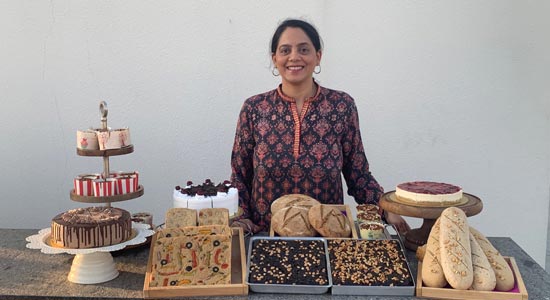
“Veganism or a plant based diet/lifestyle is gaining momentum the world over as it’s better for the health of our planet and is more sustainable. This pandemic has proven that we, as a race, need to make a shift in the way and rate at which we are using/abusing the natural resources, else it's not just more pandemics but other natural calamities may be waiting for us in the near future,” added Nutritionist and Dietician Kanupriya Khanna who is also the founder of Karamele that is all into healthy food products and cakes.
Targeting the right customers
According to a report by Data Bridge, Sales in the bakery aisle sector increased by 62.3% over the week ending March 15, 2020 and it has also been found an increase of approximately 44.3% for combined cookies and crackers in food sector. With people who are inclined towards adopting healthy lifestyle and willing to experiment new, healthier alternatives, these kind of trend is already pushing the growth not just in India but also at the global market.
“Overall, the health and immunity benefits of a plant-based diet are being widely recognised. To that end, even while indulging in dessert, which is traditionally considered sinful, some people look for vegan alternatives,” pointed Pragati Mitta, Chef at L’Opéra that has introduced a range of vegan products that include three flavours of vegan macarons, offered at the same price as the regular macarons at Rs 125.
The bakery café has also produce vegan tarts in chocolate and almond flavours and two kinds of vegan verrines, all of which are priced around Rs 250 to 300. Apart from these they have also recently developed a sugar-free pastry.

Replacing it with the best
There are variety of Flours like Almond Flour, Oats flour, Ragi flour etc that are nutritious and lends fantastic flavour and taste to the Cake as well. “We use almond, oak, Ragi and buck wheat flour. Also Maida or white flour can be replaced with whole wheat flour. Since whole wheat flour is light, we can add only half the required amount. Margarine and butter can be substituted with apple/maple sauce or prune puree. Refined sugar has absolutely no nutritional value, so we replace it with natural honey, jaggery, brown, raw or Demerara sugar to sweeten the cakes,” added Zutshi whose Almond Walnut Cake which is also gluten free is the top ordered food from the healthier menu.
May Interest: People are bias to old favourites in bakery: Survey
Priced anywhere between Rs 300 to Rs 1000, these alternative options have been attracting not only people who prefer healthy eating but also has become a huge hit among children, families who want to feed their children with new and healthier options.
Similarly, for Khanna, sorghum flour, quinoa flour or oats flour is a better replacement. “We use organic jaggery instead of refined sugar; rice bran or canola or olive oil instead of butter. Our food items are made either with almond milk or coconut milk instead of dairy. These ingredients are not only plant based but richer in nutrients as well,” she added by pointing that her orange cake, carrot cake, plum cake etc are some of the top ordered cakes depending on the time and festival.
Hence, we can say that in years to come vegan, healthier and gluten-free cakes wouldn't be an option, rather it will hit the restaurant and cafe business like any other trend that we have witnessed in last few years.

Food in India has changed a lot in last 2-3 years, from people looking at global brands as an inspiration, to more and more people adopting natural eating and Sattvic vegetarian food. Annakoot is an initiative to encourage people to consume pure and natural ingredients in their daily diet. Sattvic vegetarian food has proven its effects on the health of the human body for many years. “We, along with ISKCON Bangalore began this journey of offering pure healthy food to devotees and people. Our offerings are also ideal to be offered as prasadam,” said Amit Juneja of Annakoot that has grown to three outlets in just one year. Excerpts from the interview:

How the food at Annakoot is different from other restaurants. How much time did you spend doing research on the food etc?
The food at Annakoot is prepared with care. We do not use Garlic, Onion and Mushrooms in our food. We have worked closely with the chefs at ISKCON Bangalore to make food tasty in a sattvic way. Our chefs are formerly trained and also follow the sattvic way of life.
Also Read: "Annakoot – God’s Own Cuisine " launches 3rd sattvic restaurant in Delhi
How is the response so far?
We have received an encouraging response. Our patrons have been very happy and return on the regular to enjoy our food as well as purchase our FMCG products to gift or take home to continue their sattvic journey.

Realizing the goodness in Sattvic
The pandemic has made people realise the goodness in a sattvic and healthy diet. Consumers are adopting a healthy lifestyle and choosing pure and natural ingredients. This change in behaviour is welcome because sattvic food helps build immunity and keeps harmful problems at bay. We began providing sattvic food during the first lockdown. We ensure that all our ingredients are pure and natural. We do not use any harmful materials and always serve fresh.
Local is the new buzz
Locally sourced food is always more nutritious to the body. There is an added benefit in seasonal preparations, including fruits and vegetables. Seasonal foods have healthy things that can be of advantage to the body to manage with the different changes in the season. Local and seasonal is the best way for adopting a healthy lifestyle and for strong immunity.
What according to you will be the 5 biggest trends hitting the sector?
One of the biggest trends is natural ingredients. Another will be healthy seasonal food. Pure ingredient and fresh food are also gaining importance in recent times. Many people are also opting to eat at places that care about hygiene and offer wholesome foods such as Annakoot.
Must Read: 5 Food Trends that will Change the Food Service Game
Who are you targeting as your customer at Annakoot?
People who are keen on having a healthy diet and one who believe in the sattvic way of life. A person that is also a devotee at ISKCON.
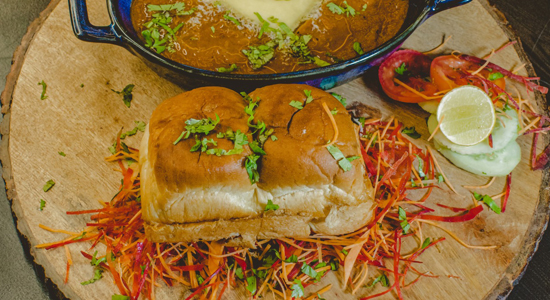
What’s your expansion plan?
We would like to expand to 108 outlets in the coming years. We were fortunate to have the support of the people and expand to 3-outlets in a short period of time. 108 is a number we aim for as it is the ideal chant count.

In the current state of the global pandemic, the online delivery business has seen such an outgrowing growth. According to the latest food delivery statistics, it is one of the fastest-growing industries. This doesn’t come as a surprise, as food delivery is convenient, saves time, and helps in avoiding unnecessary social interaction.
The food delivery business gaining popularity in such a short period of time has given a boost to the subscription-based model. Subscription-based or meal kit delivery services are one of the newer additions to the food delivery industry capturing a decent share of the overall business. According to Statista, the meal kit industry was valued at $4.65 billion in 2017. The very next year it blew up with a 300 percent increase. Estimates for 2022 are that the market will reach $11.6 billion globally.
Also Read: Why subscription based model is biggest disruptor of today's delivery trend
First and foremost, a subscription means added convenience for the customer. In India, the idea of meal subscription is an age-old concept. We always had dabbawalas, delivering fresh homemade meals to the office goers or the students. Taking it one notch up, now we have a number of subscription meal services that deliver fresh, healthy meals to the doorstep and even customize them to one’s specific dietary needs. FoodDarzi, Healthie, GourmetBox, Masalabox, EatFit are some of the market players in India.
“It is true that as the pandemic hit the nation, the F&B operators adopted various ways to stay afloat and survive the crisis efficiently. In my opinion, meal subscription plans have definitely been an interesting initiative that we saw from several restaurateurs,” said Mihir Mehta, A Mumbai-based Investment Banker at Ashika Capital stated who has successfully executed transactions In the F&B space in India amidst Covid-19.
What does it mean for the business owners?
Once the customer places an order, the likelihood of ordering again from the same place is very much higher in the case of a subscription. When volumes are compared, the revenue generated by the subscriptions is way more than a single business transaction. A subscription model can also provide a good cash flow for the business. Instead of an estimate, the owner can be fairly accurate and expect the amount he/she will have in hand.
A subscription-based food delivery model can be feasible due to the low investment cost involved. Also, it comes with high operational efficiency due to fixed orders. Moreover, one can easily lower down the delivery cost if the number of orders is pre-confirmed for each day.
“The demand is definitely on the rise because people have become more health-conscious. They want to eat and stay healthy and hence choose products and brands that guarantee health, fitness, and safety,” shared Sakshi Bakshi, Founder of Nucros Science & Taste. She also informed that through the subscription model, the company has saved on inventory and logistics resulting in an increase in profit share.
While their meal subscription plan is available only in Delhi/NCR right now, Bakshi’s future plans include expansion in PAN India with subscribers across the country.
Apt for present consumer need
With time and technology, the need for customer-centric and sustainable models has grown drastically. Today, users want a meal plan personalized to their dietary needs and in quantity enough for one-time consumption to avoid any food wastage.
“For a successful subscription-based business model, it is very important for a provider to consider cost-effective measures of every customer as it differs drastically with every order,” said Aditya Bafna, founder of Nashik-based Nutridock Kitchens.
Nutridock, a healthy subscription-based as well as food delivery start-up, has announced its expansion plans with an aim of opening 50 stores/kitchens by 2022 to offer sustainable and accessible meal plans to a wider audience.
The on-demand food industry runs on the premises of sustainability and cost-effectiveness and only those adhering to the two norms can make it in the long-term. Over time, subscription models have proven to be feasible in the long run as there is less anticipation and there are no redundant processes involved since every order is pre-planned.
Hurdles to overcome
However, for Mehta, the potentiality of meal subscription plans is debatable. “There are elements like high price sensitivity (since it is a recurring expense for the customer), limited menu engineering, streamlined logistics, low margin high volume strategy, etc. that ideally determine the success of this model,” he added.
To make meal subscription plans a sustainable business vertical, it is pertinent to work and overcome the above-mentioned challenges and that is a daunting task to integrate with the DNA of an already established restaurant business. “This was also witnessed during the pandemic as multiple restaurateurs struggled to metamorphose this initiative into a full-blown business,” Mehta informed.
May Interest: Food delivery platform Swiggy revamps 'SUPER' subscription service
With a strong IT backend, it becomes imperative to keep track of the enormous data generated by the customers that can be used to make better marketing plans, monitor buying preferences, and run promotional campaigns.

“Food has always been my fashion to eat and cook,” shared Bharti Sanghai who always loved the age-old recipes and thought of bringing down the traditional food into the new twist with a little bit of a blend as these recipes are passed on through generations. The name ‘HOME ALONE FOOD’ was given by her husband. She started with a little bit of home cooking and people started appreciating them. “Slowly I started by styling pickles and mathri and different kinds of namkeens at home. Some people suggested me to take my indoor cooking into the market as people love traditional food that tasted like home and that’s how the brand was born,” she added. Excerpts from the interview:
With time we have seen that people are going back to their roots. Why has a sudden change as in the last few decades we have talked about being global a lot?
Many potential restaurants were earlier serving traditional food to customers, but after the pandemic, many people have shifted into homely food items with Indian spices and herbs. Traditional herbs and spices which were considered an age-old style of cooking are now adapted by the northern as well as the western part of India. Many parts of India are using fancy names for traditional items like ‘ turmeric latte’ but the market has changed now people are preferring more home-based products with their original name.
What kind of product do you manufacture at your brand?
We do Rajasthani, Gujarati, Maharashtra namkeen with some western twist but mainly most of our product is based on the traditional recipes which were passed to me by my mother's parents, as they belong to typical Marathi family. We also make ready-to-eat Thepla and Soya Katori for the fast generation keeping their fast schedule in mind that one can carry anywhere.
Who do you see as target customers?
My target consumers are 40 plus people and people who are concerned about their children's diet, while they are traveling or living outside the home. Our focus is also on weddings and any get-together where you can order more variety of foods and send a little box of happiness.
Who are some of your regular customers?
My regular customers are houses planning their son/ daughter marriage and people who want to give gift hampers to their family members or loved ones. Sometimes people bring their boxes in which I put sweets and pack them well with floral decoration and I also pack different boxes for different distributions.
What’s your expansion plan?
We are planning to expand packaged sweets with longer shelf life.

India picks homestyle and high protein meals to eat healthy this 2021, shared a report by Swiggy’s Health Hub.
According to the report, it showed that 20% more Indians ate healthy in Jan 2021, a trend that is deemed to rise through the year
Millet Khichdi, Multigrain Masala Dosa, Mexican Burrito Bowl, Caesar Salad, Corn Sandwich along with sugarfree ice cream were the most ordered healthy dishes on 1 January 2021, it added.
Also Read: Healthy Snacking is changing the face of snacking in India
Swiggy’s recently launched Health Hub, shows that eating healthy meals is now in vogue in the country especially with new year resolutions.
The Health Hub is planning its expansion beyond 4 cities to Chennai and 10 other cities through the year.
Health Hub, a first-of-its-kind dedicated healthy food discovery destination on the Swiggy app that offers over 90,000 healthy dishes tells an interesting story about how Indians preferred to eat healthy in January 2021.
Curated and verified by certified nutritionists, Health Hub is currently live in Mumbai, Delhi, Hyderabad, and Bangalore with plans to expand to other major cities through the year. Below are some key trends and findings from Swiggy Health Hub.
Make way for high protein and Keto diet: Most health-conscious consumers in the four cities ate high protein meals and Keto emerged as the most popular diet. Swiggy has uniquely positioned the dish selection on Health Hub to suit the special requests for various discovery options such as High Protein, Low Fat, Low Calorie, Fibre Rich, and Keto dishes. Additionally, Swiggy has worked hard with nutritionists and restaurant partners to create healthy items across cuisines which generally aren't associated with healthy eating and are closer to Indian consumers' taste palette truly becoming a one-stop-shop for all those wanting to follow a healthy eating habit.
City with the healthiest orders: India’s IT hub Bangalore was crowned as the city with the maximum orders for healthy food in the country. A look at city-wise preferences for health meals shows that Hyderabad ordered the most Barbeque Grilled Salads, Protein Guacamole Bowls and healthy breakfasts. Mumbaikars went for Burrito Bowls, Caesar Salads, Homestyle North Indian Khichdis and combos. And healthy eaters in NCR ordered healthy breakfast items such as Poha and Upma; Protein Salads and Bowls for other meals.
Timely and measured meals: Undeterred by the unreasonable demands of work from home, consumers have made it a point to eat healthy and timely meals with orders for lunch peaking at 1 pm and for dinner at 8 pm. The average calorie count per meal was higher for lunch orders at 360 calories with people ordering meals with 335 calories for dinner orders. Consumers also ate more healthy meals on Mondays and Thursdays to beat their work blues at the beginning and the middle of their work week.
May Interest: Swiggy launches Health Hub in Bengaluru, to make healthy eating convenient
The above data is based on lakhs of orders received on Swiggy Health Hub, a unique offering by Swiggy between January 1st to 31st 2021 across Bangalore, Mumbai, Delhi /NCR and Hyderabad.

As the focus has once again been shifted to health due to the ongoing coronavirus pandemic, the brands too had to pivot their strategies and adapt to a “new normal”, where the demand is for high-quality health and wellness products. Even the understanding of the wellness products has widened from lack of illness and disease to a more holistic state of being.
Consumers’ expenditure has also gone up when it comes to spending on the mental, physical and emotional health products. They have increasingly become aware of their health and has no qualms in spending for fitness classes and activities, eating organic and natural foods, taking health supplements, and following special diets. Gone are those days when owning expensive goods were the need, now people are showing preference for participating in activities and indulging in experiences that promote their well-being—and sharing those experiences with their friends.
The demand and popularity of the health and wellness trend can be visible across consumer groups, irrespective of their age and gender. Eating healthily, exercising regularly and monitoring one’s health have become a lifestyle choice.
Millennials: The Driving Force Behind the Health & Wellness Trend
While this trend is visible across age groups, millennials are behind the popularity and demand of it. Their priorities and expectations are different from the other age groups because they were born during the time of rapid change in terms of every sector across the globe. According to a survey, 72% of millennials like to spend money on experiences than on material goods, and that preference is forcing retailers to adapt as more millennials ascend into adulthood and increase their spending power. For millennials, wellness is a daily activity and they have no qualms in spending bomb on them. Another research says that, many of them bring fitness into everyday life visibly by wearing athleisure apparel for all kinds of activities other than working out. They also enthusiastically track their fitness training and sleep data through apps.
Grocery and household essentials see most buyers
With people have been losing jobs and getting paycuts, people have been spending judiciously as the coronavirus pandemic has hit the economy adversely. Groceries and household essentials is the only category consumers will spend on. Even many fast-moving consumer goods firms have quickly identified need-gaps to launch new products. Most of them focused on immunity boosting products. A study shows that lifestyle as a category, which included travel and fine-dining, has taken a backseat. Fine-dining, vacations and recreational activities were a priority for just one-third of the respondents, though 46% people in metros believed fine-dining will be a key need category under lifestyle. That’s probably good news for restaurants that are struggling to survive after having been shut for more than two months. Even as they open for dine-in, they are likely to suffer a slump in footfall aggravated both by fear of covid and stringent social distancing norms that’s rendering their businesses unviable.
Way Forward
Brand affinity towards health-related needs, such as fitness, nutrition, health insurance and medical consultation will continue till the coronavirus pandemic subsides. When it comes to communication brands, such as mobile networks, messaging platforms and conferencing, 42% will be continuing with the same companies. The trend of trimming budgets post-covid was the strongest among people in the age group of 35 to 44 years. This means that brands will have to fight harder for their share of wallet, which has also contracted. With low income, consumers are shifting away from purchasing luxury goods in favor of splurging on wellness as a luxury, and traditional brick-and-mortar retail stores are responding by changing their offerings. Regular shopping sprees as a form of retail therapy will no longer be there atleast for a year. Experiential retail offerings are replacing traditional formats, and those retailers that evolve with consumers’ changing demands are the most likely to be successful.

Eating right has always believed to be a major savior for many diseases and has proved to be a great healer for fighting any immune related activities. Covid-19 or coronavirus presents many uncertainties, and no one can deny to completely eliminating their risk of getting COVID-19. But one thing that can help us boost our immunity and help us fight against it is eating right and healthy.
According to researches, improving nutrition helps support optimal immune function and there are certain food and drinks that can help fight against novel coronavirus.
Also Read: What's pushing the growth of 'Healthy' food segment
Experts also added that eating green leafy vegetables like cabbage, spinach, red cabbage, kale and not overcook the veggies.
Also, using of spices like ginger, chilies, onions are also great idea as they boost metabolism. “Eggs , fish, legumes, pulses like rajma, kabuli Channa are excellent. And, also do not forgot to wash your hands very often with warm water and soap which is a must.
Commenting on the same Chef Sabyasachi Gorai, Chef and Owner, Lavaash by Saby says, “I generally take sattu and jaggery in hot water or ragi malt (if you have, very good for protein (gives strength and also very good for your lungs, very relevant for today). I do quick oats for breakfast or just fresh fruits, in the current scenario one can cook the fruits along with oats. All my meals lunch/dinner are one pot meals(I cook everything in a rice cooker, so one it being a coveted pot all nutrition stays maximize, cooks/simmers slowly for a long time, so everything is thoroughly cooked and no chance of any contamination (using a lot of jowar, bajra and other Millets as I can't eat rice every meal and also the ancient grains are very healthy).”
Must Read: How this Cafe is Promoting Healthy Eating
#StayHealthy #StaySafe

Our food industry comprises of various kinds of dishes and with that creates so many challenges too. After exploring the problems that existed in the market and how we can overcome it. Anshu Raj started Caterspoint which is a unique concept that focuses on the product and how they can personalise it for the clients. Caterspoint is all about Handcrafted Food in India. The idea was to create an innovative and guiltfree food that will give a new meaning in the food industry. Excerpts from the interview:
What was the whole idea?
We noticed that there was everything common that all other players were dealing with and the preparation time was very high. So, we decided to reduce the prep time as much as possible. We started to improvise with the categories giving them new flavours and adding different ingredients to it. This has created a demand to try something different. At home, deliveries are not very convenient when it comes to services. Therefore, we also focus in providing personalised services with surprises like freebies and hand written notes. This will create a special bond between us and the clients.
You have worked with brands like ITC and have also worked with start-ups like FRSH that catered to the young crowd serving fresh salads etc. How are you incorporating all those experiences to cater to your customer?
ITC and Frsh are two very different concepts. My learnings in both the organisations were worth experiencing. Starting with ITC, I had a chance of enhancing my culinary experience. This is a place where you directly come in contact with your clients. You actually get to talk to them in person and give them a fine dining encounter. Whereas talking about FRsh it was a start-up when I joined. I got to learn so much from the founders of the company as both were IIT pass outs. This was a home delivery concept which wasn’t very popular then. People were very sceptical about ordering food at home without even experiencing the ambience or the hygiene and also the methods used to prepare food. It was very challenging initially, to gain confidence of the clients and this is where I gained so much knowledge about the business, it’s various healthy products, health market, AOV [ Average order value], Market reactions, packaging [ leak proof, bio degradable and eco- friendly], funding and investment and also how to create a positive delivery system and experience among the people.
All these experiences made me build Caterspoint, where I worked up on the drawbacks of the delivery system and other major issues that we can overcome.
What is the model? How does it work?
Our business model is home delivery model. This is basically reached through online delivery apps such as Zomato, Swiggy and UberEATS. Also, we have a website www.caterspoint.com from where people can order. Everything is online based and every order is place online. Very soon the very popular and the one of the largest company Amazon is going to enter the food market with online delivery system. We do have plans to introduce ourselves and connect with Amazon for a long term business.
Who are you targeting as your customer?
We have two segments of Clients that we basically have targeted- Corporate Clients- Companies and start-ups. This includes all kinds of organisations and it has high demand for bulk orders. Individuals- This includes everyone. Age factor- 18-60 years. Such as, health freaks, foodies, bloggers, students, kids, families and many more.
Why there is a sudden demand of gluten free, vegan food in the market?
Gluten free and Vegan food is very popular these days. It is healthy and helps maintain a balanced lifestyle. As we live in an environment where there is so much of pollution and people are in to a lot of contaminated and adulterated food. Our immunity is decreasing day by day and so we need a good and balanced diet to make it up for it. Gluten free and vegan diet is a way to regain a healthy body and nourished lifestyle. It helps fights diseases like cancer and diabetes and also cardiovascular related.
What is your presence. How does expansion look like?
Currently we are situated in Delhi – Malviya nagar and Dwarka, and in Gurgaon and Sohna Road. Soon we will expand ourselves in Noida. We are also deciding to enter Chandigarh and Bangalore by next year.
What is the average order that you do on a weekly basis?
We do around 3500- 4000 order weekly. We have a target to touch approximately 30000 orders per month by next year.

Shraddha Bhansali always wanted to own a restaurant of hers ever since she was 16. “My family was into business but nobody was into the service industry with prior experience,’ shared Bhansali who was always fascinated by the restaurant fraternity. It was then; she went to Boston University and studied hospitality and business management from there. “After I graduated, I came back to Mumbai and worked with few 5 Star hotels including The Taj Hotel, St. Regis when it was The Palladium Hotel,” remembers the 25 year old happening restaurateur who is all set to promote the clean and green eating from her first maiden venture – Candy & Green at Breach Candy in Mumbai. Read what she has to say on her journey in the world of food:
Why Candy & Green?
I was always a vegetarian myself and growing up when I used to visit a restaurant there were restaurants like Shiv Sagar and Kailash Parbat in the option that has lots of spices and butter and ghee options in the menu. There were no good restaurants in the line of casual dining or fine dining segment. Being a Gujarati we do not eat lots of masala and cheese etc and that’s where I couldn’t connect with these restaurants when eat out. Also, when I was studying at Boston there was this whole new trend of veganism. I am not a vegan myself. But one thing I always loved about these restaurants was they were very ingredient centric. The technique it was cooked in was very impressive. Also, chef used to have lots of care about their ingredient and food. That’s why I opened Candy & Green that completely focuses on ingredient-centric food.
Giving Birth to the Farm to Fork Concept
We have a farm on our rooftop of around 750 sqft wherein we grew our own produce. It came as a need to control the quality of what we serve on the restaurant menu. We grew lots of greens by ourselves. The farm is on the top and hence we get the fresh, organic produce with zero carbon that also help us to be sustainable. We cut the ingredients according to the need and don’t over cut and waste them.
Why Sustainability is a big factor to Talk?
In our country we have so many people and such limited resources. If we keep abusing them there would come a time when the next generation would not have access to these resources. That’s where the need to sustainability pertains. I am not thinking of Candy & Green now but it as a restaurant from ten years down the line. And, if we do not do it in sustainable manner I don’t think it would be possible. Not just restaurant but people in general. If we do not give back to the environment now it will be little late. Entrepreneurs are focusing on sustainability as top priority.
The Debate is Still on About ‘Healthy’ Food
Healthy is more debated food in the world. For every person definition of healthy is different. Healthy is very subjective to one person to another and what is healthy clearly depends on a diet. What we believe at Candy & Green is that we don’t stick to anything rather we focus on the concept of clean eating that means that all our ingredients are sourced consciously. I personally believe in concept of clean eating and India as a country has so much variety in terms of produce and when you have got so much of these how can it be boring, you just need right person to cook it.
Spreading the Colour of ‘Joy’
Nutritionist also says that you should eat rainbow that means you should bring a lot of colour on the menu that has all the important nutrients including; vitamins, calciums, iron etc. And, that was something we had done at Candy & Green. My goal wasn’t to bring lots of colour on the plate instead huge item and produce available in my menu. We use lots of vegetables and fruits. Our menu is seasonal and we change it every season based on what is available in the market and what we grow ourselves. Seasonality is one of the main determinants of our menu planning. We also like to put a good ratio of things that are experimental which people have might not tried before and things that are more well known to people but we cook it in a way where we highlight clean and natural eating. We believe in each dish having one main ingredient.
Catering to a Wide range of Customers
A lot of our regulars are people who live in the Breach candy area. People who come from far off are people who are very conscious about what are they eating and what goes into their body. They are those customers who want to maintain good, quality and clean lifestyle.
Pairing Food Right with Wine
We have our own brand of wine and are very focused on the quality of it. We get get our wine from Winery in Nasik. They are blended exclusively for us. I don’t serve those Indian wines that come with a price tag. Instead, I serve my in-house wines that are very premium in quality and quality is very important for us. Since, we have got the luxury of blending our wine we are not only pairing food to the wine but wine to the food.
Flying High
My goal is to make clean eating accessible to everyone. And, hence I am planning to launch a new brand that will be called XYZ by Candy & Green and will be a chain of more affordable healthy eating joint with candy & green branding on it.

An allergy is the body’s immune system reaction to a substance that’s normally harmless: pollen, certain foods, animal dander or house dust mite, for example; the ‘hygiene hypothesis’, Environmental changes, Air pollution and Food allergies. In children, eggs, milk, soya, wheat and peanuts are the most common causes of allergic reactions, and in adults, nuts (including peanuts), fish and shellfish, although any food has the potential to be an allergen in susceptible people. It’s unclear what causes the immune system to react to certain food proteins; however if other close family members have an allergic condition you have a slightly higher risk of developing one and children who have eczema at a young age are more likely to develop a food allergy. Get advice from your GP if you suspect a family member may have a food allergy.
Here’s how to handle your guests’ food allergies and dietary restrictions:
Get the info: There’s no way of knowing about your guests’ food allergies and dietary restrictions unless you ask. Leave some space on your response cards for them to explain their sensitivities, especially if their allergies are severe. This isn’t a place for your guests to explain what they’d like to see added to or omitted from your menu, it’s a place where they can state if their vegan, vegetarian, piscatorial, gluten-free or allergic to certain foods.
Find the right caterer: most caterers are cool with adjusting their dishes to suit your guests, but you’ll definitely want to clear it with them first. When you sit down for a Q&A with them make a point of asking about dietary restrictions. They’re trained professionals, so they probably have a few tasty tricks up their sleeves.
Show them the menu: No, giving your guests a sneak peek at your menu won’t ruin your reception - it’ll actually help. To avoid any snafus, ask your caterer to provide you with an ingredient list for all the dishes they plan on cooking up. You can show a copy of this to your friends with allergies or restrictions so that they can give it an OK before your big day. Tip: you can also post your menu on your wedding website for your guests’ reference.
Labelling = your BFF: If you’ve opted for a buffet or food stations make sure you note which dishes are vegan, vegetarian, GF or nut-free. This will help your guests hunt down the dishes that they actually can eat.
Let them hit the buffet first: this is another one specific to food stations and buffets. As you know, these restaurants styles involve a lot of maneuvering and shuffling, especially if there are large crowds involved. This usually ends in serving spoons landing in different dishes - which can be a nightmare for people with allergies or food sensitivities. Let these guests jump the line and serve themselves first to help avoid cross-contamination. Yes, your other guests mouths may be watering, but they’ll have to wait their turn.
Make them their own meals: if your menu isn’t compatible with certain guests’ diets, you may have to ask you’re to caterer whip up something special just for them. If your guests only need a few tweaks made to the dishes you’re already serving, even better. Just make sure the chef knows not to cross-contaminate their meals.
Think about yourselves!: If you, the guests of honour, have certain dietary restrictions, you can base your entire meal around them. Is one or both of you vegan or vegetarian? It is totally your prerogative to serve an entirely plant-based menu to all your guests. However, if you’re hosting a ton of omnivores, you may want to consider adding a few dishes outside of your dietary scope to please your entire party.
Do dessert: Just because some of your guests need to sidestep certain ingredients doesn’t mean they should miss out on dessert. No, these people probably won’t be indulging in a slice of your decadent wedding cake topped high with butter cream frosting, but they should still be offered a sweet treat! If you’re hosting guests with food allergies or sensitivities, fill your sweet table with GF, vegan and nut-free offerings. Remember to include labels so that they know exactly what they can and cannot eat.

Food has always been Chef Sarabjit’s heart after he did his culinary studies. His passion to explore different cultures and flavors gave a stamp for this profession. And his journey working with great chefs across the globe transformed his career to be successful in this profession. “I would say that my biggest and my constant source of inspiration have always been my chefs,” he smiles. Read, what he has to say on his culinary tales…
You are an expert in Mediterranean in European food. Why there is sudden demand of Mediterranean cuisine in India?
I have been trained in Mediterranean cuisine in Lebanon under the supervision of Lebanese Chefs and it has always been my forte. There has been rise in the popularity of Middle Eastern Cuisine because of the superficial health benefits of a diet rich in olive oil, wheat sand other Grains, fruits and vegetables. Now a days restaurants have been serving Mediterranean food in a fast casual style and we find Middle Eastern platters in most of their menus.
What are some of the kitchen essentials that you never forget when cooking?
While cooking in the kitchen it’s important to have good food presentation and good cooking techniques, plated dishes with the use of fresh local ingredients which should have balance and eye for appeal. I’m a firm believer of art and I really think that making food is an art so for me that one essential that I always keep in mind is the way the food is presented, as it tempts one’s eyes to taste it.
ALSO READ: FSSAI On A Ride To Provide Safe Food To Consumers'
We see that there is a sudden rise of health freaks in India. How do you cater to their need?
As I said before, I see cooking as an art. I’m very precise and calculative about what all goes in whatever I make. I have especially curated dishes that are very healthy. I researched a bit and came out with dishes which were healthy and tasted good at the same time.
It is believed that cooking is all about being artistic. How do you make your food presentable?
Food presentation that tempts our eyes is essential to be considered when making and presenting any dish. For any successful dish the first visual look of it enhances its appeal and tempts the guest to taste. It is good to have variety of textures on the plate and how these textures are combined is equally important.
How do you see Indian food industry growing with time?
With the changing lifestyle and eating habits, I have witnessed one thing that the customers are evolving. They have been exploring on food and their preferences and tastes have changed. Lately, people have also become health conscious and demand for fresh and quality products have increased. With the increase in disposable incomes and also the increase in the growth of food and beverage segments and less time to cook food at home, the Indian food industry has seen a remarkable growth and will continue to do so in the foreseeable future.
MUST READ: "I Look For Regional Foods And Local Ingredients"
Going forward, what trend do you see in India?
With online delivery now a day’s lot of home chefs has come in lime light and with technology local deliveries have become popular. Also there has been a constant demand for healthy food items as consumers have become health conscious and want to avoid fat and carbohydrates and are leaning more towards diets like keto and gluten free.

Gone are the days when breakfast was either a novelty available only at five-star hotels or usual suspects like The All American Diner; it was totally a street food game with oily samosas, bread pakoras, chhole bhature, idlis, etc. as the options for breakfast. In Delhi, there was only one word to describe great places to eat in the mornings – limited.
Unlike Mumbai, the capital city had relatively less number of breakfast places, until, a few years ago. The demand for good breakfast places has been growing. Thanks to some brilliant eateries where one can go as early as 7.30 am to have a hearty breakfast meal. Topped with that, the range of aromatic and healthy teas like the varieties of Darjeeling, Assam, green teas, different brews for coffee, and fresh juices and shakes are available at these eateries to suit the needs of the consumers.
With an increasing number of professionals, events and a healthier social life now in Delhi, people have started looking for places to have their favourite meal of the day – breakfast. Why favourite? Because it is the only thing that runs in 'all-day' menus successfully and it's never too late to have some bacon and eggs, croissants, vada pavs, piping hot idlis, dosas, pancakes or even parathas!
As part of the breakfast trail, here are six great places for breakfast in the southern part of Delhi.
Café Dori

“It is a destination and a concept café; people come looking for it,” as Chef Rahul Dua begins. Located at the Dhan Mill compound in Chhattarpur, it is imperative that one uses the Google Map to get there unless travelling by cab (there is no other way to get there the first time). Café Dori is frequented by people who know the place and love it! There are no signboards; not even a sticker anywhere, which is what makes the place so intriguing. Walking in, one would be most pleasantly surprised to a beautifully spacious café inside Nappa Dori, the designer store.
Besides the great coffee and food, the ambience is spectacular, far from the madding crowd and equipped with indie magazines, wifi, and an outdoor smoking area. Their clientele includes expats, especially Koreans, Japanese and Europeans, designers within the Dhan Mill compound that crowd the place all day, and their regulars like Bikers’ groups and people who frequent the nearby dance class and gyms.
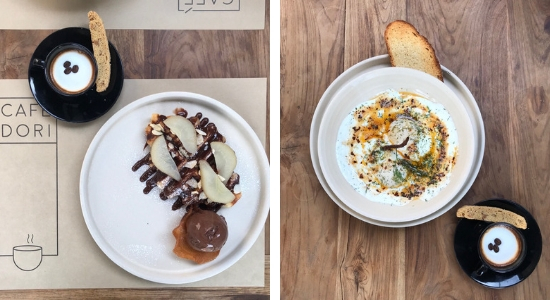
Chefs Kainaz Contractor and Rahul Dua told Restaurant India, Café Dori is a place for people who love coffee and want to come over to get their shot either to kick-start their day or come in at any time whenever they want a great bite and coffee. “It’s the coffee that drives the food and we want to take the European food experience to a different level here with our croffle (a croissant toasted in a waffle maker) with various toppings like smashed avocados, bacon jam and local brie cheese, the poached eggs with hollandaise (benedict, pulled pork, etc),” says Rahul.
Believe it or not, the best part about the café is yet to come.
At Café Dori, there is a certain emphasis given on coffee with many varieties of hot and cold brews. To top this all, the best part (as mentioned earlier) is that it is a pet-friendly place and they encourage their customers to bring their wildings in to dine with the family!
Café Connect
Located in the car market in South Delhi’s Vasant Kunj, you can just miss the place the first time unless you know where to look, even though it is right on the main road, and extremely visible with its vibrant board. The place is rustic and warm, and a haven set right in the middle of a dusty market. Chef Arinder Singh of Café Connect says initially they opened the place as a ‘tapri’ to serve tea and bites like bun maska, vada pav and some basic preparations of eggs in the morning. But, they grew so popular that they turned themselves into a café and are now contemplating even opening another floor to meet the growing demand for the place!
The café used to open at 8.30 am a year ago but since the beginning of 2018, they have shifted to opening an hour later 9.30 am to cater to the people around the place who begin to drop in around then. Café Connect remains packed all day, especially during breakfast and brunch hours, with students, professionals, neighbourhood folk. There are the senior citizens staying in and near Vasant Kunj, who would chat for hours over the Café’s famous masala chai; Café Connect has at least ten varieties of masala chai. Their bestselling items are the bun maska, keema pav, eggs, parathas and pancakes. The prices are very easy on the pocket as well - a meal costs as low as 200 rupees with a beverage.
Café Qahwa
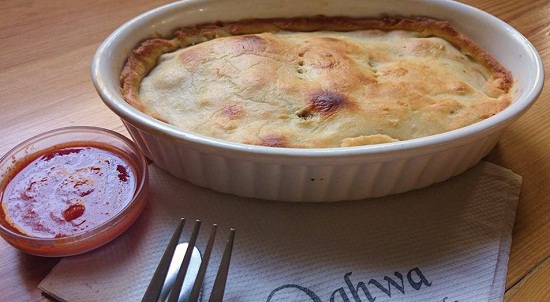
“The word Qahwa means ‘coffee’ in Arabic,” says the vibrant, young owner of the Café, Shikha Pahwa, “and the reason I opened this place nine years ago was because being a marathon runner and a coffee lover, I wanted a place to eat in the mornings and there were none around this area, in those days. So, I decided to give people what they want most … great breakfast and coffee options, especially for people into sports.”
Delving further into how she caters to sports’ people really, she adds the focus is on a healthy breakfast with a lot of bananas, eggs, honey and gur (instead of sugar). One of Café Qahwa’s most soulful beverages is the coffee with ginger and honey; it’s flavourful and soothing at the same time. Located in the prime market, opposite to the IIT main gate on the Outer Ring Road, Café Qahwa is full of students and young professionals since the wee hour of 7.30 am. The other very interesting part about the place is that it doubles up as a co-working space for which she has partnered with MyHQ. A smart business move as people could work and eat all day in any case; making it professional through a proper tie-up is a win-win situation for all!
Fig & Maple
Fig & Maple is another brainchild of Chef Radhika Khandelwal, whose first successful place is Ivy & Bean at Shahpurjat. When asked about her reason for opening Fig & Maple, she says that she really couldn't change her menu at Ivy & Bean because of the regulars there. In order to address her creative instincts as a chef, she wanted to start another café where she could try out new menus and dishes all the time.
Located in the prime GK2 M-Block market, it has two floors – the third floor and a stunning terrace. A lot of health-conscious people visit the café and the menu is green-based, with their signature dish being the fig and maple salad. The people’s favourite drink is the Mimosa, which is champagne with orange juice. The regulars at Fig & Maple are mostly the bowls and salads.
Chef Radhika adds, “Eggs and pancakes sell just as well as our fig and maple salad and the beetroot and chocolate shake is another bestseller, combining health with taste! At Fig & Maple, the average cost per person ranges from Rs. 1300-1500/-, inclusive of a drink.” The restaurant opens at 7.30 am. She tells that biker groups, early morning joggers and even working professionals who return after the night shifts drop in at Fig & Maple for breakfast meal.
Another USP at Fig & Maple is the goodwill library. People can take any book they like and take it home. The idea is that they would read it and come back with either the same book or bring another one to replace. Publishers are going to be rather happy with this Café!
Rose Café

The Rose Café is cosy place in Saket near the metro station with chic decor and terrace, offering light meals throughout the day. Its rosy, rustic decor adds to the ambience that is synonymous with the name and a homely dining room has recently been added by the owners at their backyard. The people’s favourites are pancakes, waffles, savoury waffles with bacon and eggs, preferred with coffee, gelato shakes and lemon cake. The Café has a curated menu for both summers and winters as specials, like salads and desserts with mango and watermelon in the summers, and soups with pumpkin mulled wine on Sundays and fresh strawberry desserts in winters.
The Rose Café owner, Tarini Ahuja says, “The dishes started with food we eat at home and family recipes (shepherd’s pie, bacon wrapped chicken, pasta, waffles, cakes, etc) and then we slowly added dishes we enjoy and the cuisines we were looking for in Delhi but couldn’t find it anywhere, like the German sausage platter, homemade gelato, light risotto, and so on.”
The café is frequented by families, a young working crowd, college goers, and others. Upon asking about the early closing hour for the café, Tarini says, “When we first opened, we used to close at 7 pm we then extended it to 9:30 pm. Our original plan was to be an all-day cafe and close in the evening but our regular guests kept asking us to increase our timing. So, we moved it further to 9:30 pm, making the place an option for an early dinner.”
Social
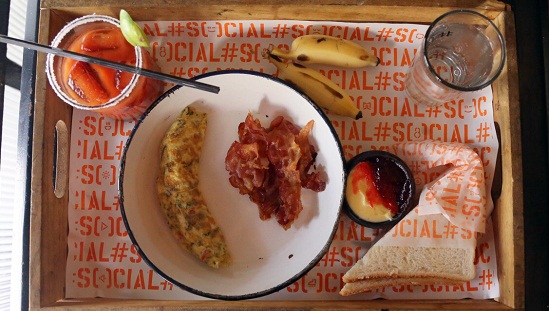
Social at HKV needs no introduction. This place has been extremely popular for its food and cocktails from day one, but did you know that Social also has a spectacular all-day breakfast menu as well?
Located right in the middle of the ever-buzzing Hauz Khas Village, Social is not your typical breakfast place, but has an all-day breakfast menu, which is well-known to its regulars, but maybe not to the masses yet. Generous in its portions at pocket-friendly rates, Social’s eclectic and quirky range of breakfast is served with a large helping. The signature Breakfast Trays are really good and just what the doctor recommends!
Be it the pancakes, sausages or crispy bacon – you can get all that you want at very reasonable costs at Social. But the best is the unorthodox things that they do there, like the fried eggs topped with maple syrup and quirky bites, as sliced bananas dipped in French toast batter and drizzled with toffee sauce. For health freaks, they serve assorted fruits, yoghurt, granola and muesli to keep up with their fitness regime, so no one needs to fret once they are at Social. The price for a meal averages to about Rs 600-700 per person, inclusive of a beverage.
So, for South Delhi folk, there are now six big reasons not to skip the most important meal of the day!

Mahima Purohit has always liked healthy food a lot. After studying advertising and management she started working with The Economist in the retention team. “I was at Fort, Mumbai and there wasn’t anything healthy to eat at the lunch hour,” remembers Purohit who was struggling to get something healthy and lite on the stomach. What best the young lady could is walk to the closest Subway and that wasn’t much of a relief because I didn’t get what she was looking for. That’s where she felt that there was a gap in the market for healthy food options to be made available at fairly healthy prices. Excerpts from the interview:
How it all began?
I quit the job and spent quite sometimes studying about salad. At that time in 2012 there was nothing easily available at the salad space and there was no information available about raw foods. I went to Newyork to study salad bars and there I got how raw food can be made tasty. That’s when I came back and put up Food stalls and approached canteen which was tough as everyone wanted to associate with a brand. I had fresh salad options and healthy foods made on the counter which I would display and get tasted at office canteens and I had no idea how Indians will react to it as eating salads as a complete meal wasn’t a trend. I tried to put up stalls at top companies including Mudra Group, few banks in BKC and that’s how we got a very positive feedback from a diverse customer base and they wanted to know where the store was and at that time we didn’t had a store. That’s when we had to tweak the menu with the customer feedback and came up with a more elaborate menu. We started our first store in Versova in 2014 and then expanded to Lower Parel opening our second store which is more like a cloud kitchen.
How are you trying to break the myth that healthy can’t be tasty?
We started with 5-6 salads on the menu. The main taste comes only if your produce are absolute fresh. We started sourcing fresh ingredients from local farms and made in-house dressing and toppings to add extra taste on the salads. And, beside that we added product which complete meal options. We added, Quinoa, khus khus, beans changing the whole perception about salads and having it as a whole meal options.
From where did you get the investment to start the venture?
It was a mix of two things. I used my savings from the job plus my father helped a little. We together invested around 5 lacs to setup the first store.
How have you changed your model from a sit-down place to cloud kitchen?
We started a place wherein people would come, sit and dine-in but over the last few years there is a transition where people are ordering food at their comfort. It is more of a delivery store. Around 70-80% biz comes from online platforms because of which we started our 2nd store in Lower Parel on the cloud kitchen model.
Who are your regular customers?
A typical customer at salad days is 25-40 years of the age. When we started we thought women would be more interested in the concept but surprisingly it is an equal proportion of male and female, people who care about health and witness.
What about the price range?
We have meal and snack options available at different prices. The snack options start at Rs 110 and goes upto Rs 220. Whereas, the meal option starts with Rs 160 and goes up to Rs 250.
What is the average order value and the ticket size?
It varies from day to day. For a typical restaurant Saturday, Sunday works as a high footfall day but for us it is opposite. We get 50-60 orders during weekdays with average ticket size of Rs 250-280.
What is your plan expanding Salad Days?
In Mumbai, I have plans to expand to Powai, Colaba as these area are respected to the kind of food that we are serving. Also, we may look at expanding to Pune in next two years.

Every year, the food industry is hit by a number of trends that changes the consumer taste and preferences. Sometimes these trends are queer especially when parts of the world get crazy for cheese tea or cotton candy. But some of these trends are just perfect. They are health-conscious, celebrate farmers and producers, and they always manage to look just so yummy while being healthy on the plates!
2018 promises to be another year like that. It is quite noticeable that people across the world now want gourmet food to be healthy and Instagrammable. Everybody is cautious about their waistlines, and so should you. But this does not mean any foodie has to compromise on taste. The world is full of innovative chefs, and they'll ensure that your plate is designed only with scrumptious food while being healthy!
“Preservation which involves salt fermentation, lacto fermented, wine fermentation – fruits, dried fruits, sweet roots and syrups; Minimalism which means Less is more; Table side interactive cocktails ranging from elegant martinis & doing the classic luxurious duck & lobster press; Fun tasting menu which is small yet experimental yet quick tapas style dinners; Test kitchen which incorporates research of the best from ingredients to recipes, develop and practice to serve the same on the plate for diners; Fresh pluck–Kitchen gardening from home to the fanciest restaurant; Sustainability– Save the environment for our future generation; Soul bowl–Easy meal in the bowl concept are some latest trends in the food industry,” shares Dhruv Oberoi, head chef of olive bar n kitchen.
Here are some of the positive food trends that have hit the market in a big way in 2018.
Healthy living: People have come to the astounding realisation that everything they put in their stomach has a long-lasting impact on their bodies other than the short-term effect of tantalizing their taste buds. The need for healthy food and neuro-nutrition is on the rise. Neuro Nutrition is a concept that boasts of healthy eating as a way of life. With mental health issues being increasingly addressed, the right kind of eating will also gain preference over junk. Plant-based foods will flourish the market, with many restaurants and delivery chains offering an array of wheat & oat based products. Zucchini pasta and zoodles and other plant-based dishes are definitely taking over the market with health-conscious people on the rise. With more people dying of obesity than of starvation, this is a positive change we're expecting in the coming year. Salad Story and Pita-Pit are great examples of chains already practising this.
A Big Yes To Mushrooms: The world has finally realised the several benefits of mushrooms which includes their versatility, nutrition value and stronger immunity. Don't be surprised if you find more mushroom dishes on restaurant menus. Just lap it up, and enjoy the benefits. “Plant based diets have become more popular for multiple reasons such as environmental sustainability, improved overall health, economic and ethical reasons. As our population expands, scarcities in water, agricultural land, forest, fishery as well as nutrients and non-renewable energy become major problems. The use of edible insects as food is being considered more and more. According to the Food and Agriculture Organization (FAO), these insects contain high quality protein and vitamins which are useful for humans as environmental resources become scarce.
Zero kilometre: there is a growing trend for dishes created with ingredients sourced within walking distance. Farm to fork concept will create greater awareness and responsibility about the impact of food consumption on the personal, social, economic and environmental sphere is highlighted. it seeks quality consumption in which enjoyment, balance, sustainability and accessibility predominate.Doughnuts with unique non-traditional filling will be seen in future time as a trendy mark in all establishments.Rolled ice cream made on the cold slate with lot of fillings and topping is one of the greatest trends can be seen in future. Ethnic inspired breakfast foods will be trendy in this coming year,” shares Vaibhav Bhargava Corporate Chef, Yuvi hospitality, Molecule Air n Bar and The Drunken Botanist.
Pancakes back on the plates: Who doesn't like to eat pancakes, waffles, cheesy omlettes all day long? Changing preferences and craving breakfast dishes all day is making restaurants switch to providing breakfast options all day long. There are people who crave for waffles at 1 am at night though they are well aware of the fact that waffles are a breakfast menu dish. Now people can enjoy hot pancakes at any hour of the day since restaurants are finally serving to this noticeable shift in people's choices.
Return to the Roots: This year will witness people going all the way back to the roots and to grandma cooking. A lot of chefs are joining the bandwagon of old school recipes and heritage millets because of 1) food crisis has been intensifying and 2) people are looking for lifestyle changes. Millets like jowar and bajra will be used in cakes, cookies, muffins and crackers extensively this year. Fermentation will also take up a lot of space on the menus.

It is correctly said, “Health Is Wealth.” Healthy eating means eating a variety of foods that gives you the correct balance of nutrients you need to maintain your health such as protein, carbohydrates, vitamins, and minerals. Adequate nutrition intake is important to everyone and is an excellent way to help your body stay strong and healthy.
“Prefer salad for every season and every reason. Healthy eating is not just the food, but the art of eating. All the nutrition must be consumed in the right quantity at right intervals,” says Ranjan Agarwal, co-owner of Salad Chef.
Today consumers are looking back in time when healthier eating habits were followed. The demand for natural and herbal products has increased dramatically in the global health and wellness food market. There is an increased health consciousness and emphasis on preventive measures. Let us read how motivation, abilities and environmental opportunities play as factors determining healthy eating.
How it Motivate?
To develop an understanding and analysis of consumers’ motivation factor, perception, and preference is important for the food industry. The factors that influence motivation for food choice could be an interest in health, weights concern, sensory pleasure, ideological reasons, convenience, price, or familiarity. Numerous studies have pointed to the primary role of taste in determining the food choices of consumers. Consumers also rely on the mass media for relevant information, and the media affects their purchase decisions remarkably. The mass media are often a source of information about food, nutrition, and health, resulting in beliefs and attitudes about the healthiness of different foods. Today, when consumers make food purchasing decisions they keep in mind the health-related attributes of food. This trend led to the growth of organic food sales because organic food is believed to have a higher nutritional content. “Self-image is one of the main reasons for the motivation behind healthy eating. People have realized that good health is related to nutritious food. Today people have adopted Indian ways to stay healthy and have migrated towards our cultural roots,” says the famous chef Ranveer Brar.
Self-Focused
Self-efficacy refers to the perception of, or confidence in, one's abilities and skills to engage in certain behavior. A person who is confident and determined to cut back on the saturated fat intake will be more motivated to do so even when faced with certain barriers. Self-efficacy is strongly related to abilities and skills. Skills and abilities are dependent on practical knowledge. For example, knowledge of healthy alternatives for unhealthy choices helps to enable voluntary dietary change. Awareness of personal intake levels is another important ability-related factor. Caloric intake and expenditure are determined by specific acts, from choosing foods, portion sizes, and preparation methods, to transportation, work and leisure time physical activities, it takes a great deal of food knowledge and good arithmetic skills to monitor one's calorie intake or day-to-day energy balance. “We are focusing on bringing in cooking methods that involve less fried dishes, less sugar, and less oil. Oil-free cooking is our future goal,” shares Raj Juneja, owner of Warehouse Cafe.
Giving back to the Environment
Here, the environment does not mean trees or plants. It refers to every setting we are in daily, from our work to our home to our car. Besides that, environment can also mean any family, friends, or health challenges that affect health and wellness goals. A study suggests that family and friends can trigger good or bad eating habits. For instance, if your friends are ordering healthy food, you're more likely to do that as well, but the reverse can be true too. Rakesh Agarwal, Corporate General Manager at The Salt Kitchen & Bar sums up the article by saying “Health is the most important thing that a person should take care of. Leading a healthy lifestyle leads to happiness, success, and achievements. Start eating healthy food and add the same to your routine.”

In a world where people are constantly moving towards preventive healthcare, healthier food options are what they are going for. In fact, a recent study concluded that over 47 percent of Indians prefer their food to be healthy and these numbers are only increasing at an astonishing rate.However, there remains this ongoing clash between the need to opt for healthier options and at the same time the cravings for mouth-watering junkies. And Wok To Walk provides the perfect resolution with its scrumptious but healthy meals. Wok to Walk had set its foot in India towards the end of last year through a master franchisee, has already set up three outlets in the last six months and is looking to expand through a mix of own outlets and sub-franchisee route.
In conversation with Gautam Kamra, General Manager (Operations), Wok To Walk India, about the chain, its USP and its expansion plans in the country.
Tell us about Wok to Walk, its inception and the journey so far.
It is a story of adventure and exotic flavours. Few years ago, on a journey in South East Asia, the promoters found their passion: Asian street cuisine. Back in Europe, they spotted a need for that authentic experience. Hence in 2004, the promoters created their own version of the rudimentary street kitchens they had fallen in love with. The concept was simple –giving customers total flexibility and involving them in the cooking experience through the use of open kitchens. The first Wok to Walk restaurant was so successful that it soon started to pop up in the coolest spots of many European cities. So, 14 years and 90+ restaurants later, Wok To Walk is the No. 1 wok kitchen chain in Europe. Authenticity, together with the simplicity of the concept, is the secret recipe to Wok to Walk’s international success.
What makes Wok to Walk any different from the other food joints? What is its USP?
Wok to Walk specializes in custom made, fresh, nutritious and quick stir fried Asian cuisine. We pride in offering, quick wok meal prepared in less than 5 minutes, freshest ingredients which are sourced and used, healthy food options with no MSG content and option to have infinite combinations in one box.
Tell us about the food options offered by Wok to Walk in India.
Wok To Walk India offers vegetarian, vegan as well as non-vegetarian options.
Did you curate your food options in order to suit the Indian consumers and their tastes?
Wok to Walk has taken cues from customer feedback and has responded to demands with new menu additions to suit Indian taste preferences. Recently, dim sums, Famous Flamers and Hot Wokkin Treats, made with our new Mumbai sauce were launched successfully for our Indian customers.
Who are your target consumers?
Wok To Walk can be enjoyed by anyone, anytime and anywhere. We believe our customer segment is aged between 16-35 years.
What do you think of Indian market in terms of accepting this new concept? We already have Subway and the likes offering fresh salads in our sandwiches...How will Wok to Walk pose a competition in this segment?
In this digital age, Indian market has become extremely receptive to new concepts and healthier choices. Our USPs including customization of Asian meal, no MSG and quick preparation time put Wok To Walk in a completely unique category and we don’t see any direct competition in this domain. Customers wanting to have their Asian food fix right away, at a price they want to pay and exactly as they like it are going to be the real Wokstars for us.
Meanwhile, we also have grocerants coming up for quick food options, almost an alternative to fast food options offered by restaurants. How do you see them as competition? How will you cope?
Wok to Walk boasts of fresh and healthy meal that’s cooked in a live kitchen right in front of the customer. This is what differentiates us from grocerants and other such models.At Wok to Walk, customers decide what they eat and how much they spend, playing with the 3-step-menu (base, favorites and sauce). Total freedom for a perfect meal! One is free to eat in or take away the meal. The MSG free meal is cooked in a fiery Asian cooking show, on the spot, in less than 5 minutes.
Tell us about your retail presence.
Currently, there are 3 Wok to Walkoutlets across Delhi NCR.The master franchise plans to have 60+ outlets across India, by the end of 2022.
Tell us about your marketing strategies. What percentage of your overall revenue goes into marketing and promotions?
The brand is spending heavily on digital marketing to connect with its relevant target consumers.Significant part of the budget in future will also be spent upon activities driving online deliveries for Wok to Walk.

The wellness trend is changing drastically across the globe, shaping and structuring the mentality of customers in different ways. Due to changing expectations towards their favored food brands, it is emerging as one of the important challenges for restaurateurs. The wellness and nutrition trend is so in demand that it is causing the restaurants to change their way of action keeping the customer’s expectation and demand in mind.
Millennials in particular are leading the charge by promoting health-conscious diets which are both beneficial and tasty. Considering health as an utmost priority, millennials are forcing the restaurants to come up with different concepts offering healthy and nutritional product that they love to eat. Hence, restaurants are introducing more and more vegan and green diets into their menu, satisfying the customer’s need. The restaurants are willing to cash this trend which they believe is here to stay. According to a report, it is believed that 1000 men and women between age 20—30 are shifting towards a healthy diet and the rate is expected to rise more in the upcoming time.
A report of USA Today stated that almost 30,000 consumers in more than 60 nations believe that the Millennials are the most health-centric group in the world. More than four out of ten people indicate that they are willing to spend more money for healthier products and cuisines. Thus, the market for health and nutritional enthusiasts is expanding creating awareness for a healthy lifestyle. A sense of mindfulness can be seen in today’s customer that enables them to ask questions about the origin of food, the ingredients and even about the process it is being prepared. It clearly states that they are very much concerned about their health and about the impact caused by the nutrition in food.
People are now more conscious thereby making them explore various foods’ which helps and increases brain health, sleep, and stress. They believe that it is better to invest in healthy foods fulfilling their hunger and meeting the basic nutritional level both at the same time. “We are providing people to select their own ingredients. By this way, transparency is provided to our customers who are generally health conscious. We are trying to provide the nutrititive value of food in front of the people,” says Gautam Kamra, GM, Wok To Walk.
Infusing Technology
Innovating technologies like fitness trackers and calorie counting applications are also contributing towards making health and wellness a more personal thing. With presence of such applications in the market, consumers are able to learn more about foods and ingredients which are beneficial for their health.
A sense of mindfulness can be seen in today’s customers that enable them to ask questions about the origin of food, its ingredients and even about its preparation process. In order to participate in the growing market, many restaurants are now serving and preparing the food to maintain transparency in front of their customers.
“Customers are willing to invest in brands which are providing them transparency while catering. Millennial’s expectations have certainly revamped our way of working in the industry. We as a team try to provide transparency at our restaurant so that this huge crowd stays satisfied,” shares Simant Tyagi, Co-owner, Hyjack Restaurant and Bar.
Not only this, a restaurant named Habit in San Francisco is one such example for personalized nutrition business. The brand dragged attention in the year 2016 when a company named Campbell Soup Co. invested about $30 million in the brand. The company required users to submit their blood samples for review. Based on the results, the company developed a personalized nutrition plan for the user. They made sure that personal wellness is as important as consuming great food.
In India, it is just the dawn of the personalized nutrition market and not sure which kind of business model will succeed. The only thing clear is that it will surely attract consumer’s interest as the market builds momentum with time.

A mash-up of ‘Culinary’ and ‘Curate’ Culinate was started by Rajiv Kumar three years back when Culinary to him was science of putting together stuff (High quality, sustainable, Ingredients in our case); Curating an art of finding recipes from across the globe, match up with locally available ingredients and deliver an authentic, awesome experience. The brand has now grown to 5 outlets expanding wings to Noida and Gurgaon.
How are you different from other delivery players?
We are a ‘Delivery Only’ outlet so far. Unlike a food ordering service, we are invested in the entire value-chain. From variety to quality, to delivery, everything is controlled by us that creates an amazing experience. Food travels through word of mouth faster than expected thus organic growth is our first strategy. Our customer service matrix looks for hack growth through prompt users to refer at key moments like when they love our food. We have our own APP and gels well with our TG, who's middle to senior level executive, conscious of his health, not so much on price point.

You are serving cuisines from 6 continents and a menu with a spread of more than 250 dishes. How difficult/easy it is for you to come up with the orders as you are serving multi-cuisine?
We always wanted to be a multi-cuisine delivery kitchen, offering light, nutritious and wholesome ready-to-eat meals to our customers and our differentiation is the ease with which we manage the enormity of our menu and offer choices to our customers. While designing the menu we looked for inspirations from across the globe and found some tricks that would efficiently help us manage a menu this big. We innovated a lot and worked on standardization, backend technology, and demand prediction.
We see there is a sudden rise of gourmet food in India and it is not restricted to fine dining anymore. Why so?
A lot of credit goes to the customer of today, who is well travelled, well read, not afraid of trying different cuisines, challenging their palette. Also, the advent of TV series like Masterchef has has exposed India to global cuisines. Gourmet is no longer a niche, it is fast becoming mainstream, at least in larger cities and online ordering is democratizing the process of ordering On-Demand food. Fine Dine is still restricted to a chosen few, with people visiting Fine Dine establishment on occasions. Gourmet delivery is now associated with Fun dine, without the hassle of table reservations, long waiting hours, following dress code, fighting the traffic menace. Globally, “Dinning is the new Eating out” and Culinate excels in providing the experience to its new age customers.
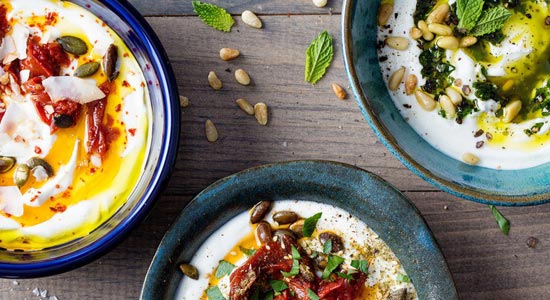
How are you trying to bridge the gap of quality and consistency in online space?
Consistency can be achieved through standardisation, use of technology, proper training and stringent control over processes. This has been a focus right from the beginning at Culinate. Our packaging has been appreciated by one and all, especially online space has a fundamental disadvantage, any issues with food/service can only be dealt with considerable time lag and that can be an arduous task.
How many orders you get daily on an average? What is the average ticket size?
We do about 350-400 orders a day from Noida and South Delhi outlets, we’ve recently opened Gurgaon, which should start contributing from April 2018. We aim to do 2,000 orders a day by end of FY 2018-19. Our average ticket size is Rs 400.
Tell us about Culinate-on-Wheels and Culinate-On-Greens. How is the response?
Culinate on Wheels is unique collaborative marketing platform for us. We have collaborated with RWAs, Corporates and Food festivals to offer them an exotic culinary experience at their doorstep. It is working very well for us so far. Whereas, Culinate on Greens is a utopian concept, focused on French Bistro style lush lawn with kids playing area and family dine-in area. The first Culinate on Greens is coming up in Noida Expressway and shall be ready by the end of summers.
What is the use of Ultrasonic Technology as you are one of the first adopter in the segment? How is it making the work more efficient?
Ultrasonic cleaning has been used in precision machines industry for very long. The concept remains safe for cleaning fruit, vegetables and meat alike. The need arose when we set up our Cold Pressed Juice plant. We had to look to keep the food produce pesticide-free, chemical-free, color-free and pathogen free. Thus arose the need for higher degree of ozonated water. We collaborated with a manufacturer that has patent pending ultrasonic based fruits and vegetables cleaning and decontamination machines. They built us the ozone bubbling and sonication machines that cleans and sanitizes food produce and also increases their shelf life considerably. Lab results have shown, the machine kills 99.99% of bacteria and other harmful pathogens in the food produce.

This machine also helps us save 25-40 litres of water every day thereby proudly contributing to the environment while cooking the most amazing cuisines. Our kitchens are steam cleaned 3 times a day. We recently scored one of the highest rankings on Zomato Hygiene ratings in collaboration with Equinox Labs. It is also published on our Zomato Page. So when you order from Culinate, you can be assured of a healthy, hearty, and exotic experience.
What is your plan expanding the brand both online and offline?
Culinate started with one outlet in November 2015, now we have 5 across Noida, South Delhi, and Gurgaon. It has been an exhilarating experience, especially being bootstrapped. Growing on Shoe String budget, without compromising on Quality and service, to 5 locations is very enriching. We have plans to open 5 more outlets in the coming Financial Year.

The best things always come unexpectedly and that’s how Chaahat Jain’s journey with CJ’s Fresh began. While interning with her brother Arjun Jain, Co-founder of The Grub Fest, the concepts of fresh, wholesome, and flavorsome food somehow arose a feeling of comfort in her. With intent to address a need, developing this comfort into a concrete business, came naturally to her. Realizing a lack in options for qualitative consumption, her journey started during January of 2016 and since then there was no looking back. Excerpts from the interview:
How did food happen to you?
Well I could take all day to answer this. Words fall short to describe the life of an entrepreneur. Ups, downs, laughter, tears, love, anger, stress, peace, and so much more is now all a part of life. However, to keep things short, in every entrepreneurial journey, the feeling of letting go will arrive endless times, the trick is- no matter what the hurdle, keep faith and never let go. Food happened to me out of passion that happened with time.
What’s the story behind naming it CJ’s Fresh?
Two alphabets that blend and a name that promises, CJ’s Fresh just clicked with the identity, and the purpose of the brand, eventually giving it the desired visual representation.
What are the design elements that popped up in your mind while setting up your venture?
Simplistic yet classy, with a calm peaceful and serene presence is how my go-to environment or design idea pattern has always been. With rustic, raw and earthy elements, the tone of the brand was heartfelt. We also wanted a circular logo, to assist as simple stamps, for describing our products.
How do you see the trends in the industry changing with time?
With a worldwide growing awareness around the parameters of health and consumption, people of our country are soon going to realize how they’ve been loyalists to scamming offerings. Soon the notion of quality is going to overtake quantity resulting in a deeper and stronger connection with the term wholesome and clean.
The menu looks as if it has a variety of things to offer. Tell us something about it.
Just like no two people can be exactly identical, the concept of comfort food cannot be a single type every day. In other words, a promising brand must comfort the needs of each and every. Being fresh and diverse, our aim was, is, and will always be to qualitatively satisfy the cravings that arise on any given day.
What is your take on introducing freshness and local ingredients in the menu?
Clean eating is the fuel your body needs. Local foods support the economy, the environment, have more nutrients, and most importantly promote a safer food supply. CJ’s Fresh has already initiated its own organic vegetable gardens, along with a switch to pink salt and healthy oils for meal preparations.
What are the various kinds of challenges you face while being in this industry?
Online platforms and nil barriers to entry, is definitely my top two. With a lack of awareness and high price sensitivity, educating the customer is a real challenge. The dominance of online platforms doesn’t make things better, barring in mind dominance also arises traits of negligence in ways highly unexpected.
What is the expansion plans?
For now strongly establishing my two outlets in South Delhi and eventually tapping East, West and North Delhi is definitely on my top list. While ensuring additions of more and more wholesome offerings and scrumptious surprises for our customer our aim is to be a one-click comfort stop-shop for each and every segment.

The saying 'New year, new food' certainly proves to be right. Healthy food is one trend which is on the rise this year. People have started demanding for healthy food packed with nutrition. Healthy food is certainly a roadmap towards future wellness and personal growth.
Eating healthy has become a new style statement for many people. Even many restaurants are coming up offering varieties of food products filled with healthy ingredients. Restaurateurs are now well aware and running with the trend happening around them. "Initially people were not so aware about consuming healthy food. But the things have changed since the past one year or so. We can see restaurants and people coming up with the desire towards catering and consuming healthy," shares Aaditya Pancharya, owner, TGIH.
2018 seems to be the year which is going to prove a healthy year for both the restaurateurs as well as the customers. Lots of health-conscious food trends are already prevailing in the market which is being loved by many people. People now want their food to be healthy along being tasty at the same time. The mentality has certainly changed where they are ready to pay a bit more for getting delicious yummy food.
Some health food trends
Plant-based dishes
Indian vegetarians and health freaks have certainly welcomed this trend enjoying the pleasure from the food they are getting. Zoodles and Zucchini pastas are here in the market and are doing really well catering to health-conscious people. 2018 is expected to welcome more plant-based dishes to satisfy the health-conscious customers.
Mushrooms
Mushroom has always been an important healthy ingredient. The world has certainly accepted this fact as the use of mushrooms in local food has certainly increased. From providing immunity to many other benefits, mushrooms are versatile as they are packed with nutrition.
Poke bowl
Japanese cuisine has certainly found its market in the Indian food industry. Poke bowl is one product coming from the Japanese concept which is extremely balanced in terms of nutrition and taste. They are already here in India and it is expected to see them in various menus of restaurants.
Regional cuisines
Many renowned chefs travel across the country trying and experimenting to put forth something new from the regional ingredients. Our regional cuisines have always been considered as very healthy and now the chefs are using them in order to produce healthy cuisines.
There are various ventures which are coming up with just providing healthy cuisines. Having a large menu, these places are becoming heaven for health freaks of the country. The entire idea is to provide people with cuisines which are healthy as well as tasty at the same time. The number of both the restaurant and customer is expected to rise by 22% in the year 2018.
"What you eat today is going to shape you tomorrow," shares Kunal Kotecha, Owner of Nutty world. He further says, the future will depend on how young generations are eating today. I believe that healthy today is a healthy tomorrow and people should start shifting towards healthy cuisines if they haven’t done till yet.”
With so many new healthy trends and foods coming up now and then in the market, Indian food industry is expected to get more hygienic and healthy in the upcoming time. Restaurants have started adding many items going with the concept so that they can meet up to customer's expectation.

One of the major food trend that our country has witnessed this year is the rise of millets again. Millets are so in demand that they are actually welcomed into the mainstream segment rather than anything else. Many restaurants are now trying to serve people with old orthodox form of millets trying to revamp it in such a manner that it meets their expectations. Many new millet dishes have been introduced which are being liked and preferred by many people across the country.
With changing time and eating habits of people, the restaurateurs have started to think that way. Serving something delicious as well as healthy has been one thing which is in demand right now and the food industry people are taking proper care about that. The demand from health-conscious people has certainly revived the use of millets in the food industry.
“We can now find a variety of food product based on millets in the supermarkets which are located near us including the products like sweets, cookies, and noodles,” says Sagar Sharma, owner of Nutritious Nation. He further adds, “The food industry is now slowly collaborating with millet based products giving rise to a new kind of flavor to old products which are made from millets. Even the various sweets are being made out of millets which are providing nutrition as well as taste to the customers.”
According to a report, ICRI Hyderabad has named millets as the smart food for this century. Initially, millets were regarded as a product which was only consumed by the poor people. But things have changed drastically. With the rise in diseases like diabetes, millets have found their way back into the dietary life of urban people as well. The millet industry has witnessed a rise of 32% by 2017 and is expected to grow by 60% by the end of 2030.
Many restaurateurs and chefs have started working with millets, as the demand for consumption of healthy food has increased gradually. Slowly millets are making their way back on the menu of many restaurants. But for the millet based products to work, the right amount of ingredient used in making it is very necessary. The item should be perfectly balanced in terms of nutrients being delicious at the same time.
“The certain rise in the demand and consumption of millets is not just a trend,” says Nitish Bansal. He further adds, “Millets are definitely making a comeback in the market and are expected to sustain more precisely this time. They are the ancient grain which comes with multiple nutritional elements causing great help to the body of the consumers.”
Millets being high in fiber, vitamin B, iron and calcium, act as one of the healthiest food available in the market right now. Their tendency of absorbing nutrients and minerals is extensively high which is why they are preferred by most of the people these days. Millets have always been the answer to every mother for a healthy and nutritious diet. Millets being a versatile ingredient which can go with many variants, they have certainly found stability serving a healthy diet among them.
Millets don’t usually have an independent color which might be appealing. But when they are mixed with other ingredients like black olive paste and others, they can surely come up with a good quotient. Millets are still in the process of getting accepted by the huge quantity of people as their ingredient in the dishes. But slowly and certainly things are changing which is resulting in the rebirth of millets in the food industry.
If you are also looking towards expanding your restaurant to another level, then it's the right time to let the world know about your brand. Participate in Franchise India Show, India's first ever Franchise reality show only on Times Now...
Register Now: Winnings worth Rs 5.2 Crore up for grabs
Click here for registration
Copyright © 2009 - 2025 Restaurant India.




